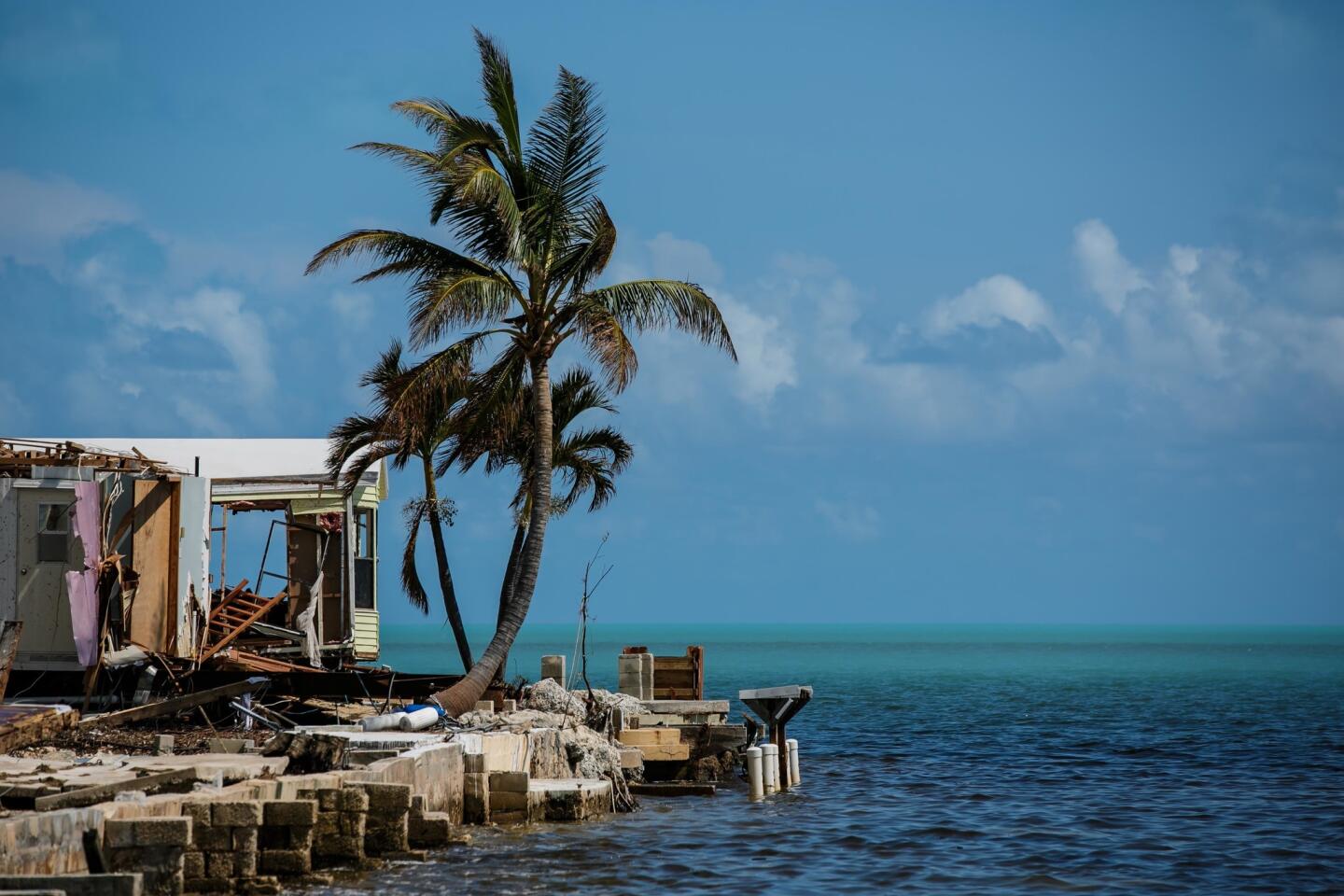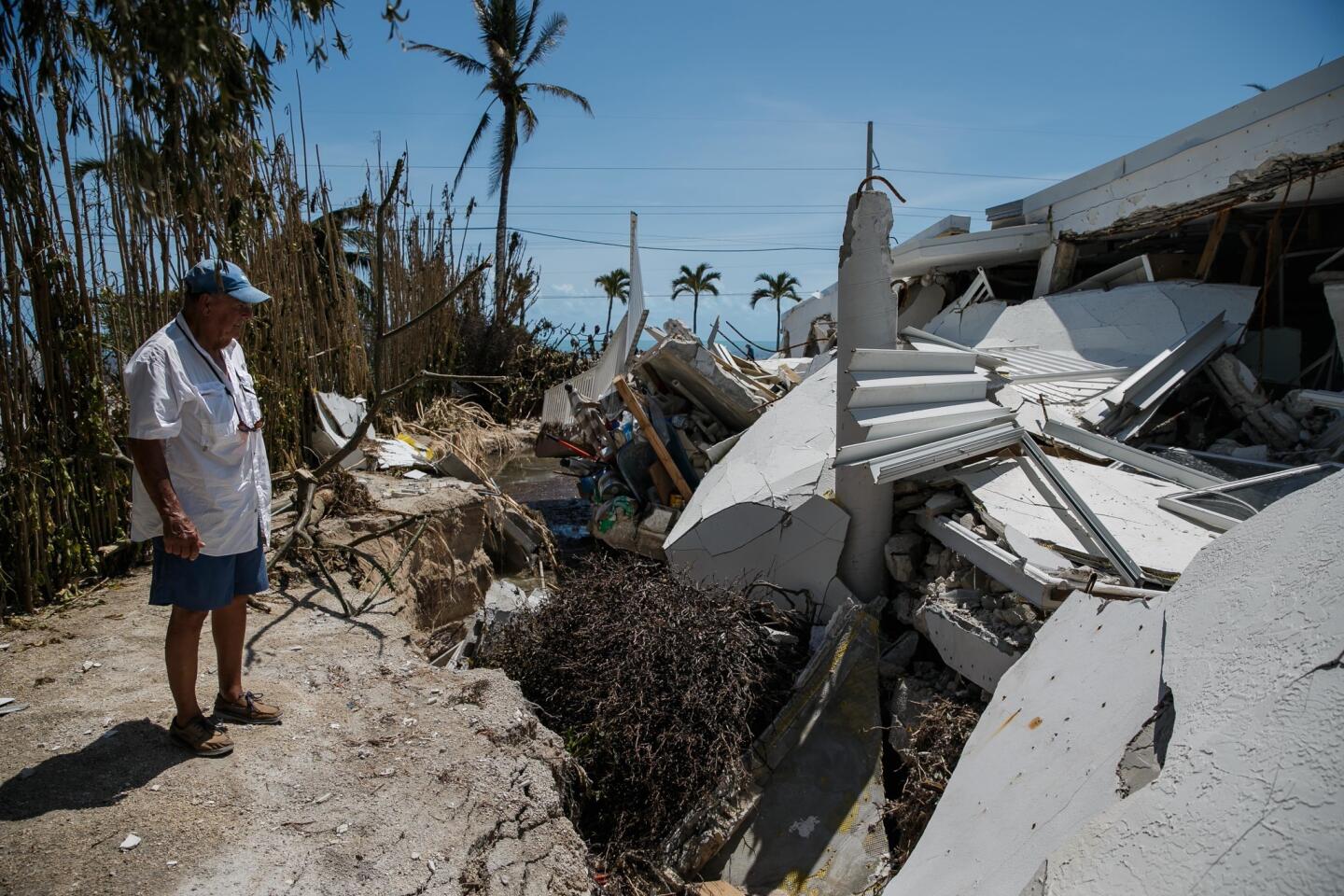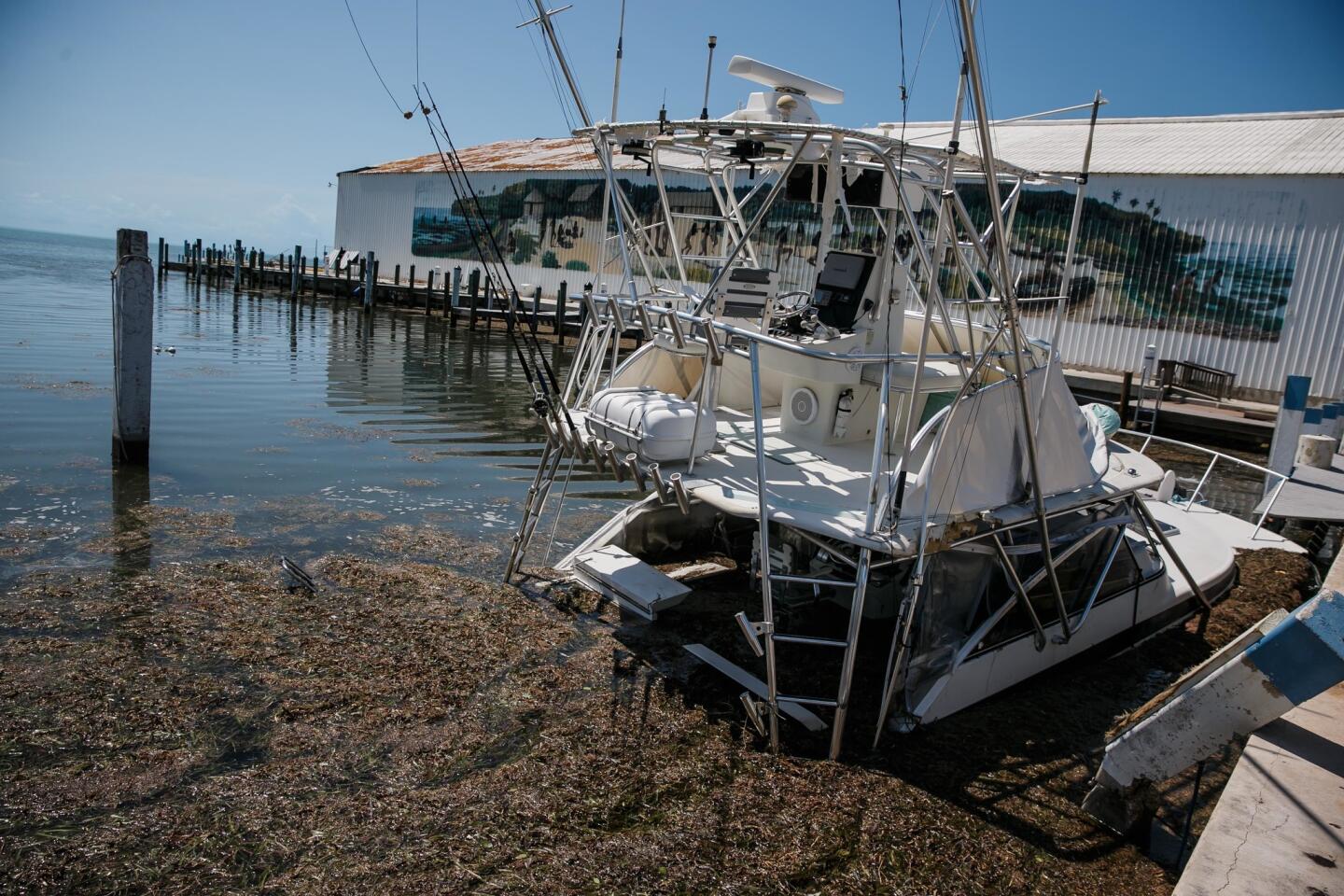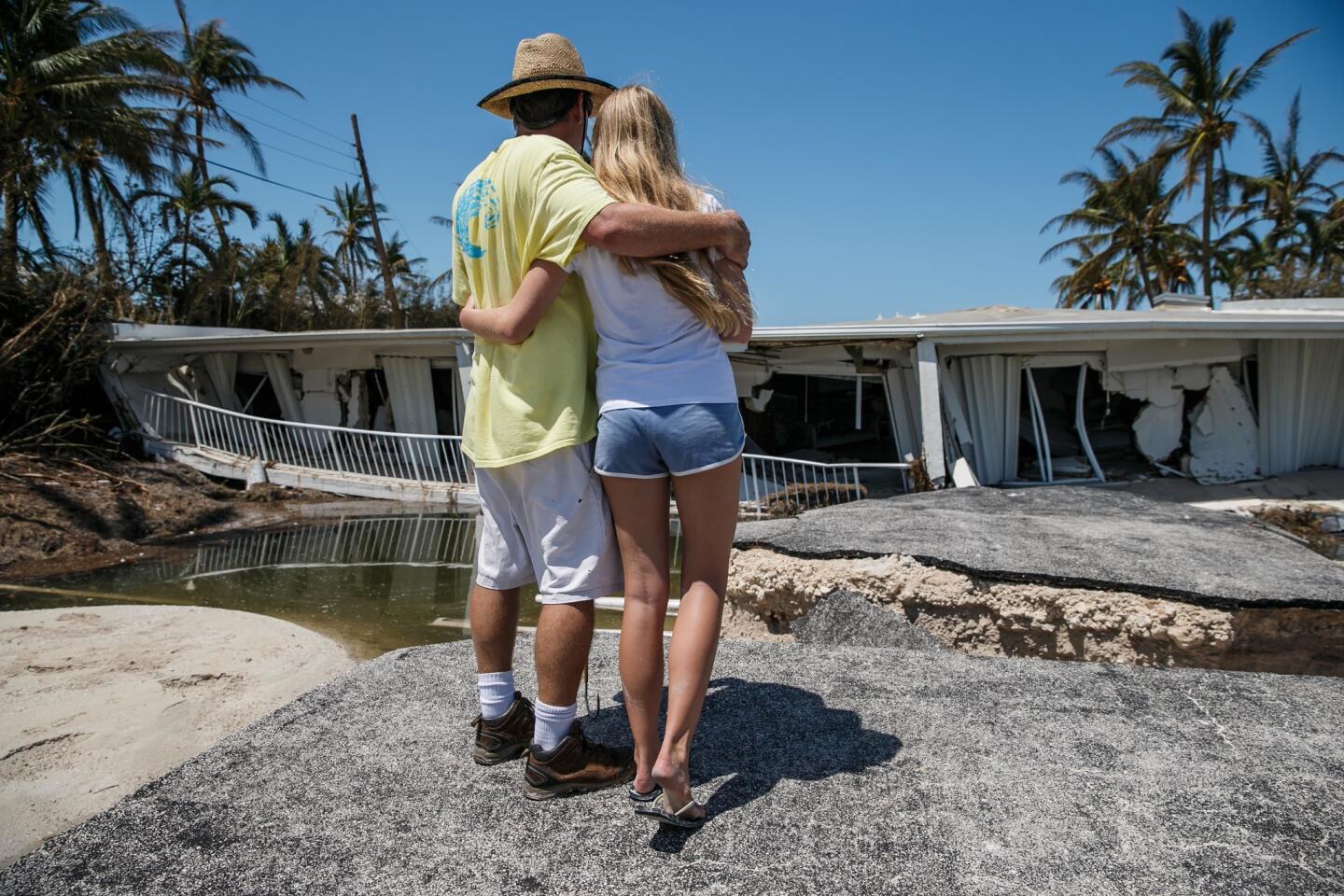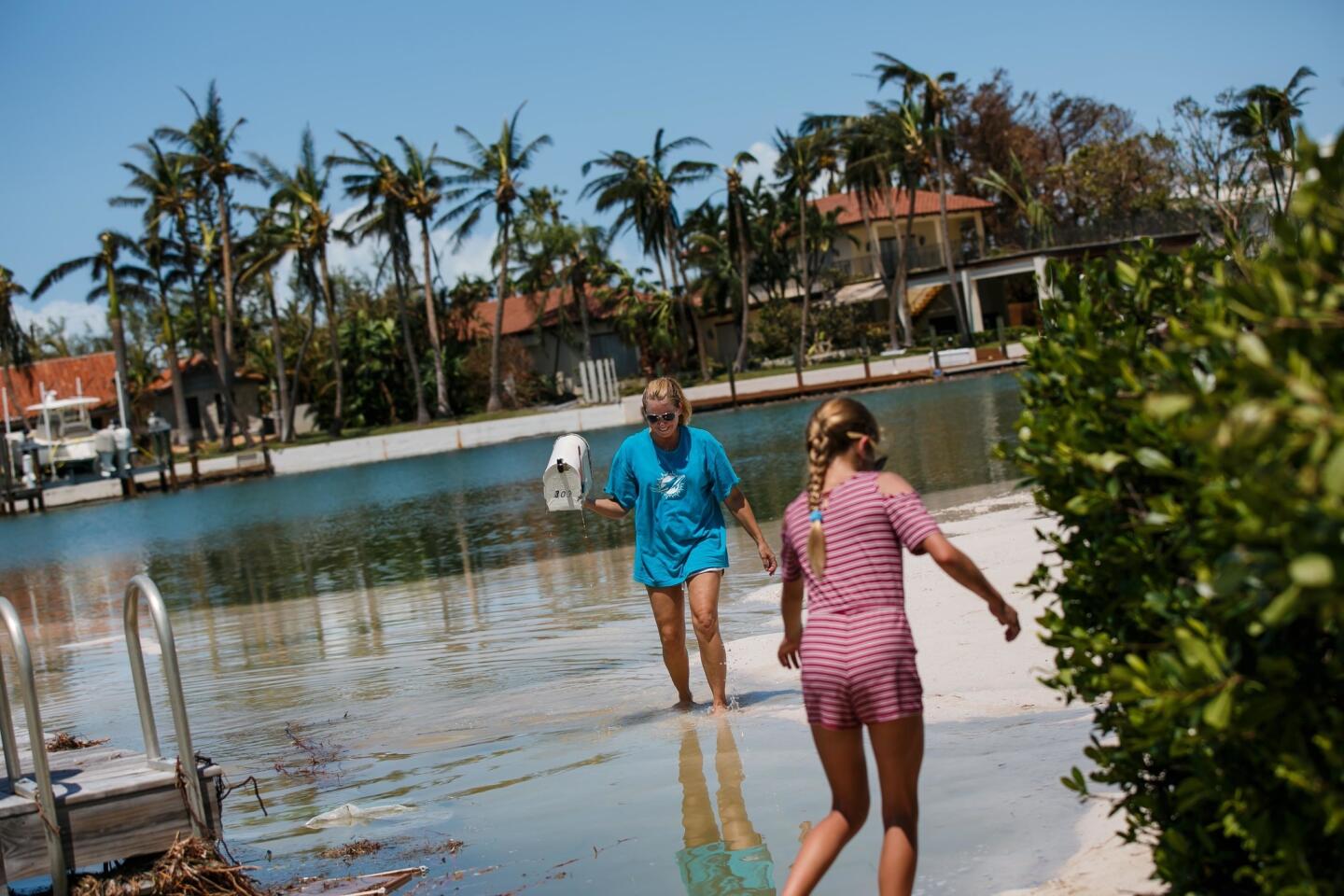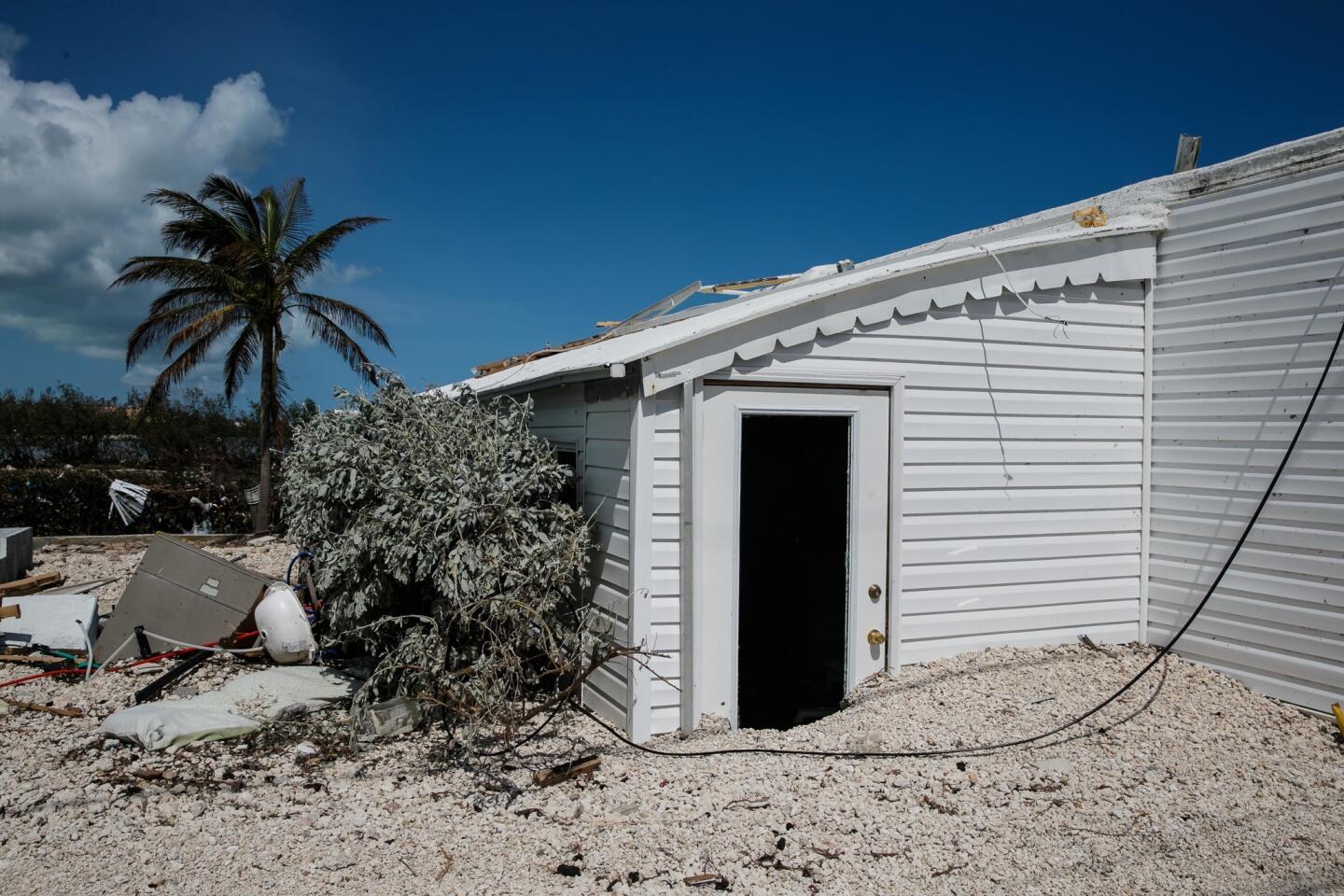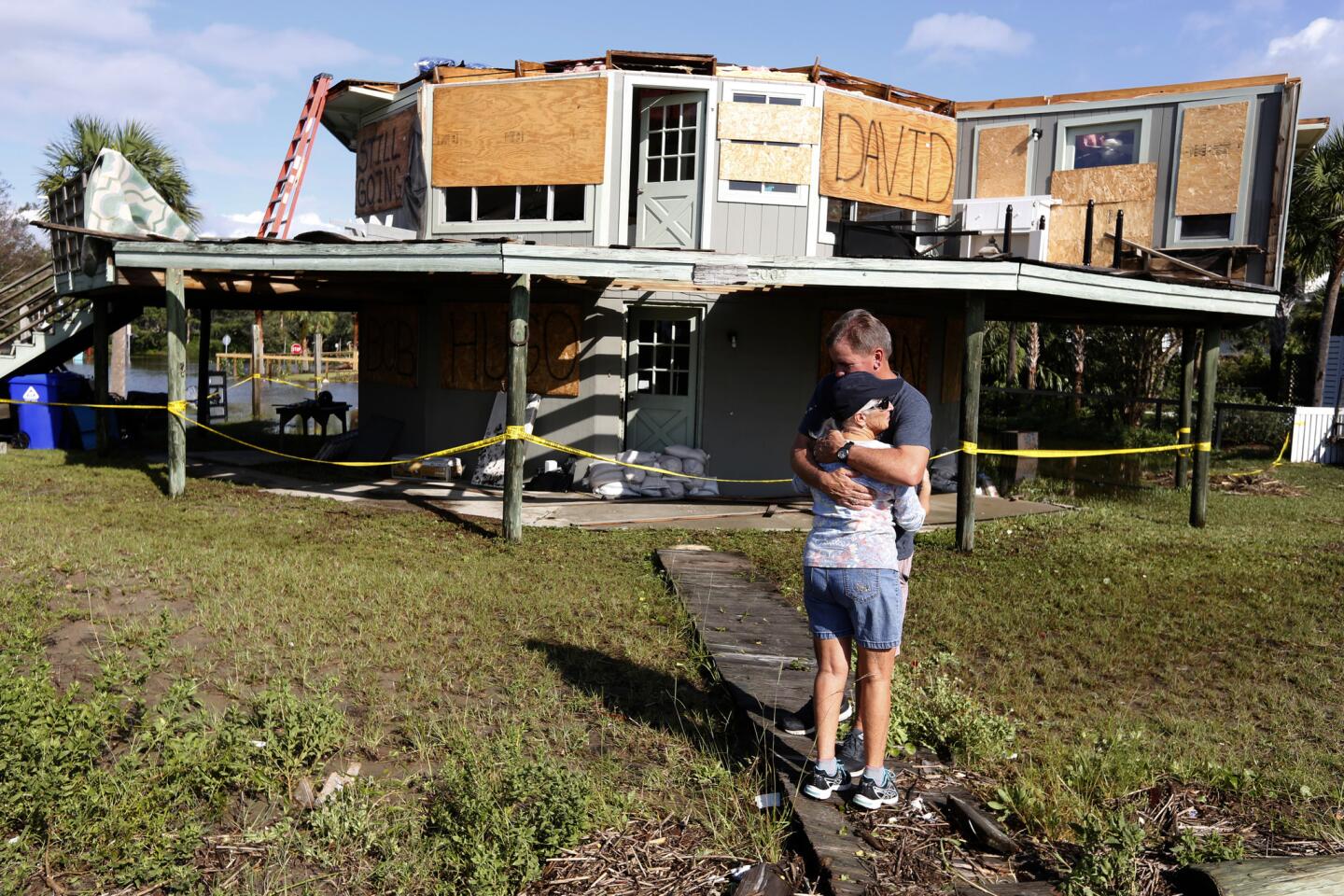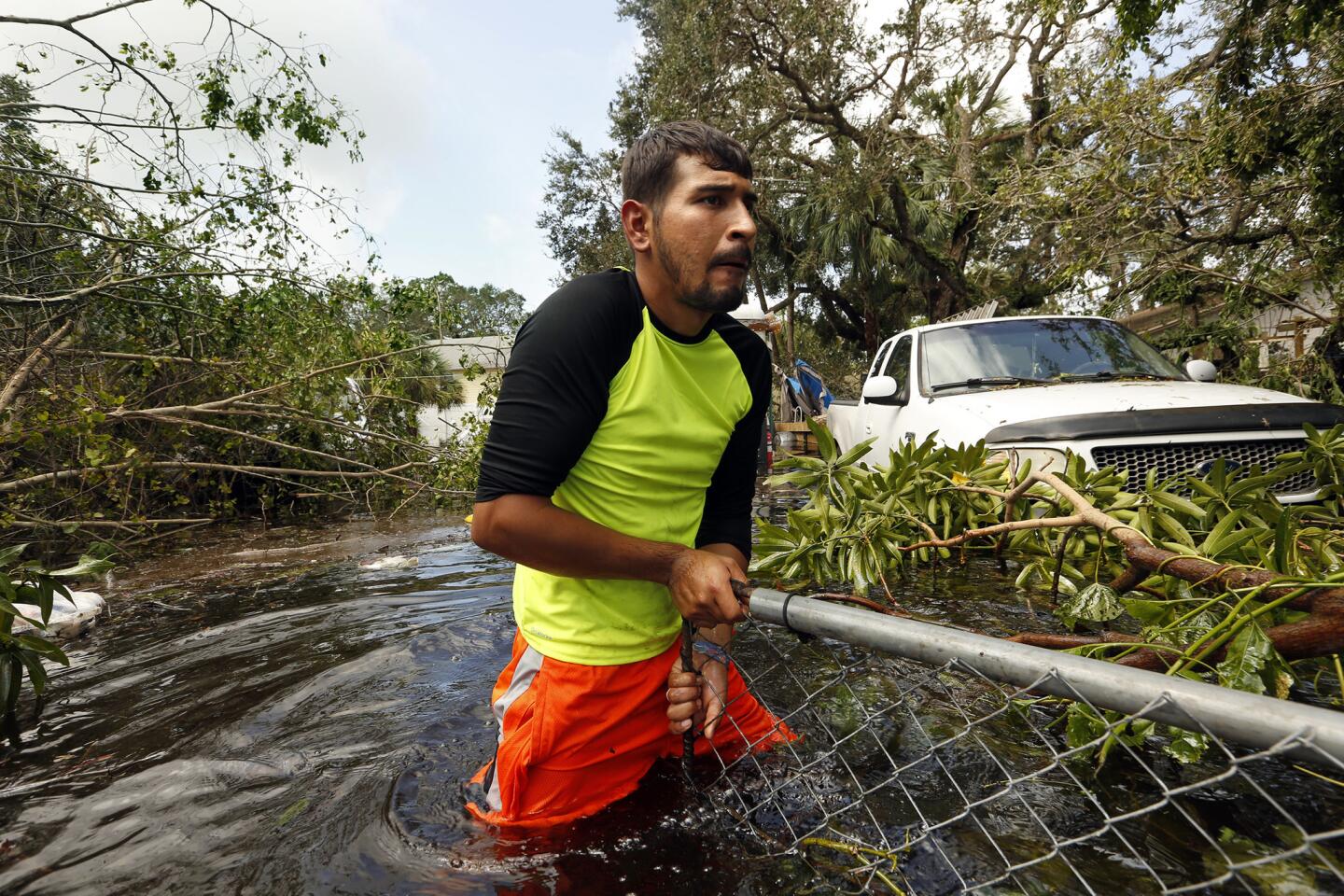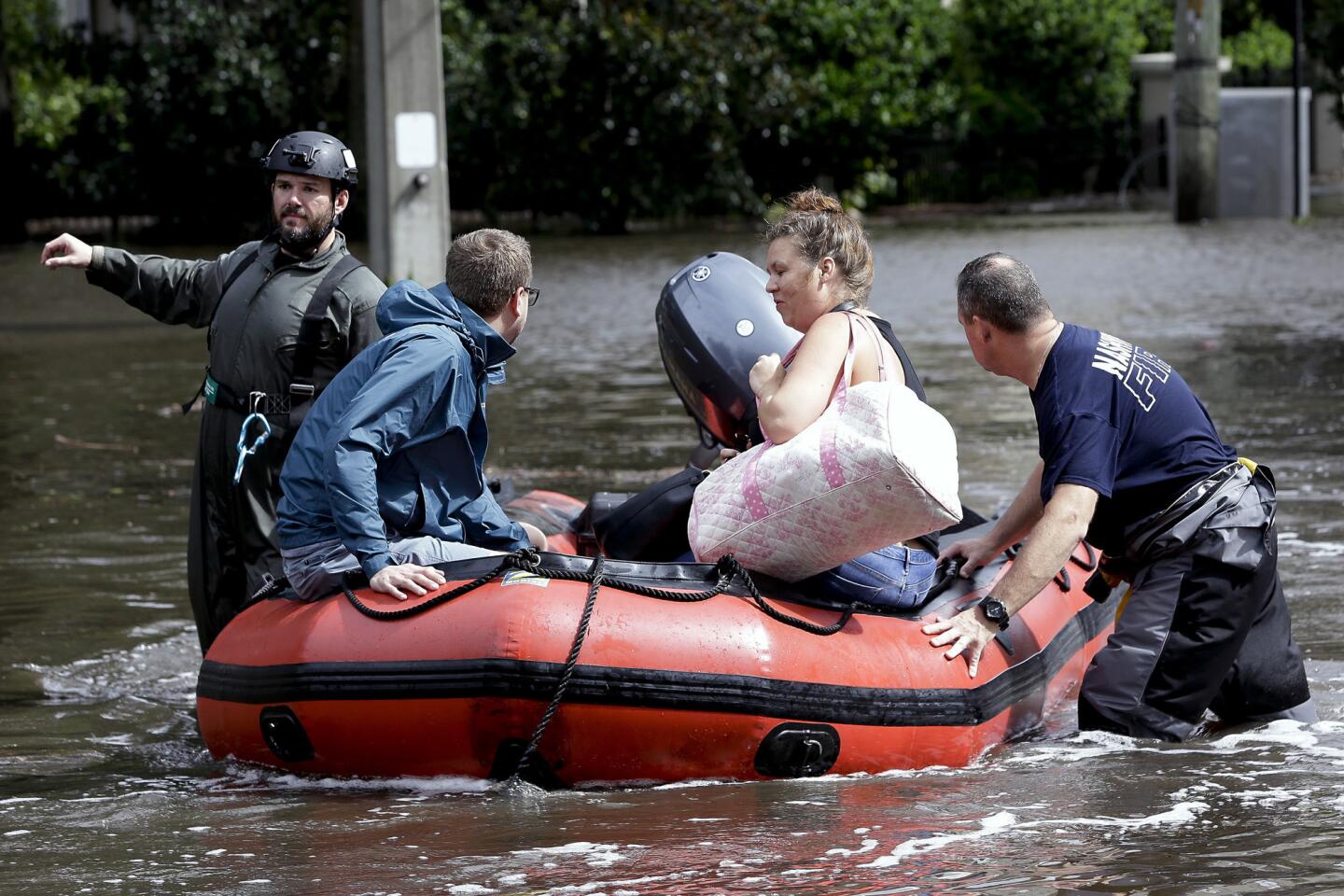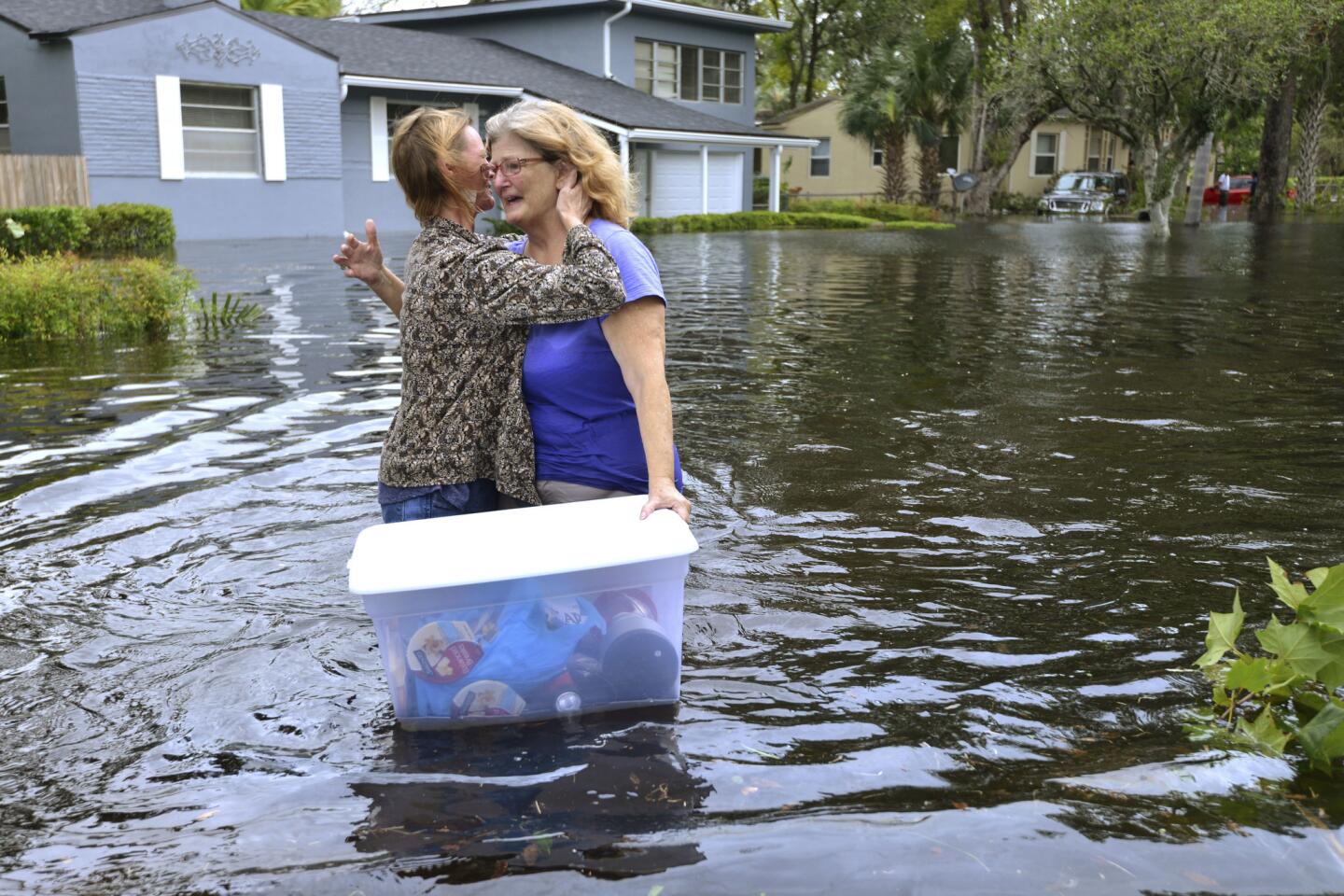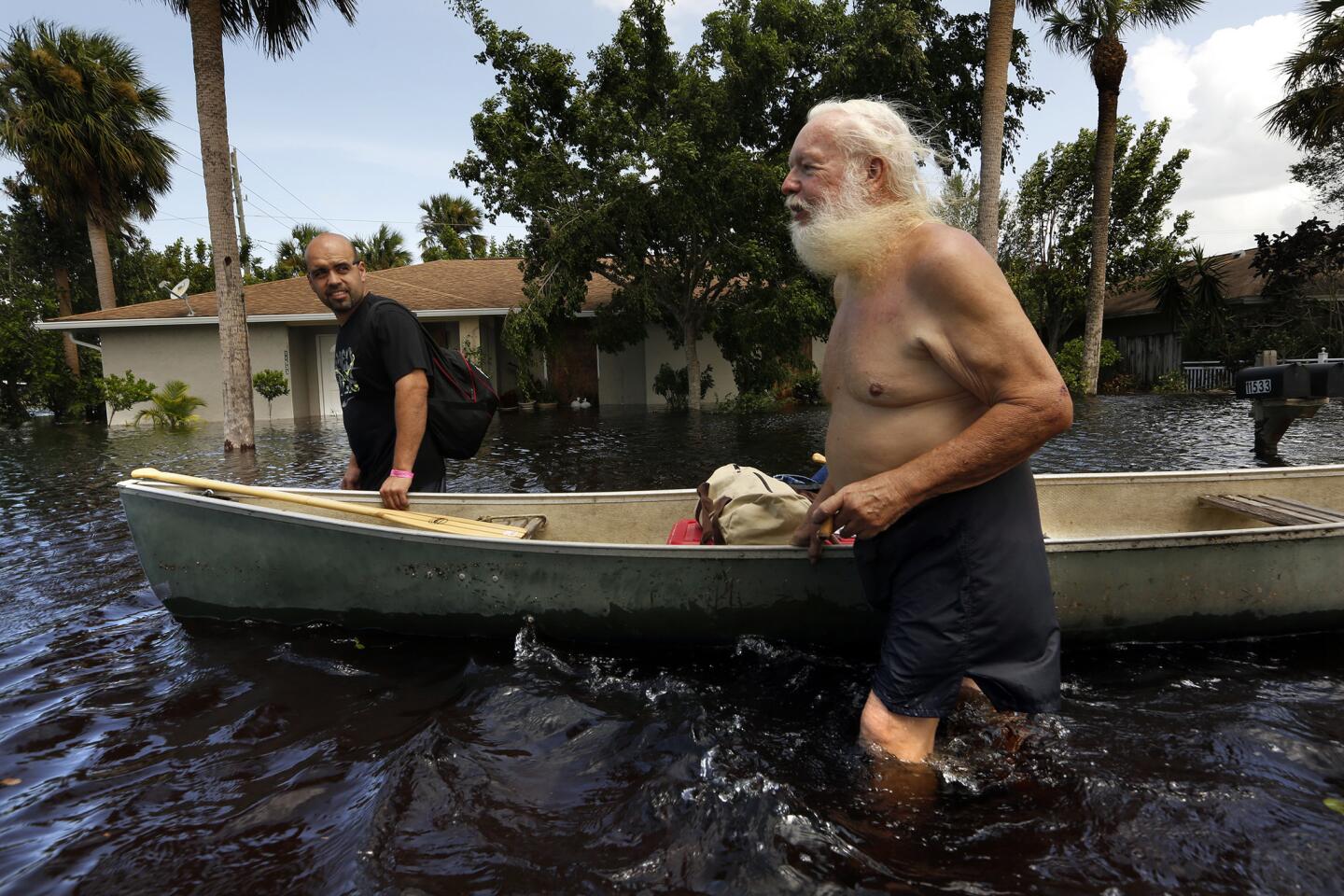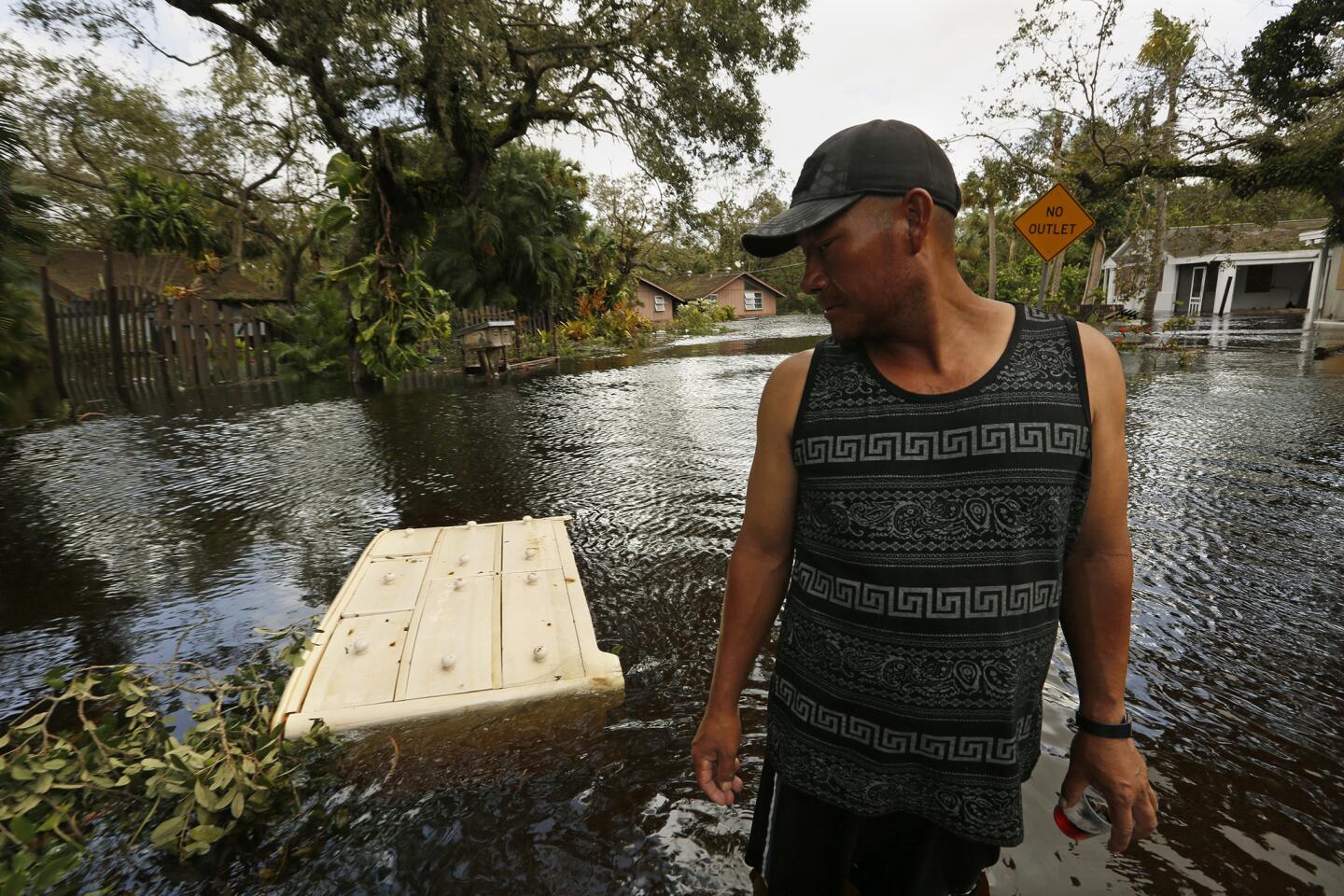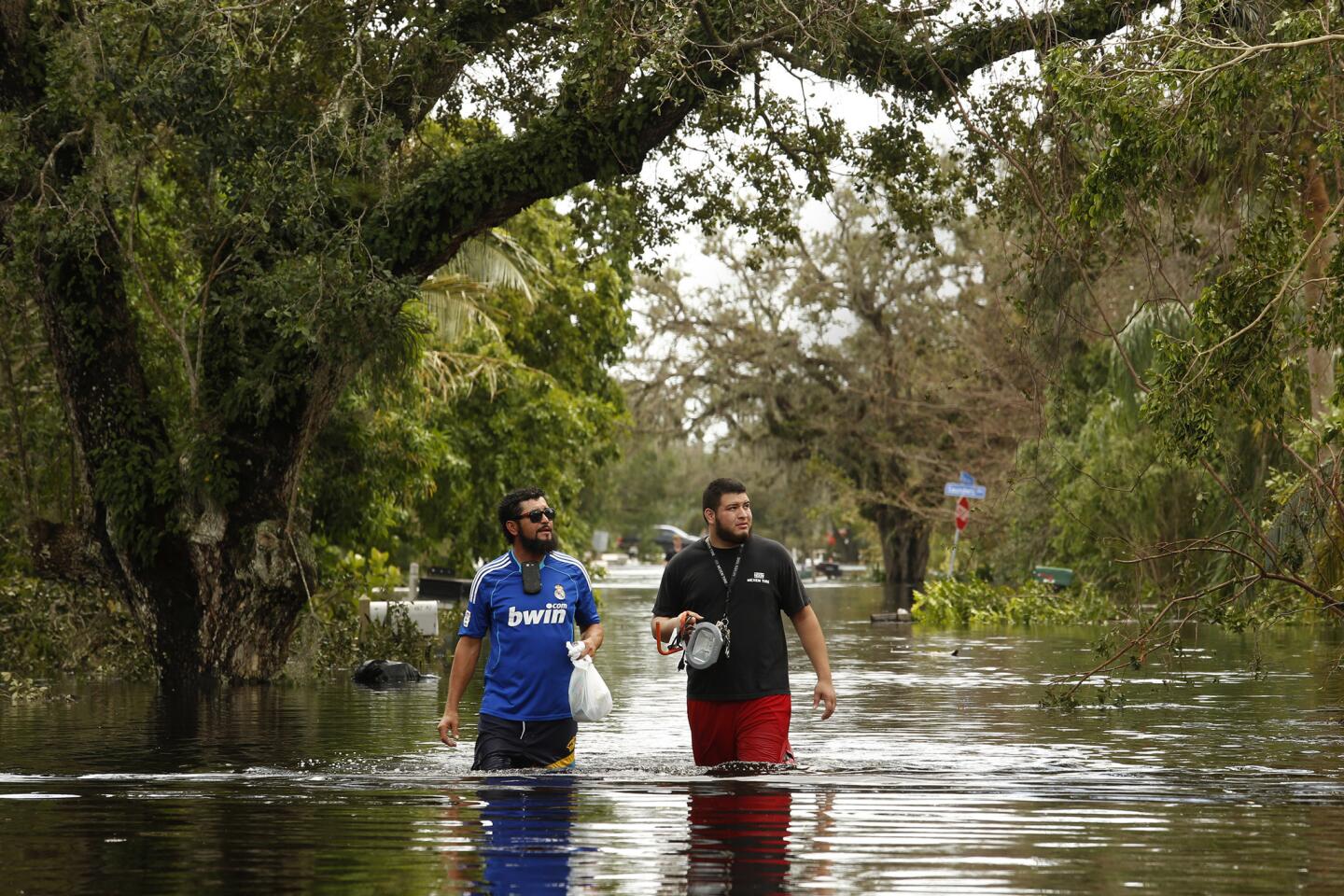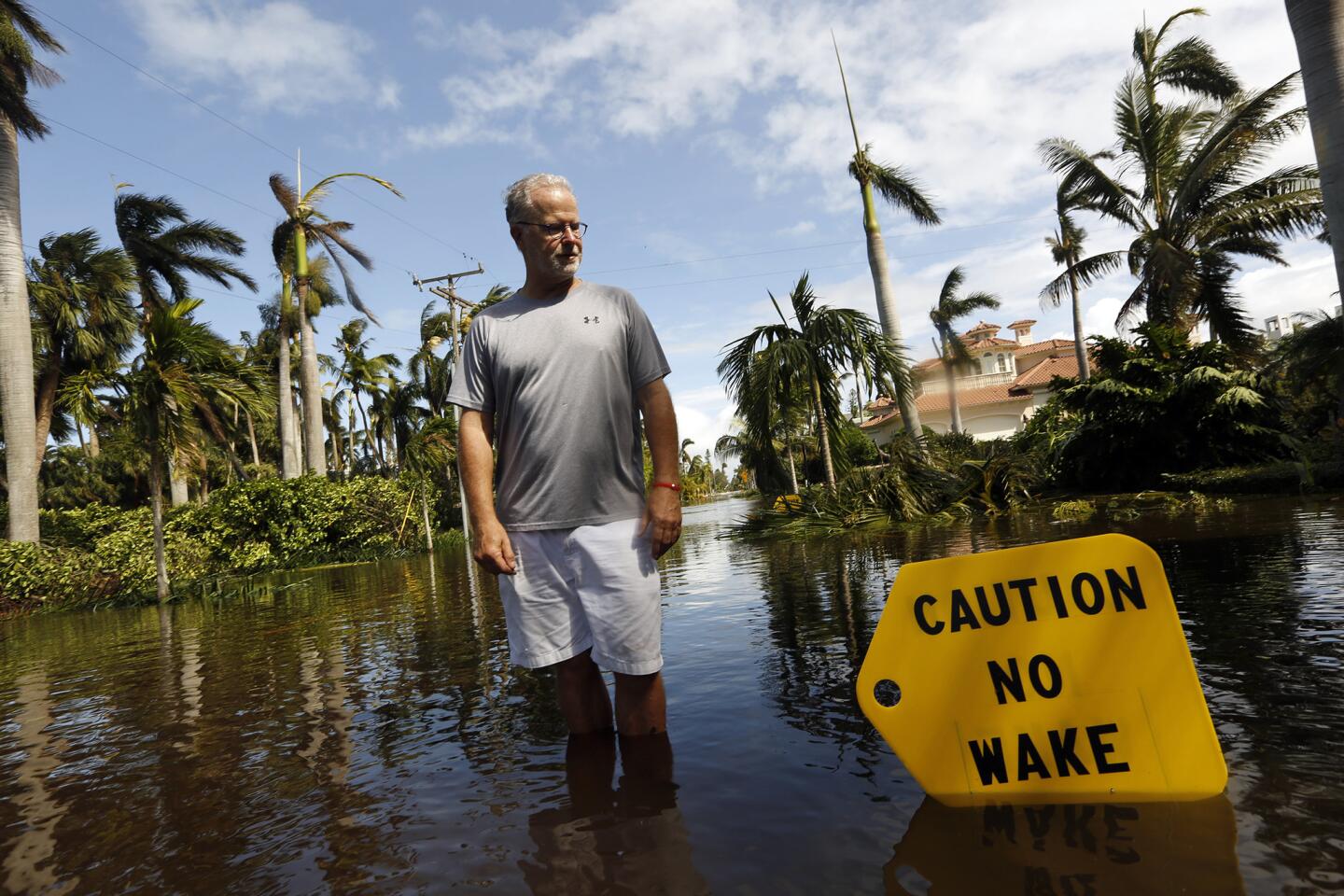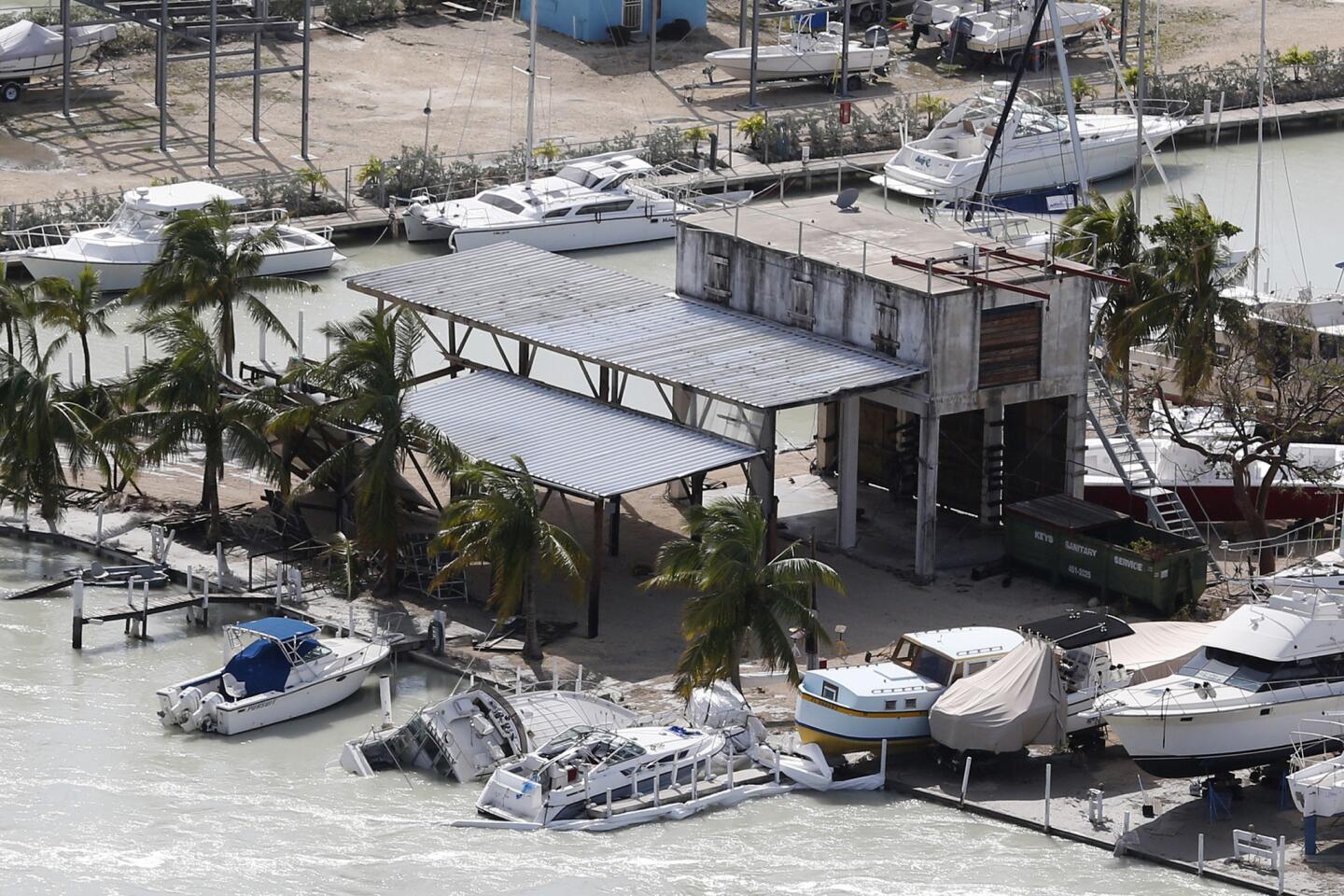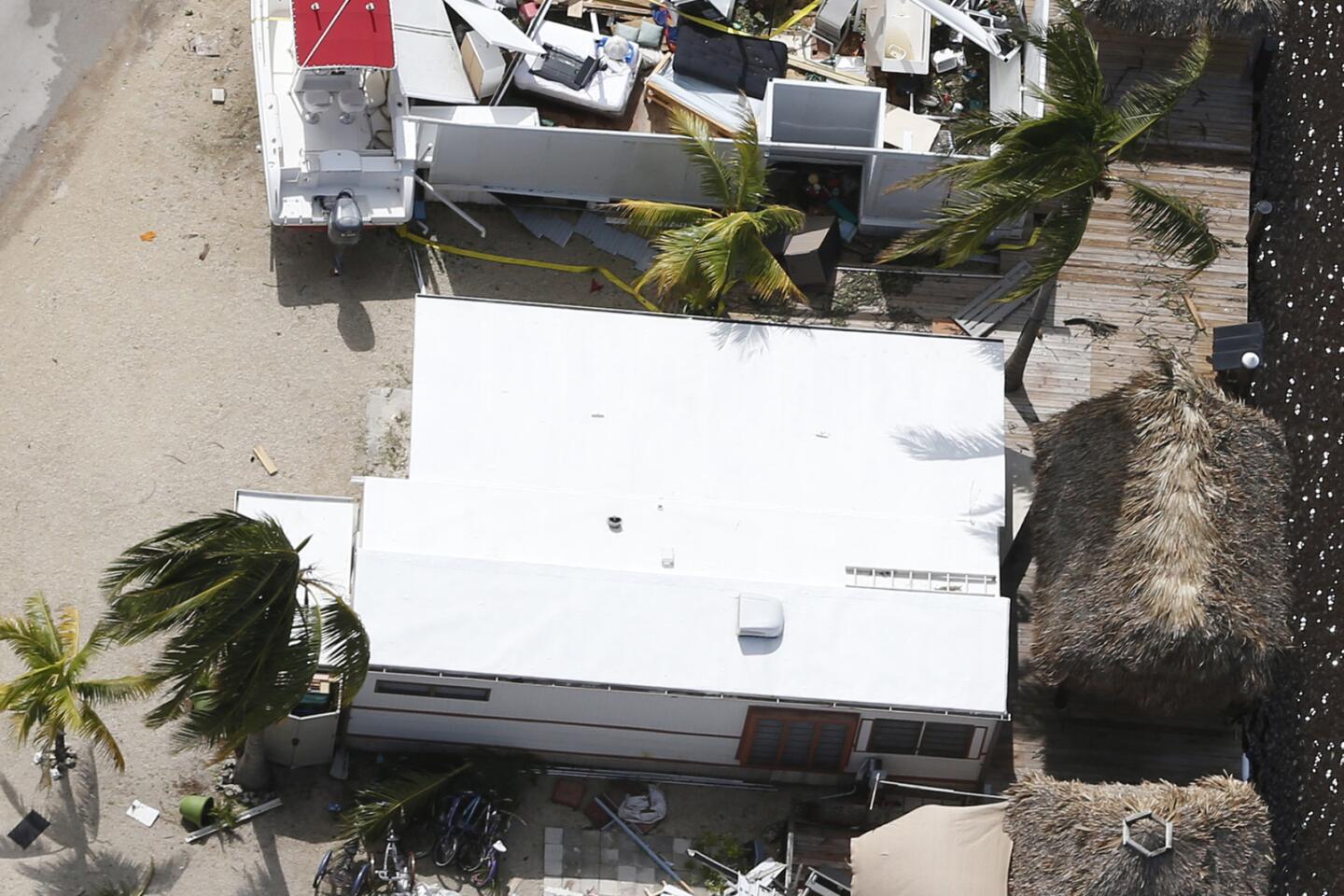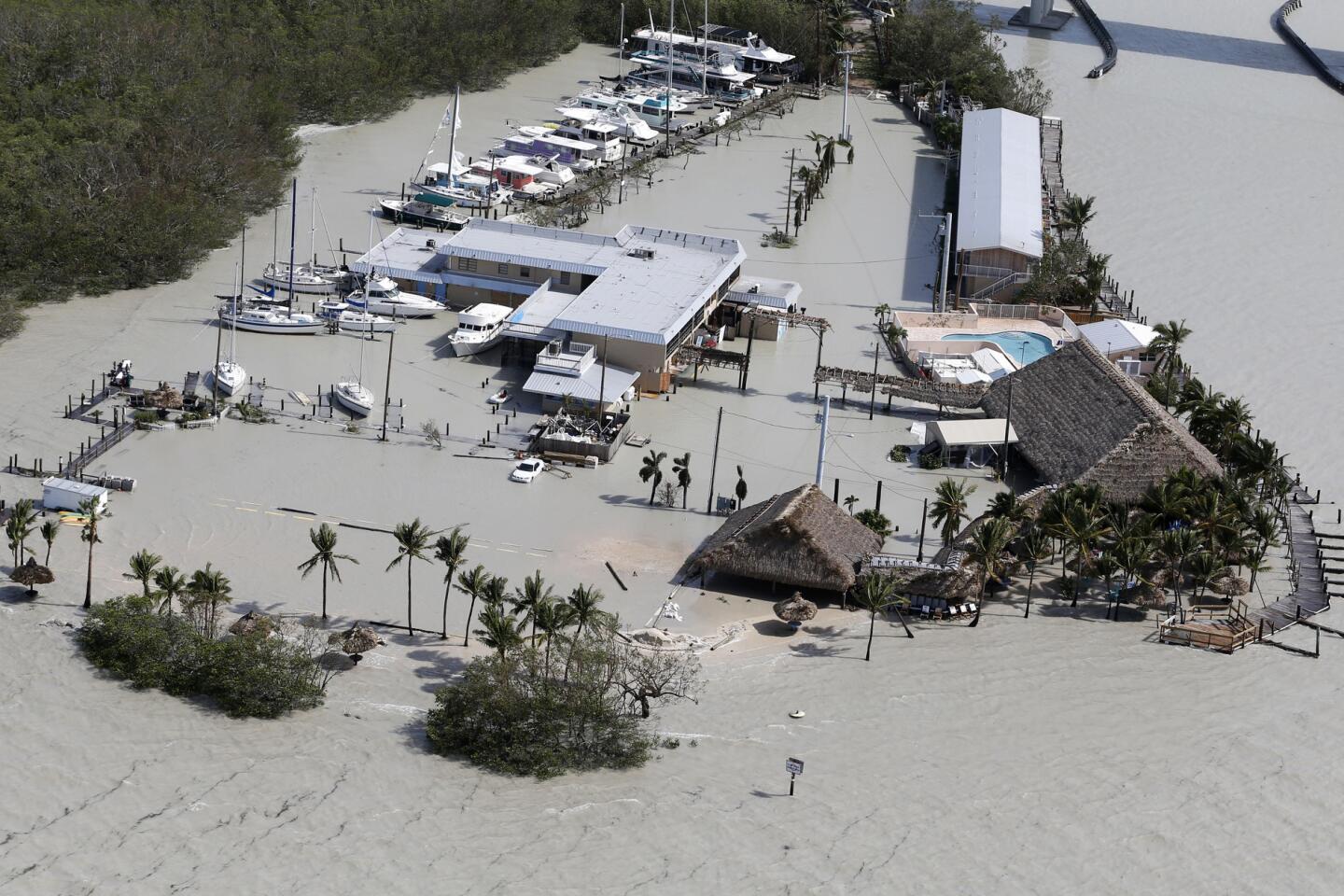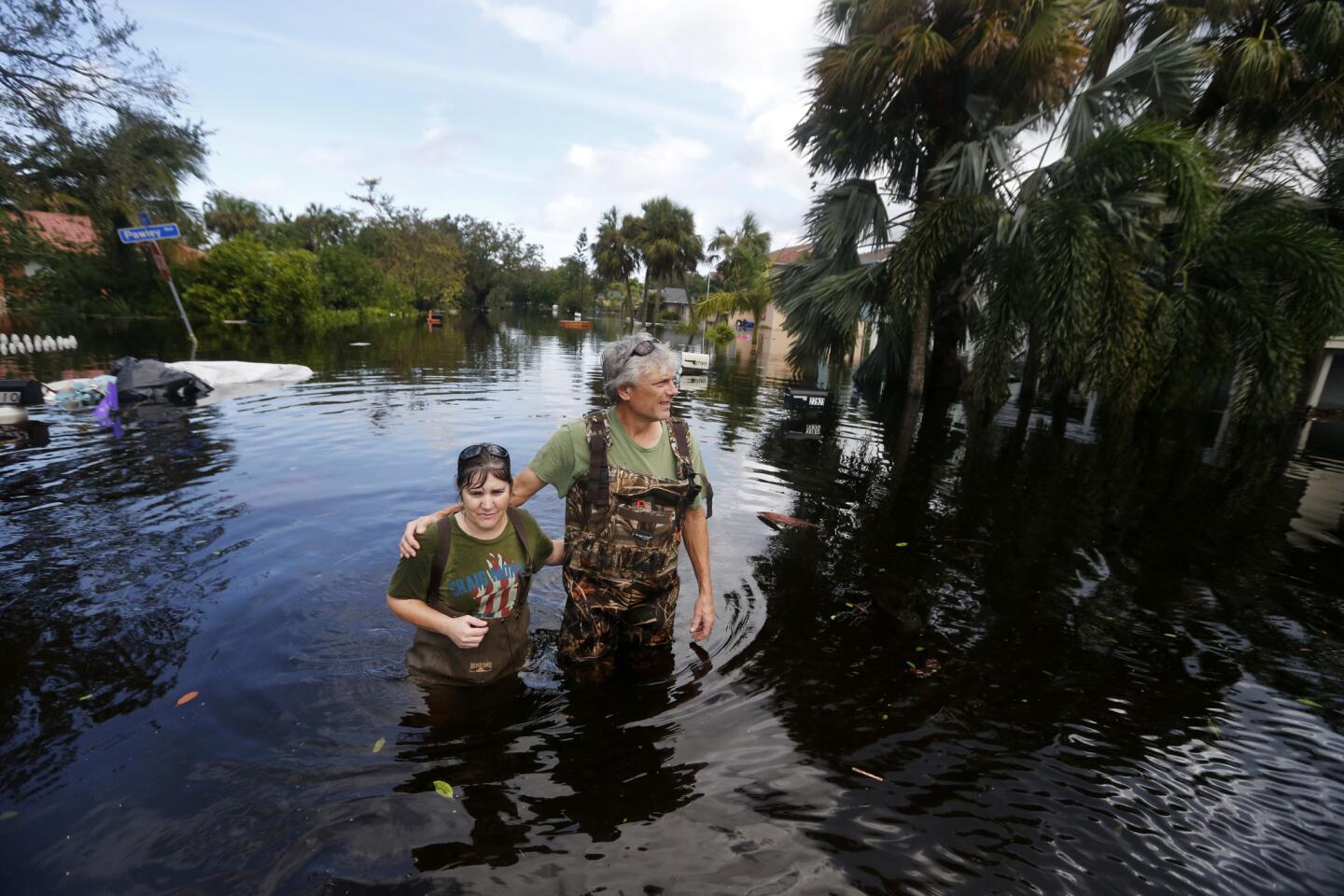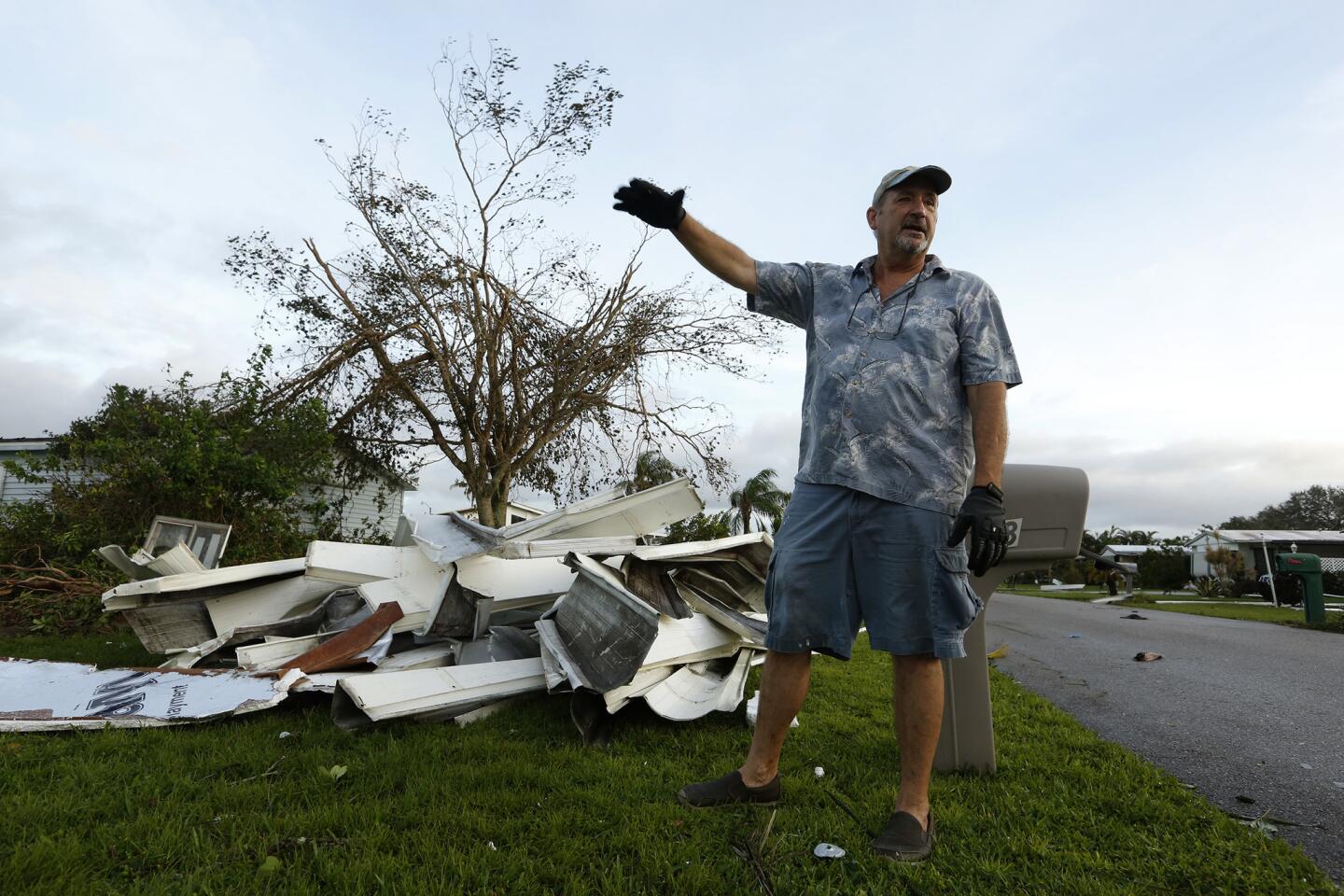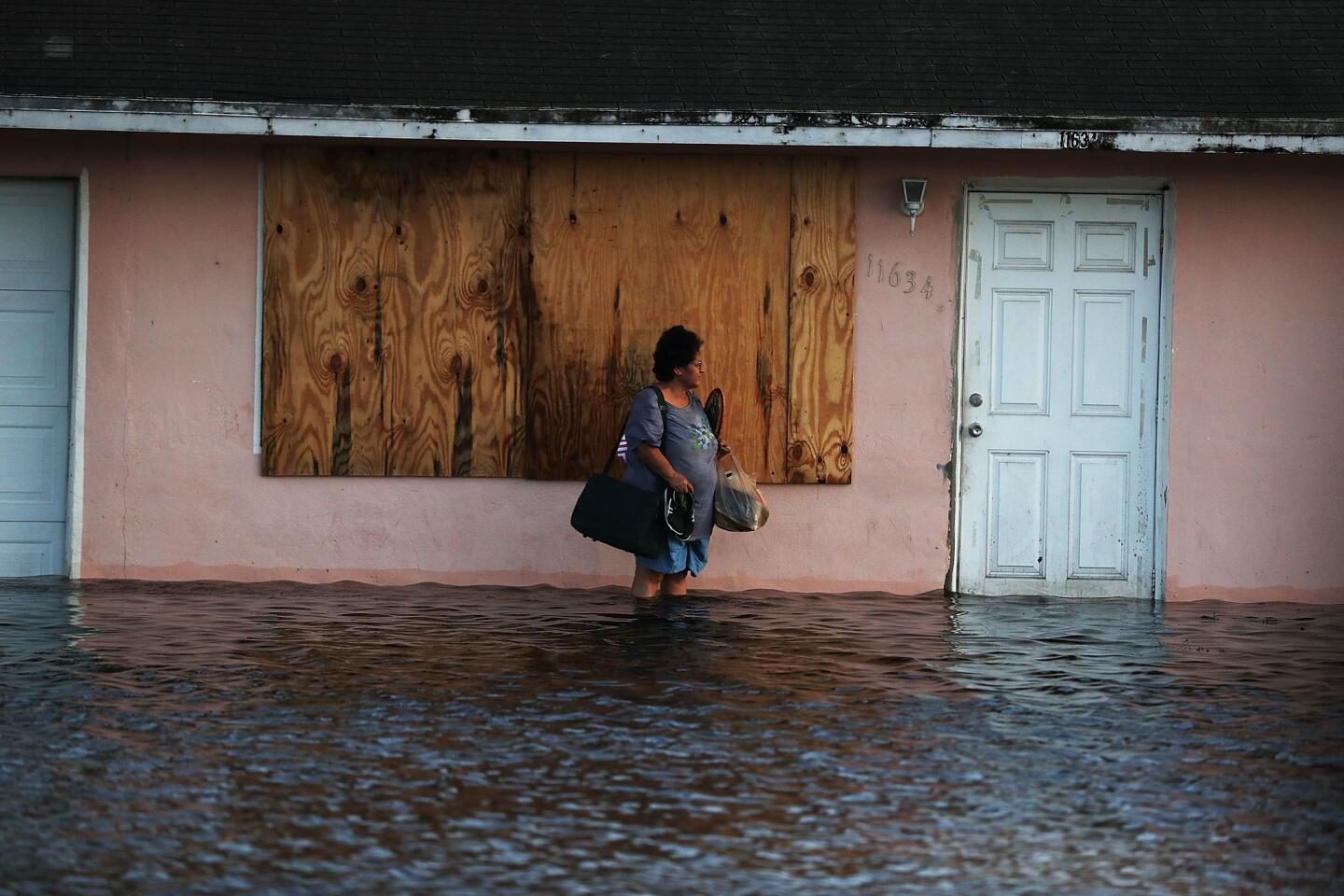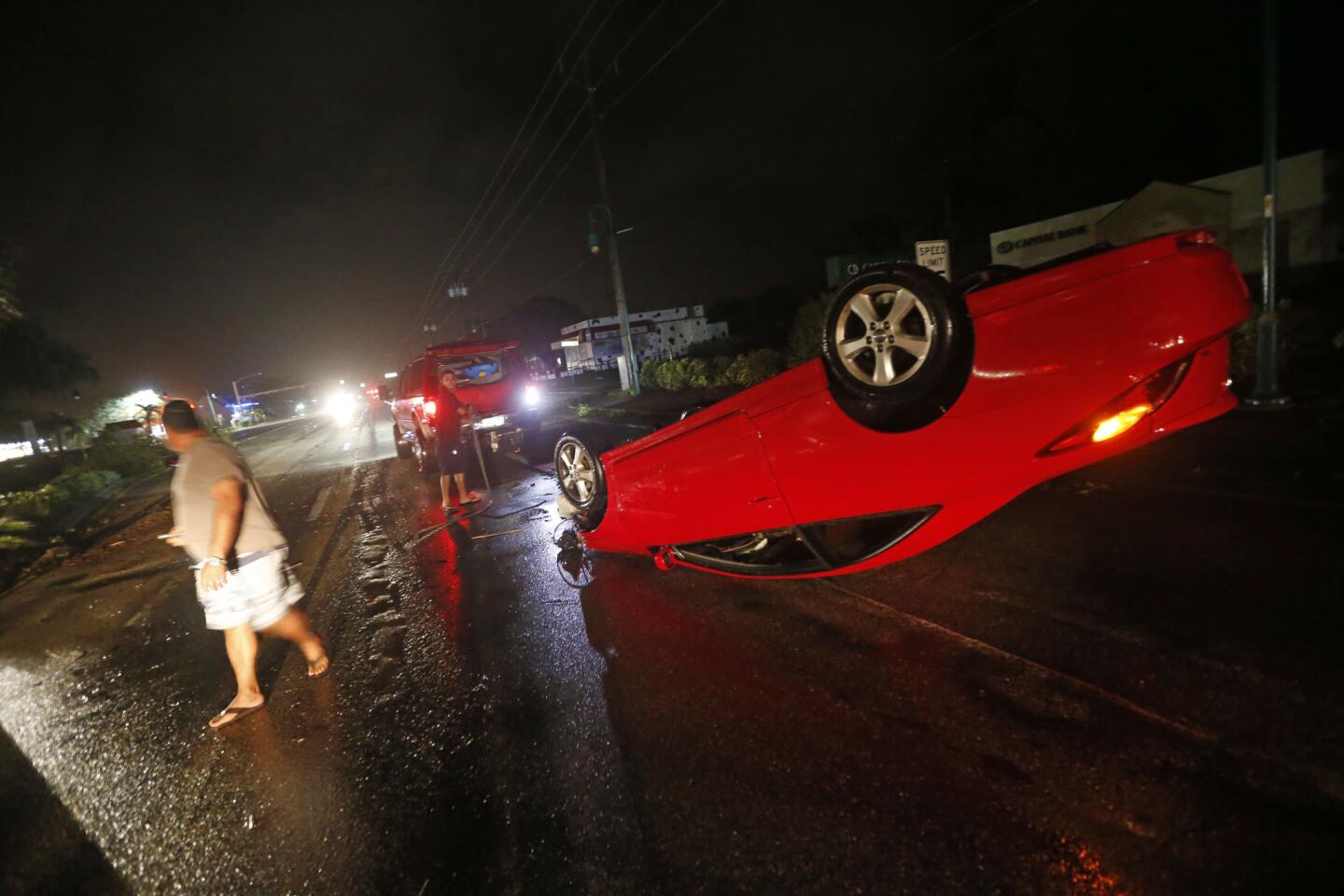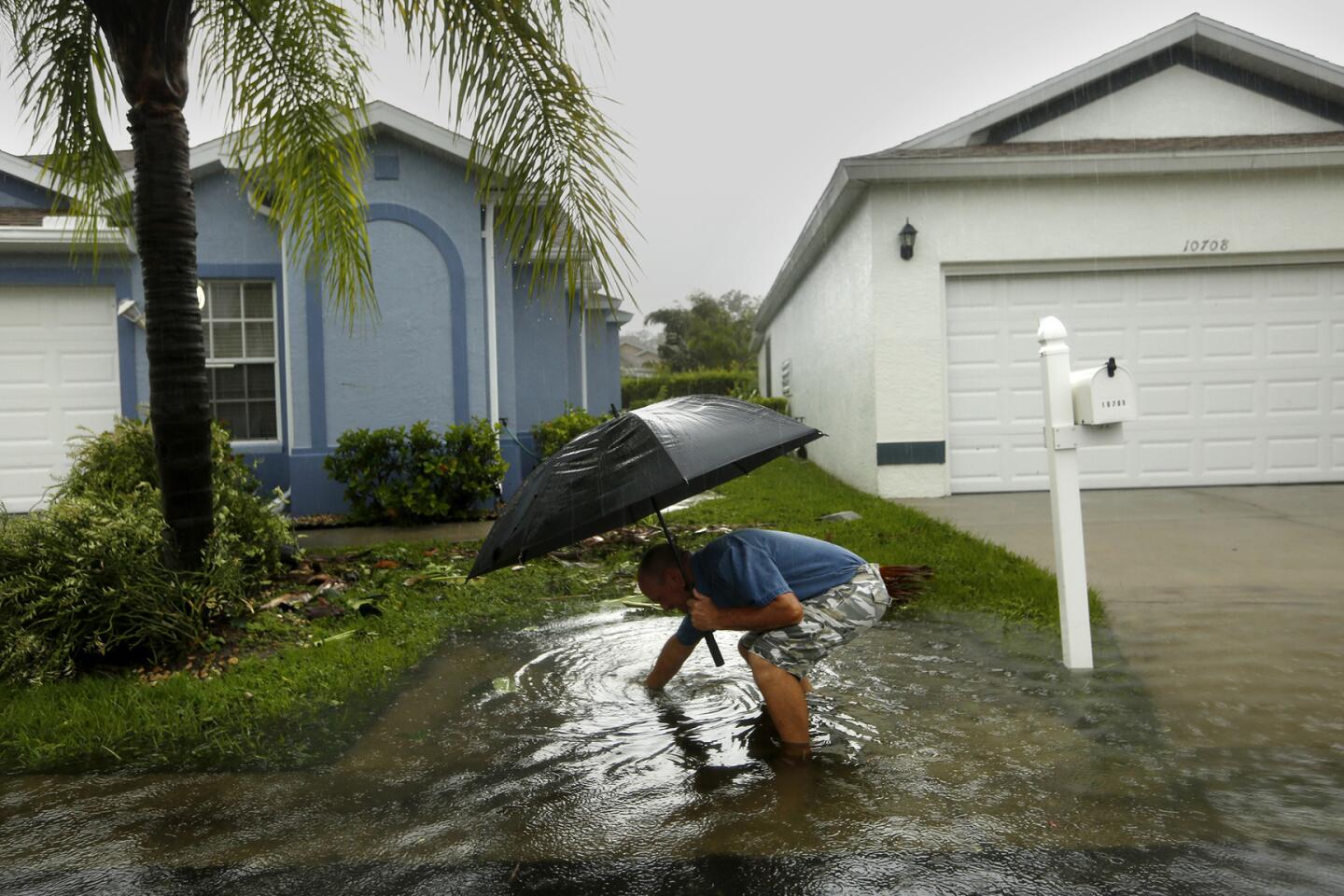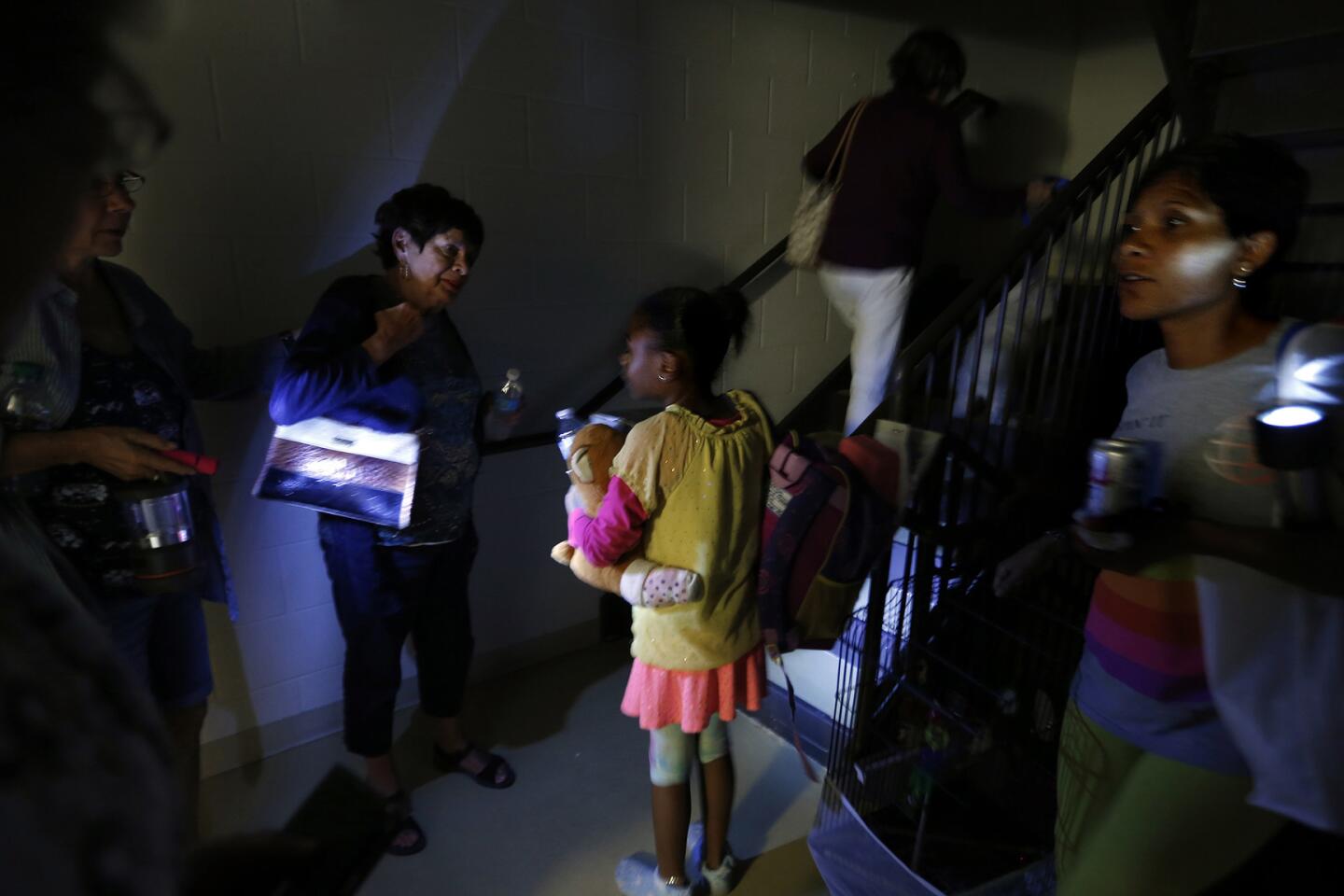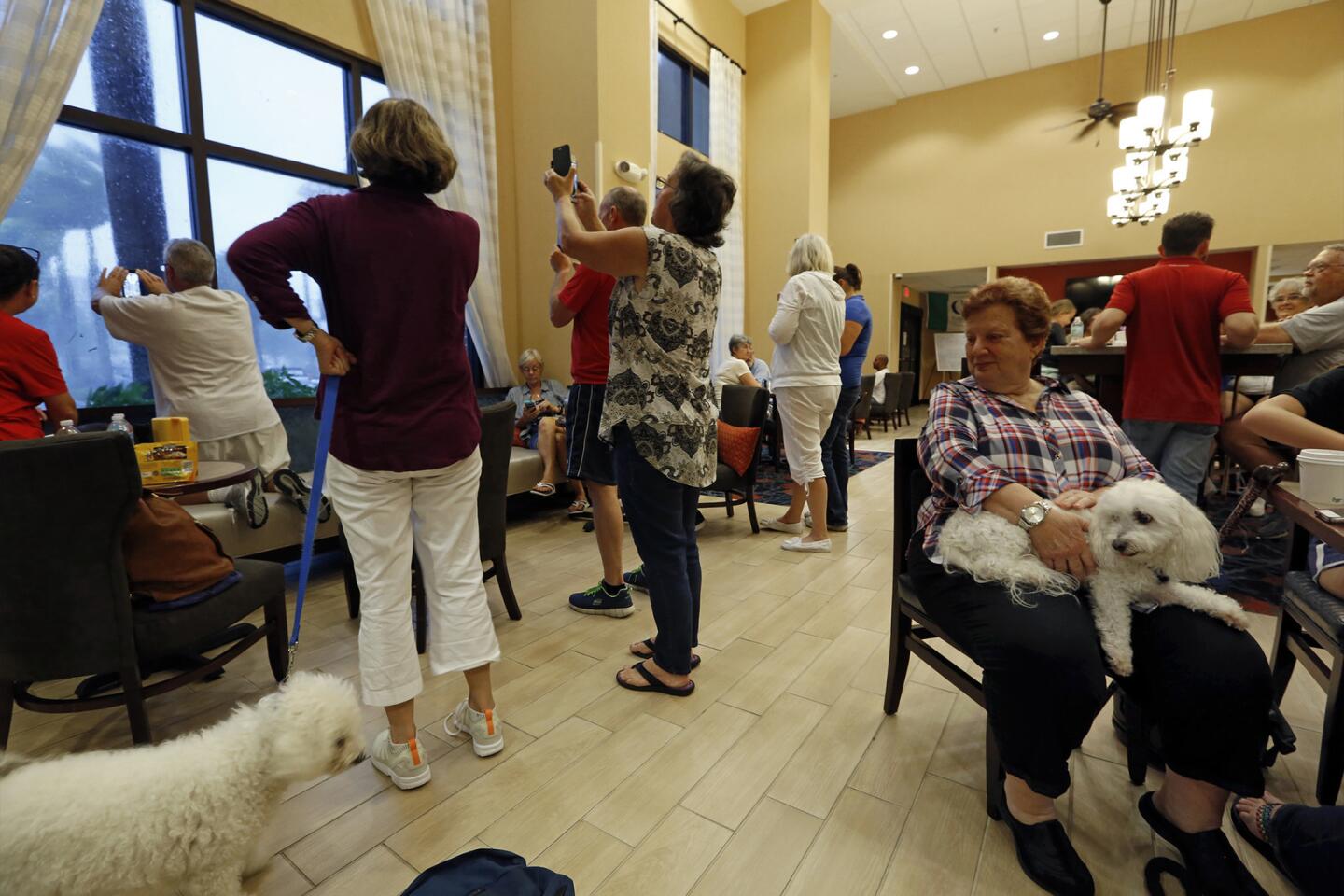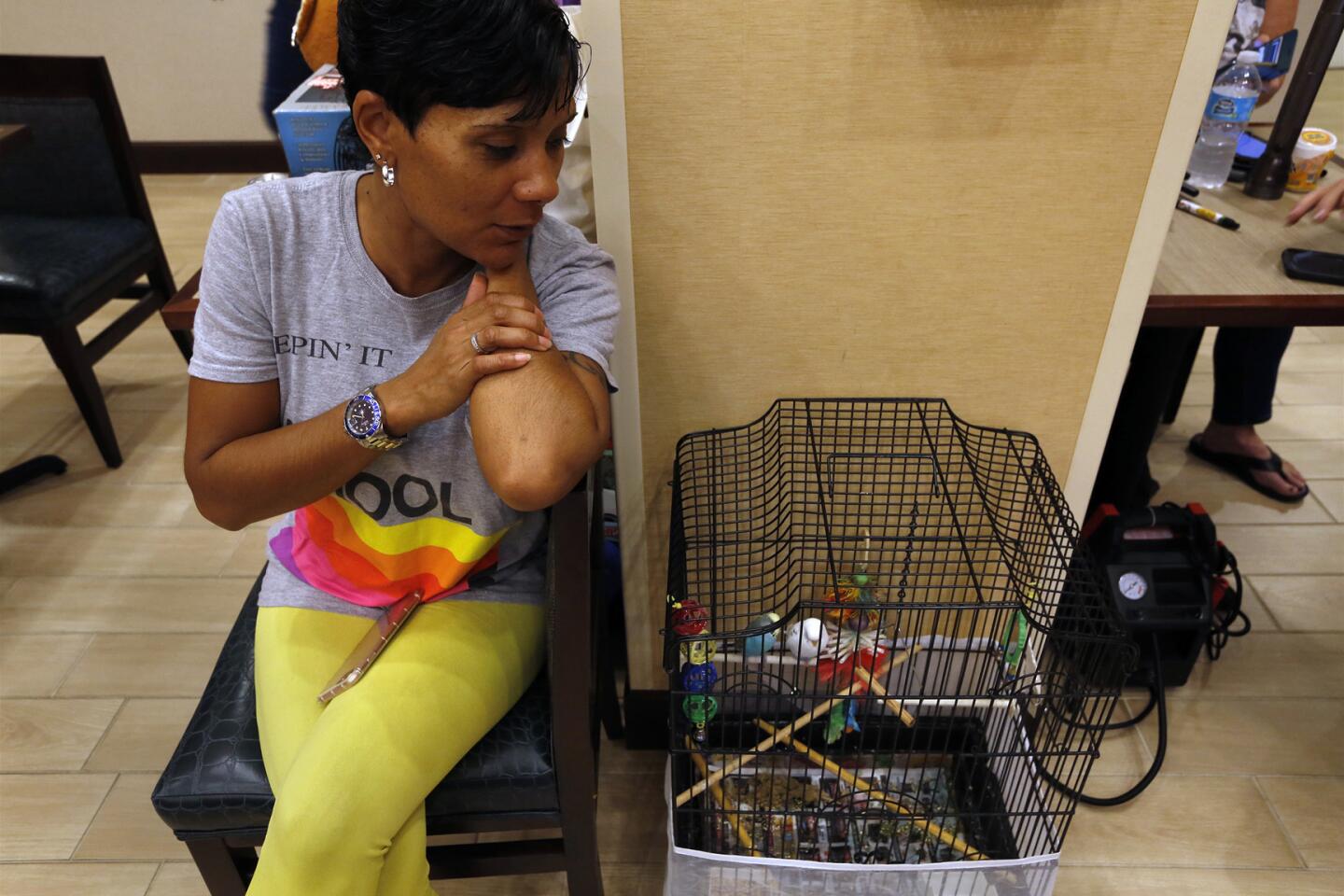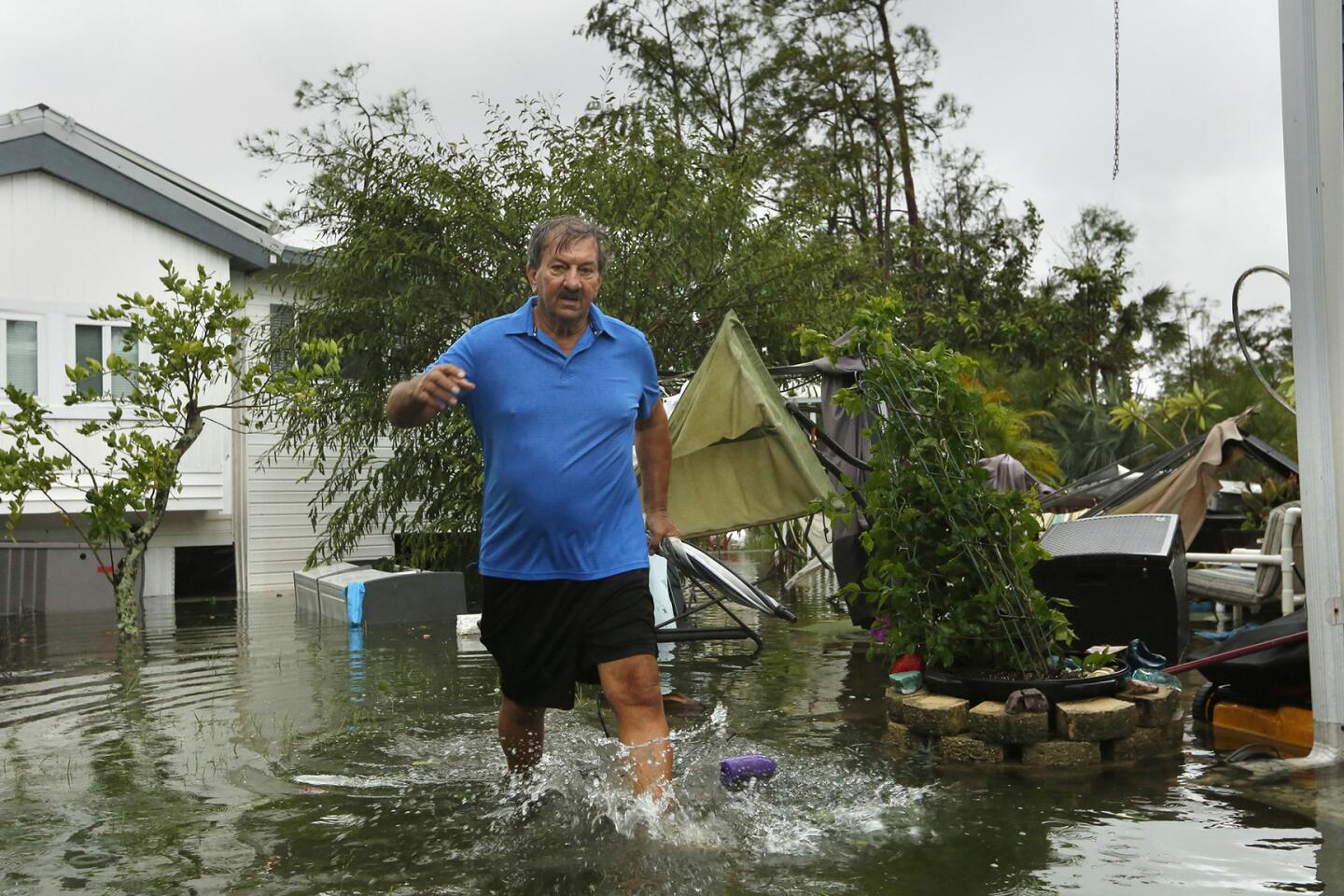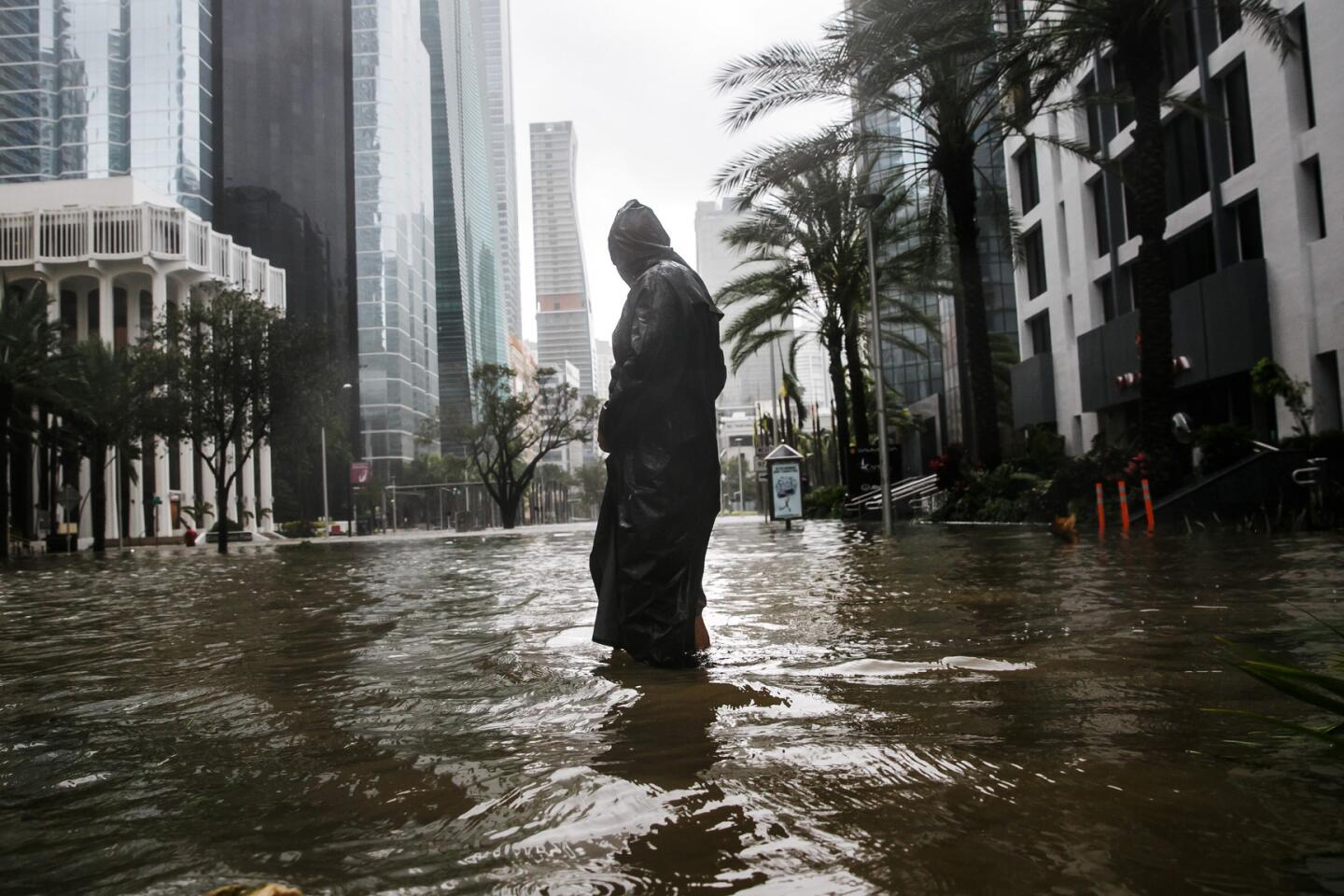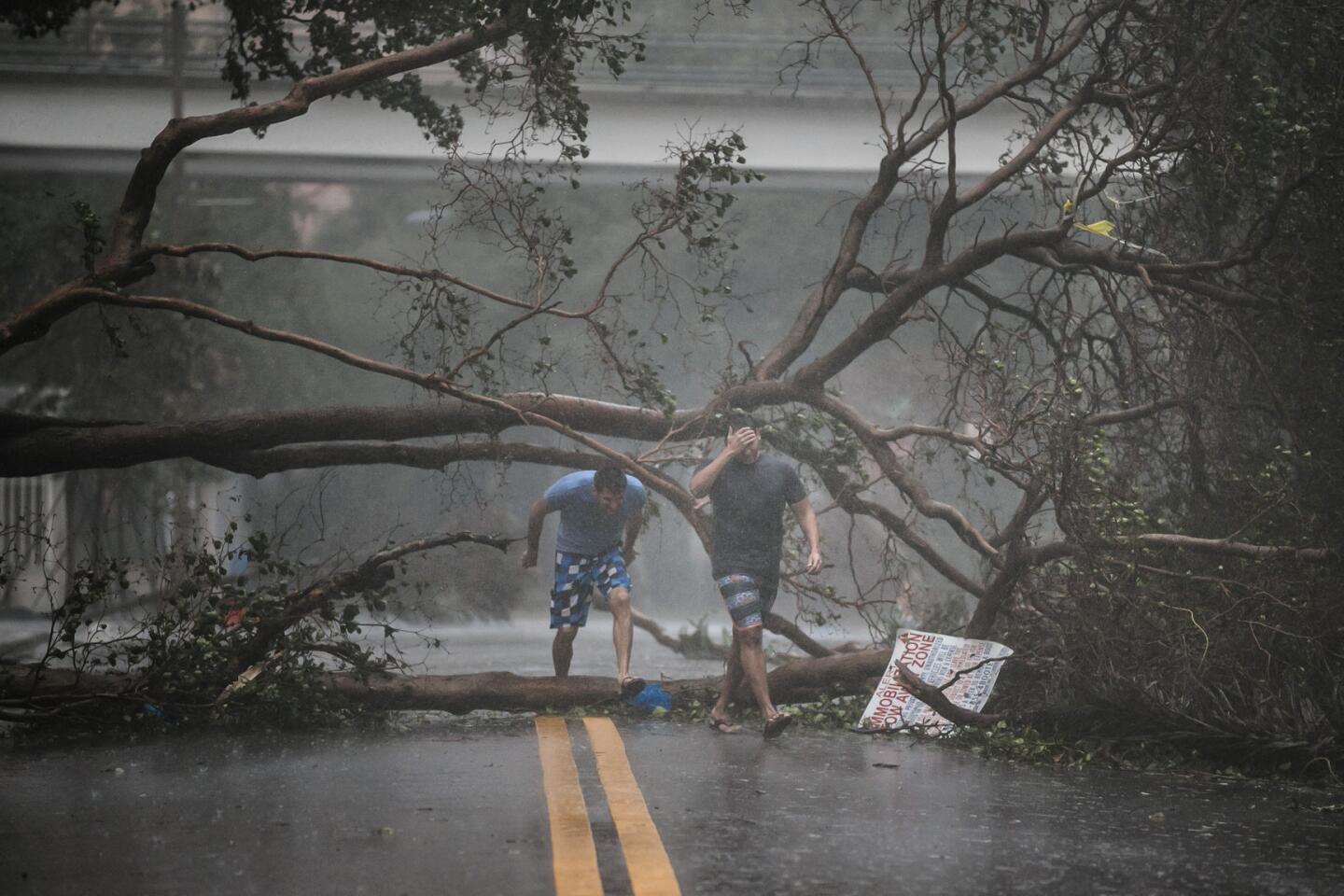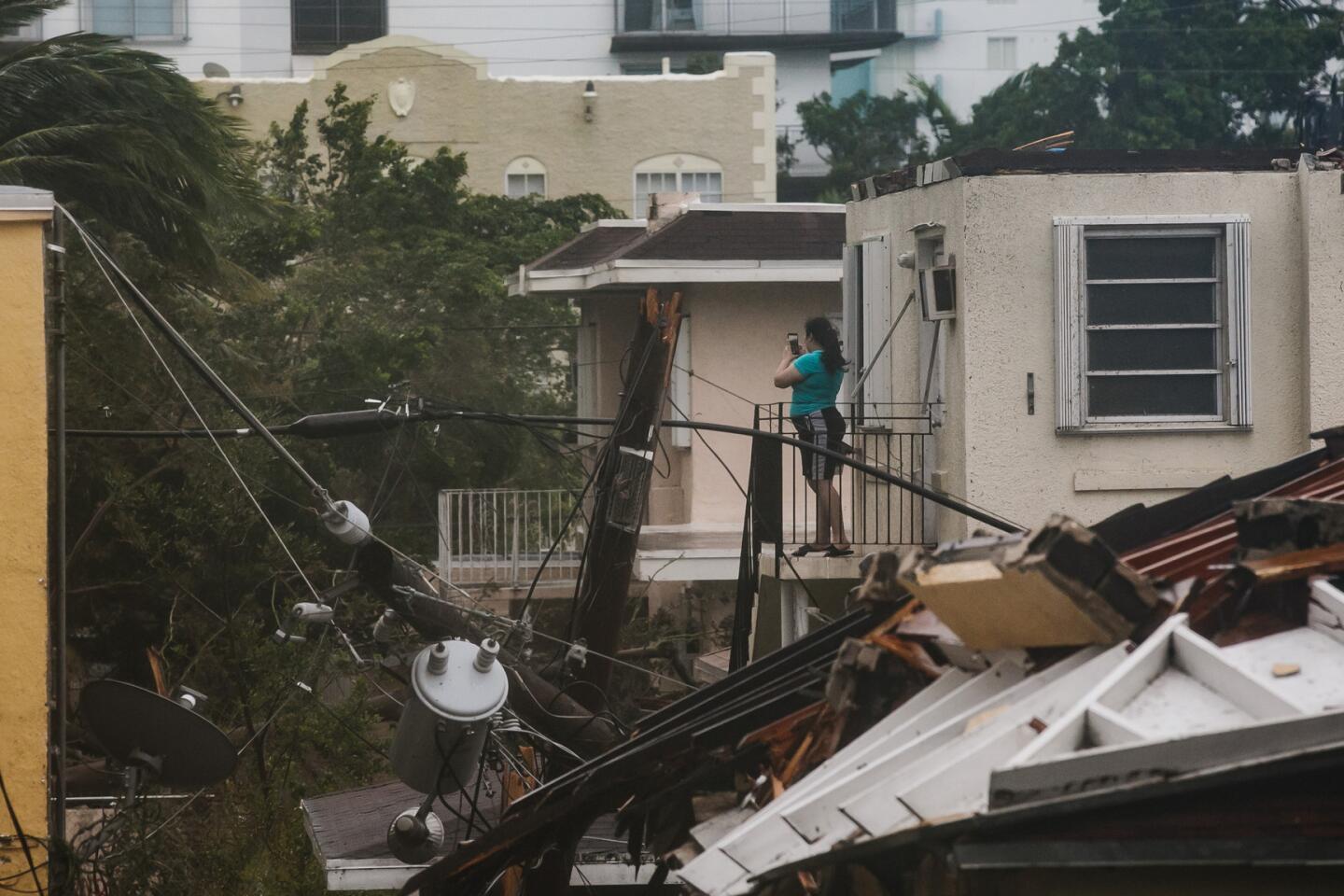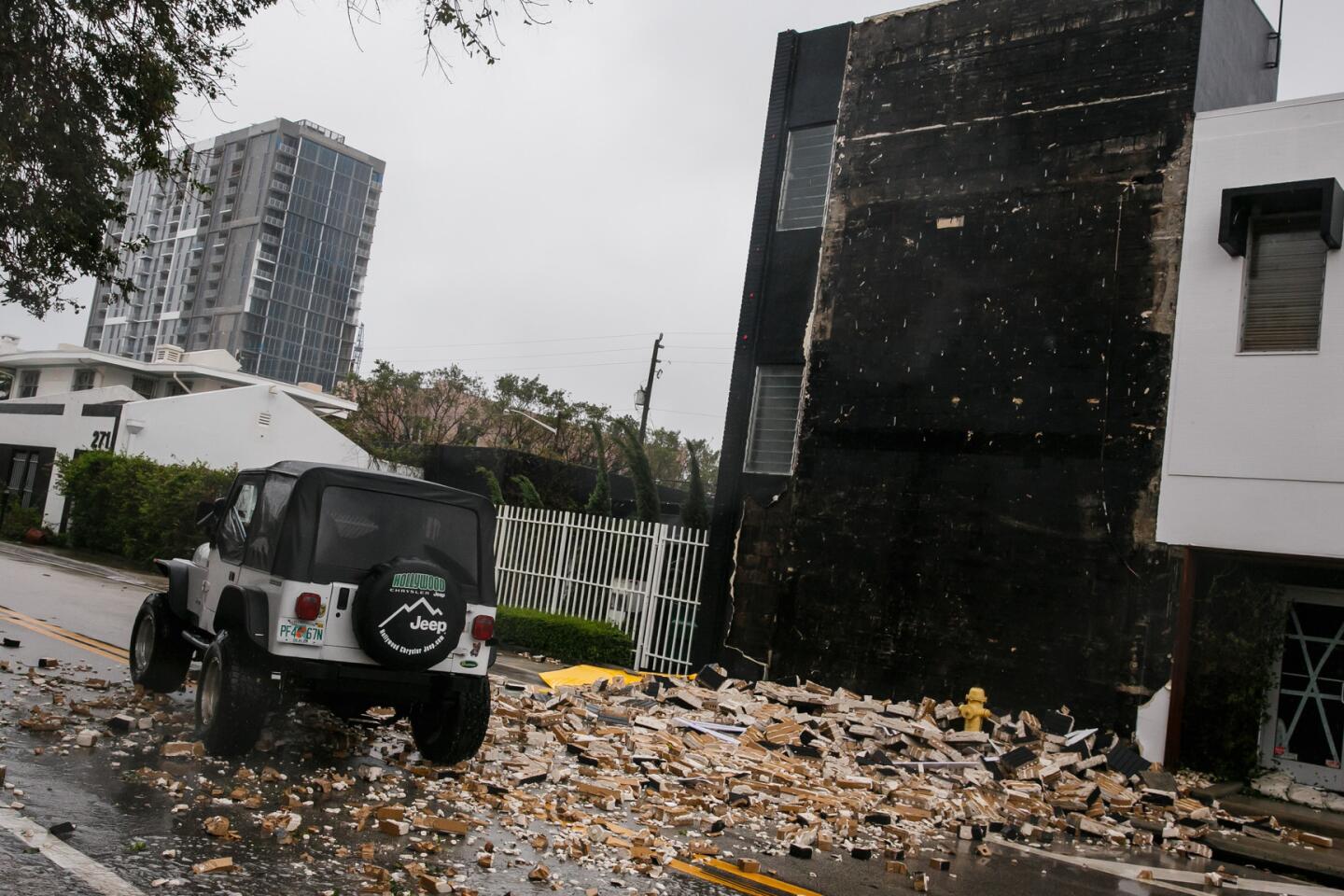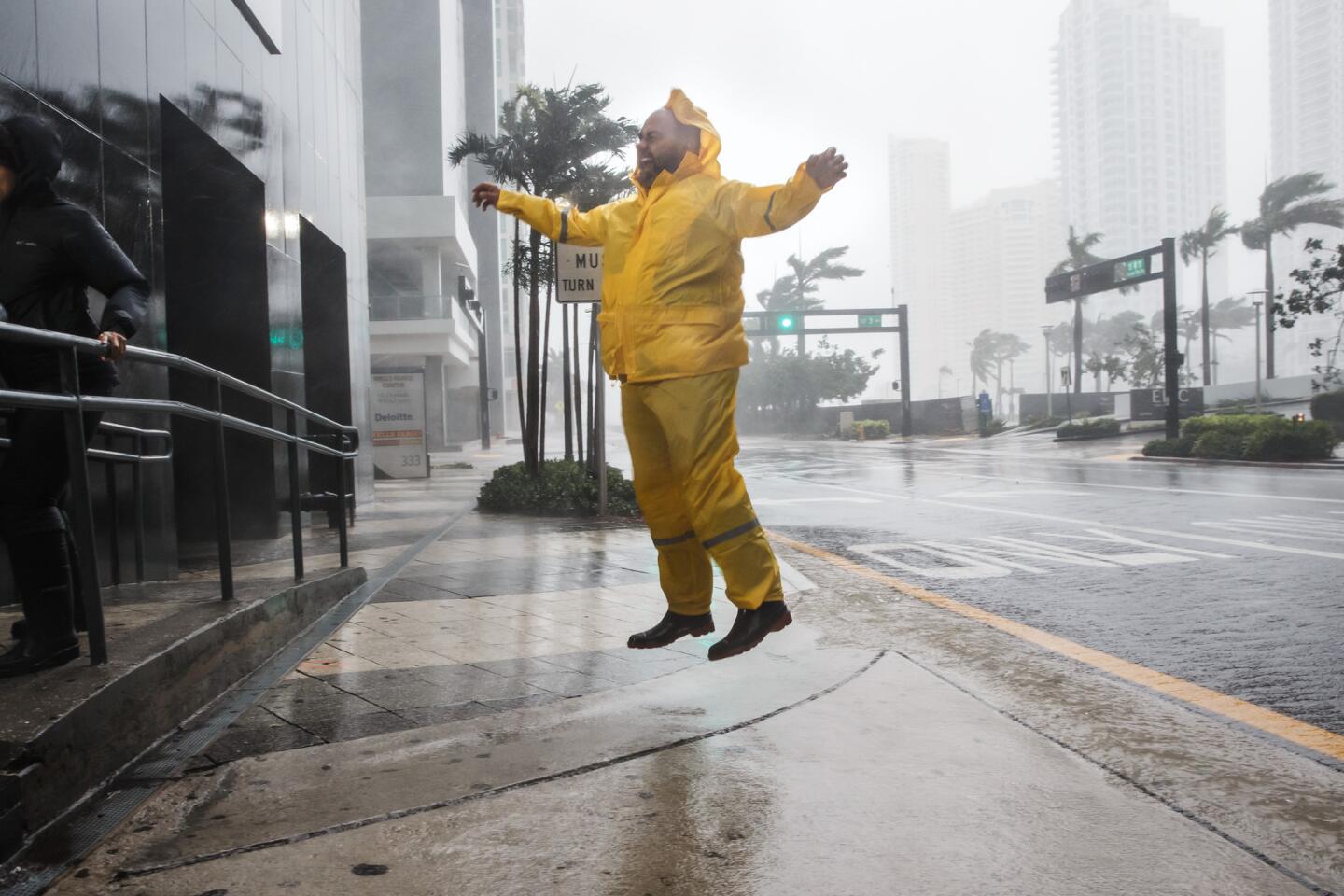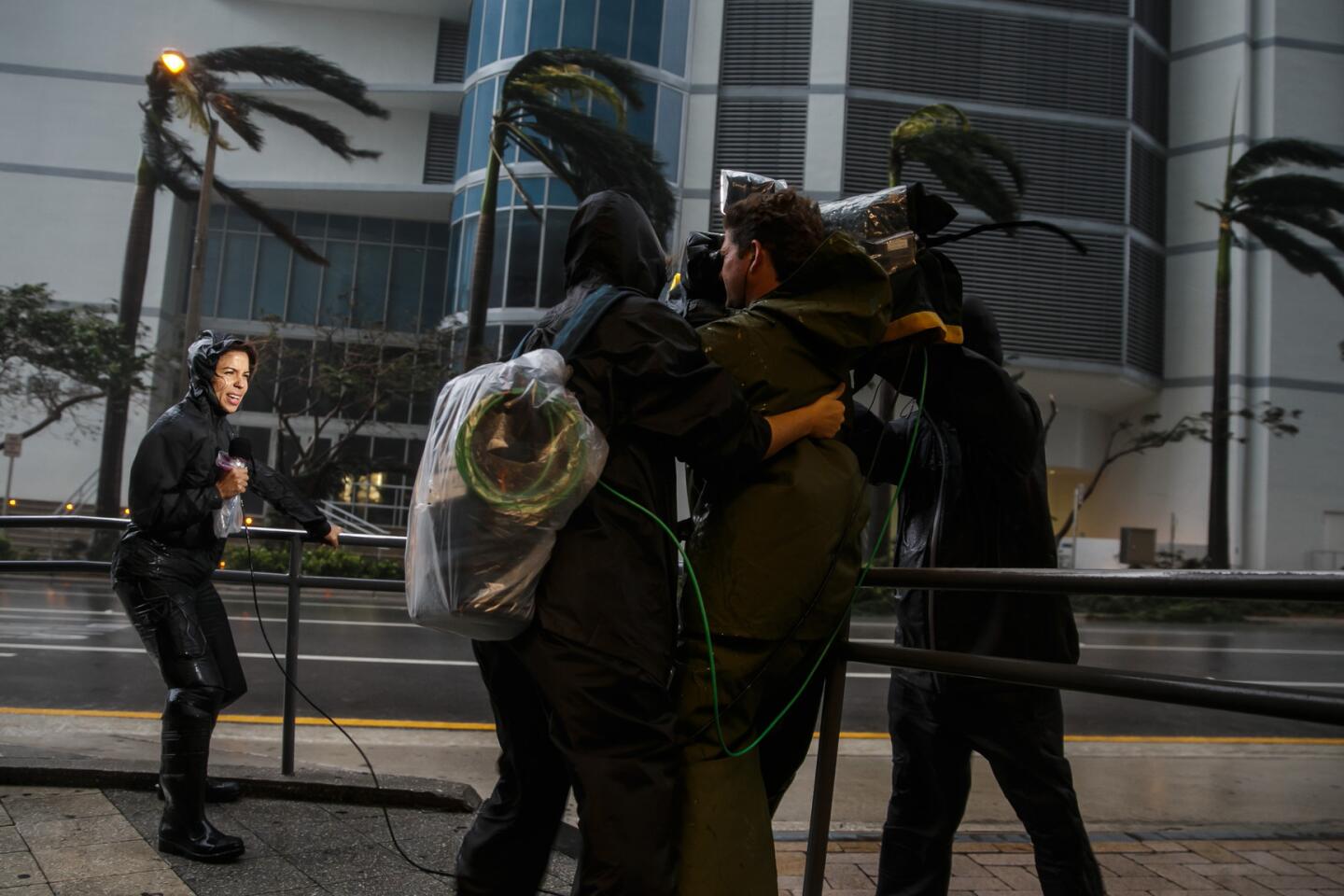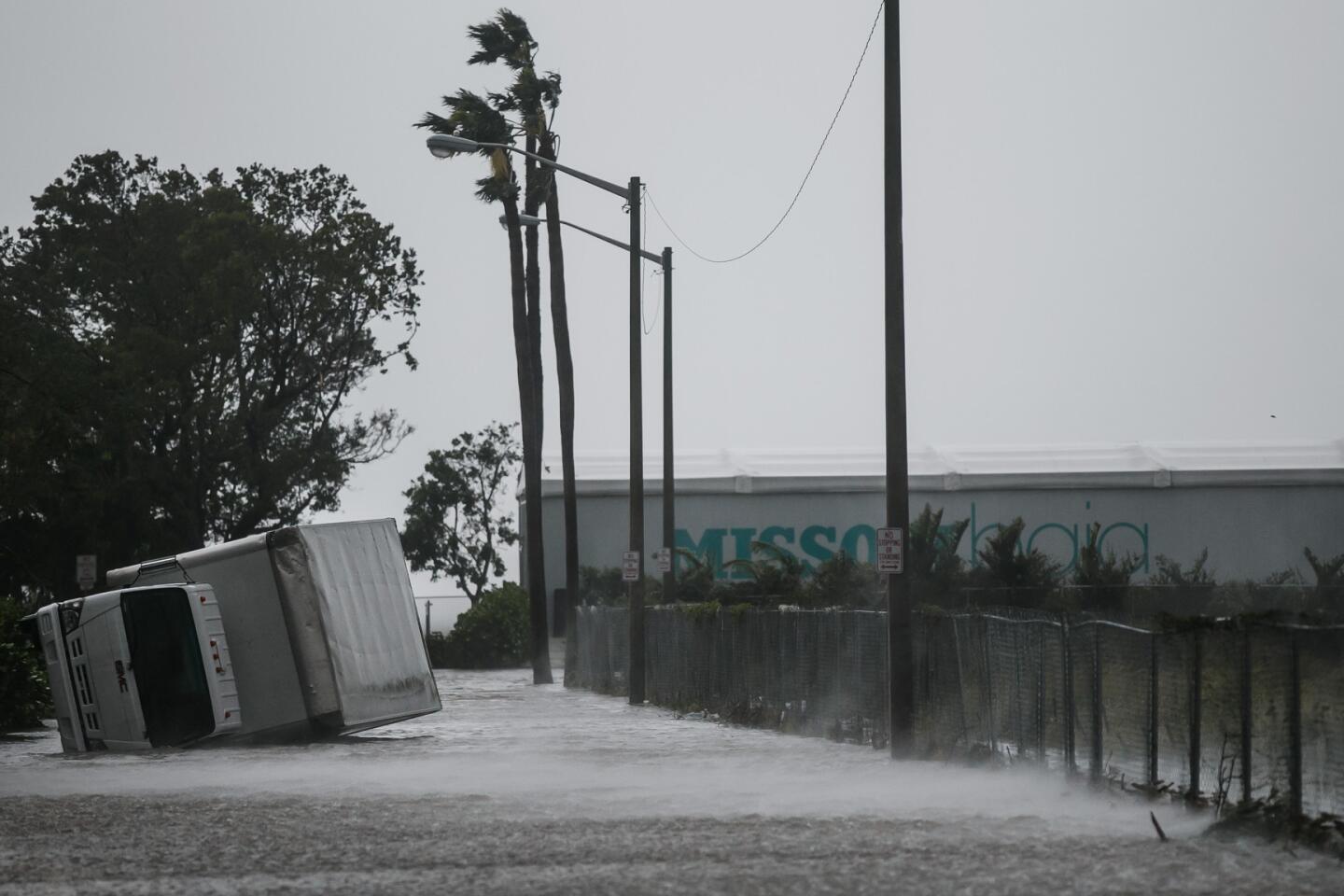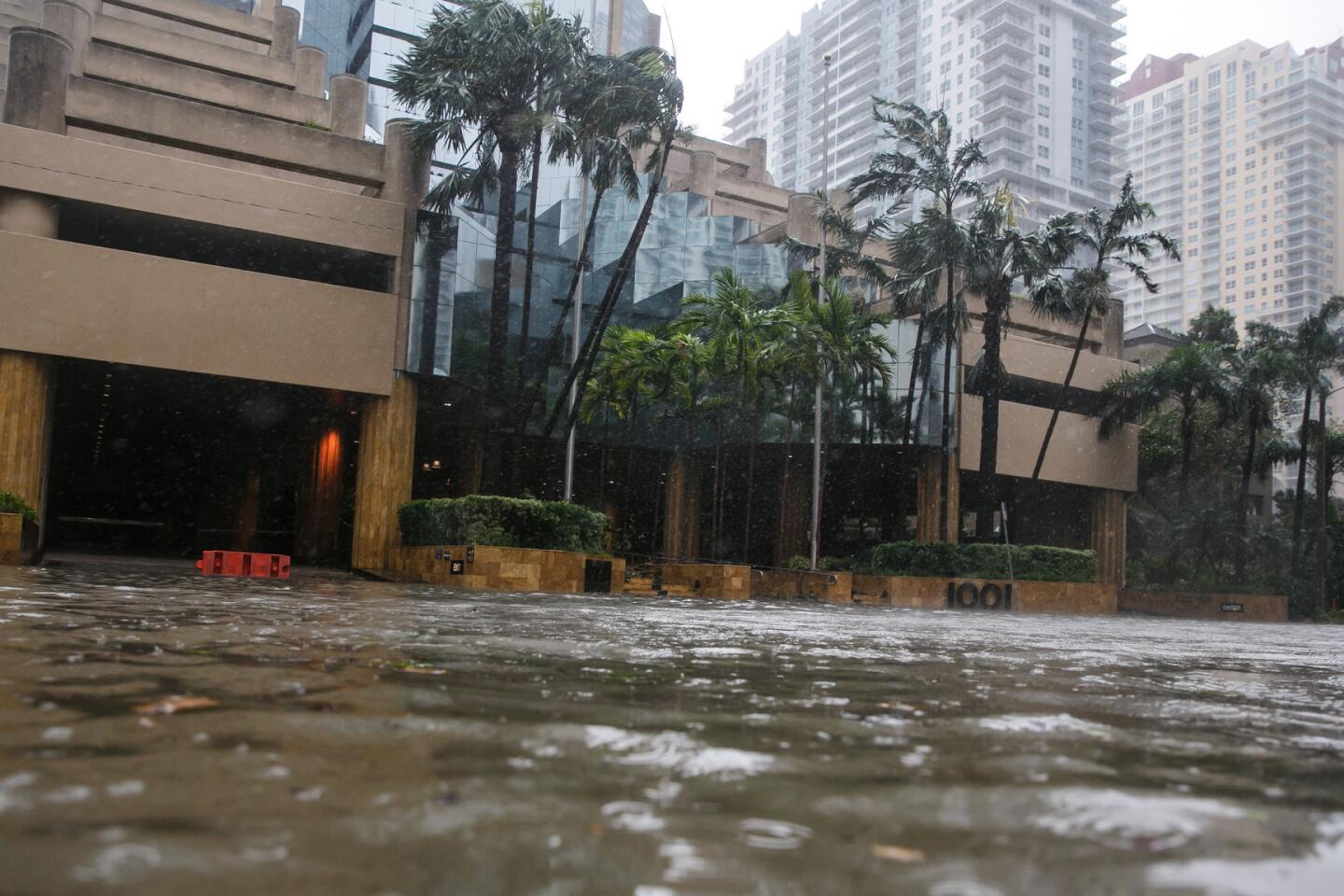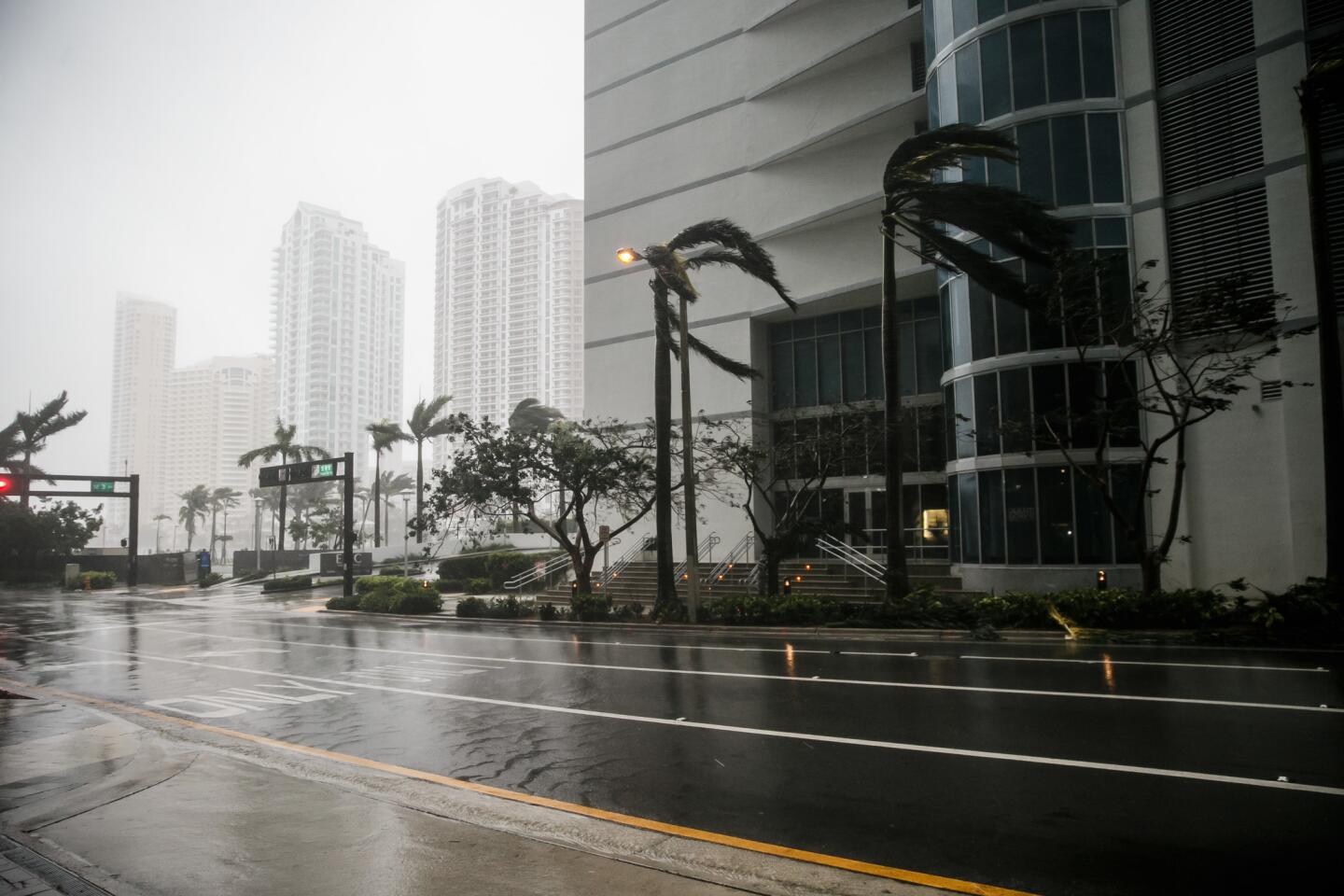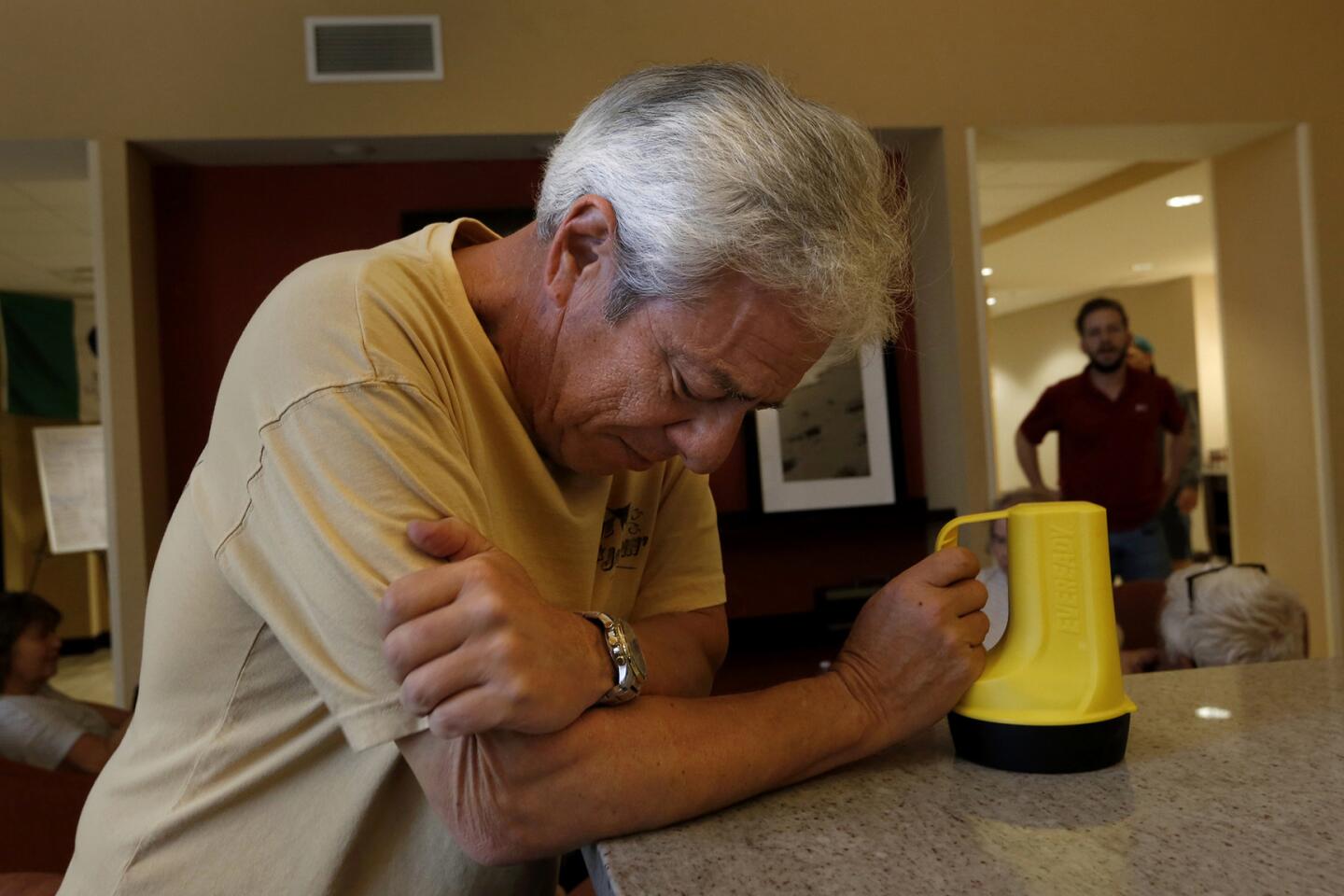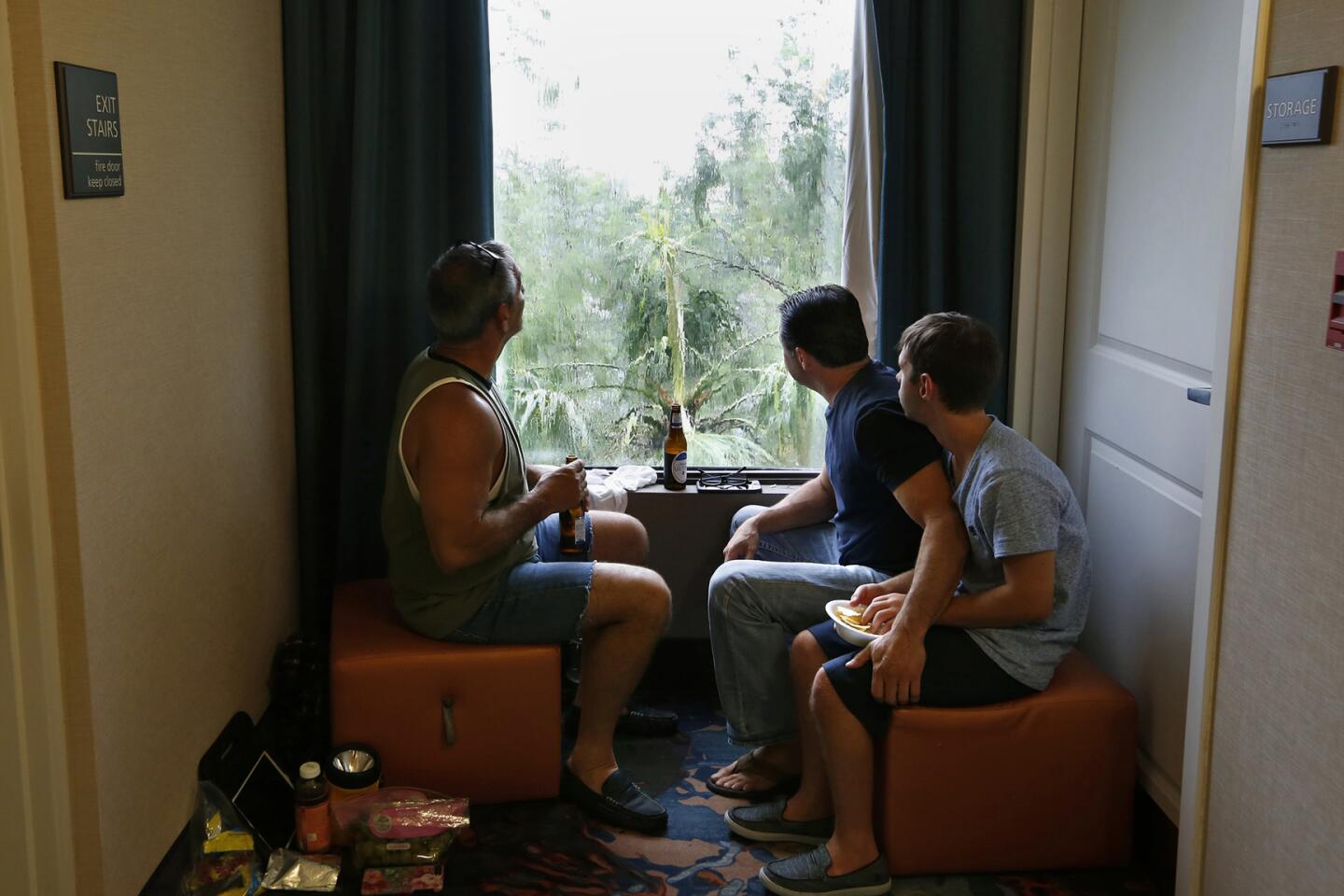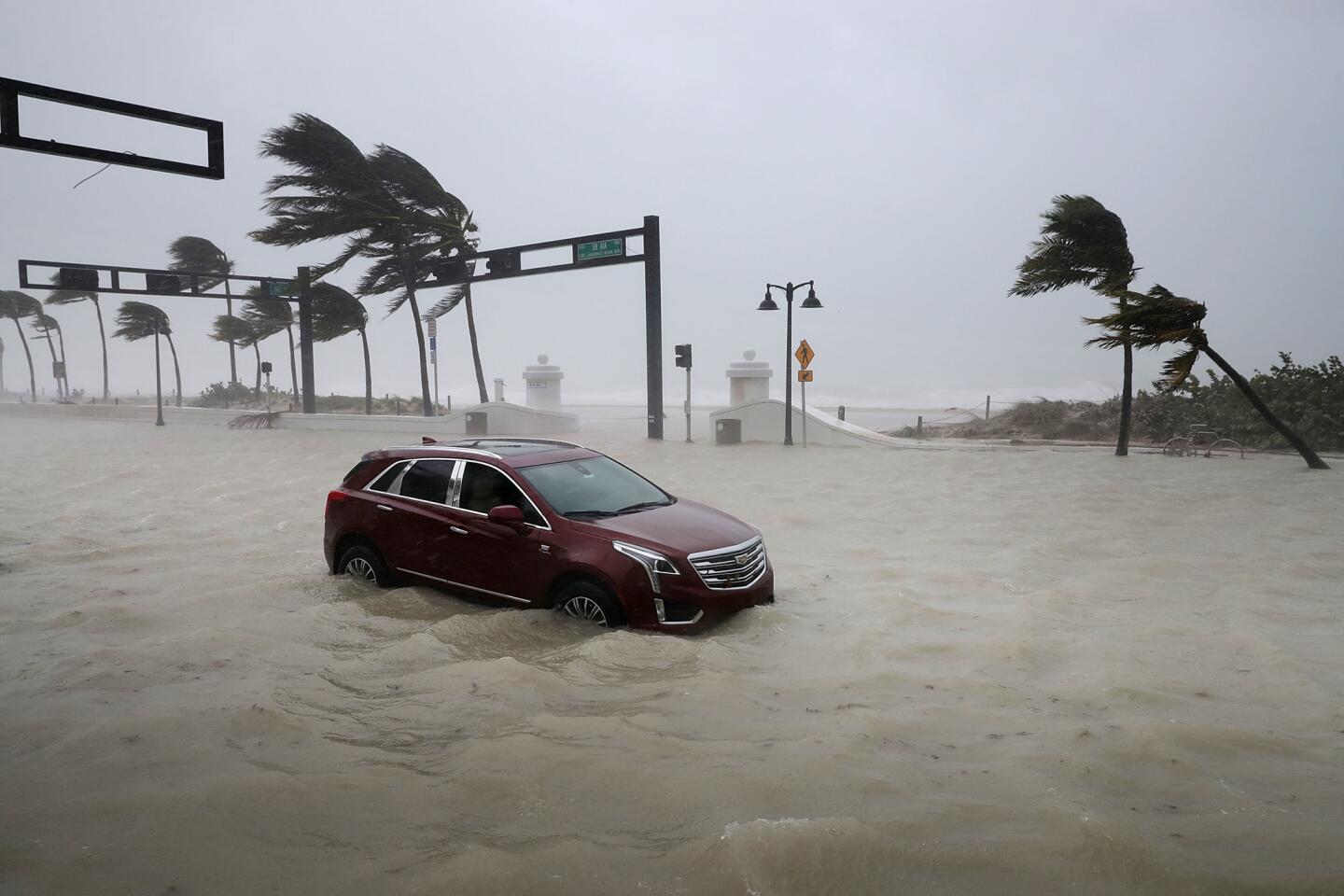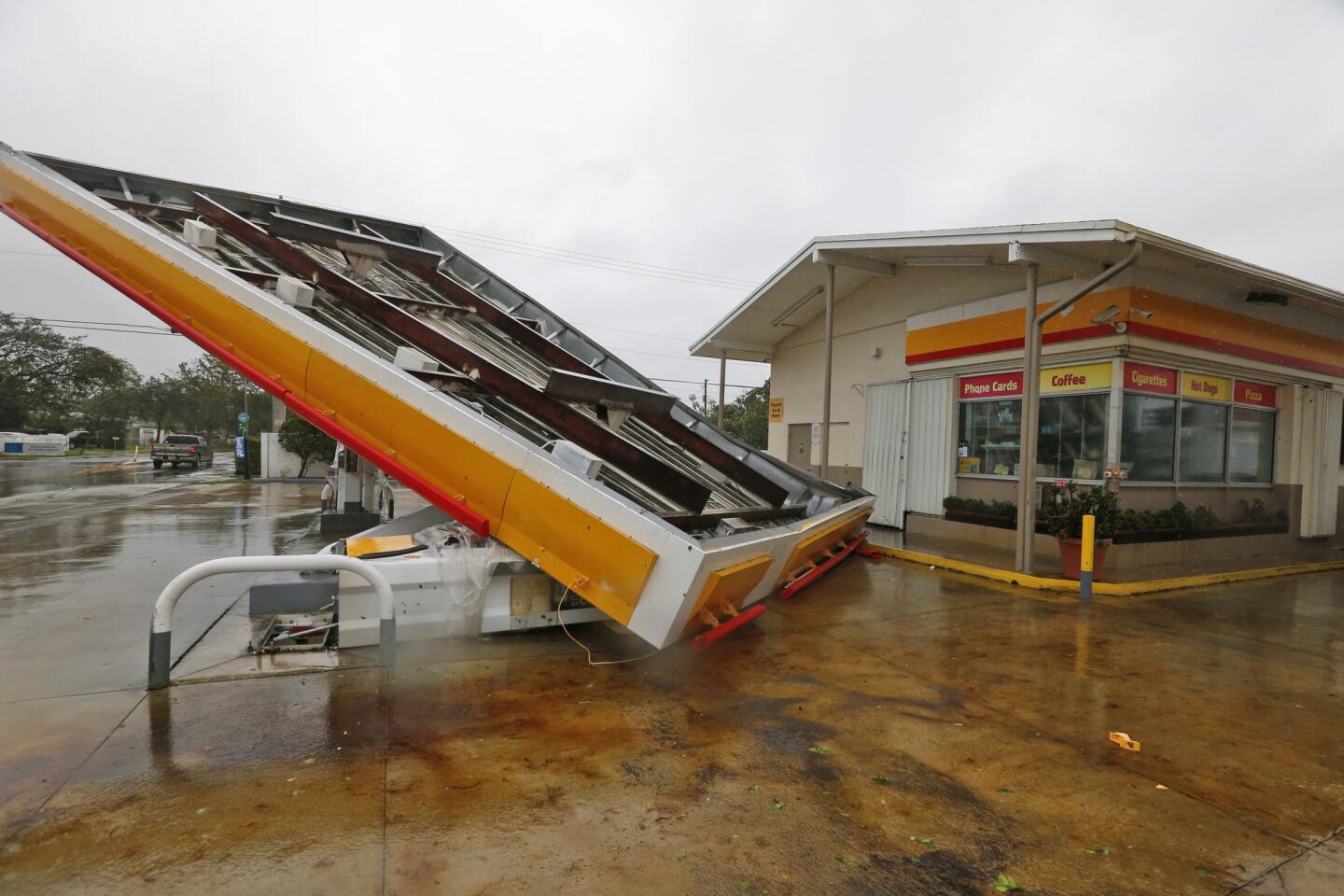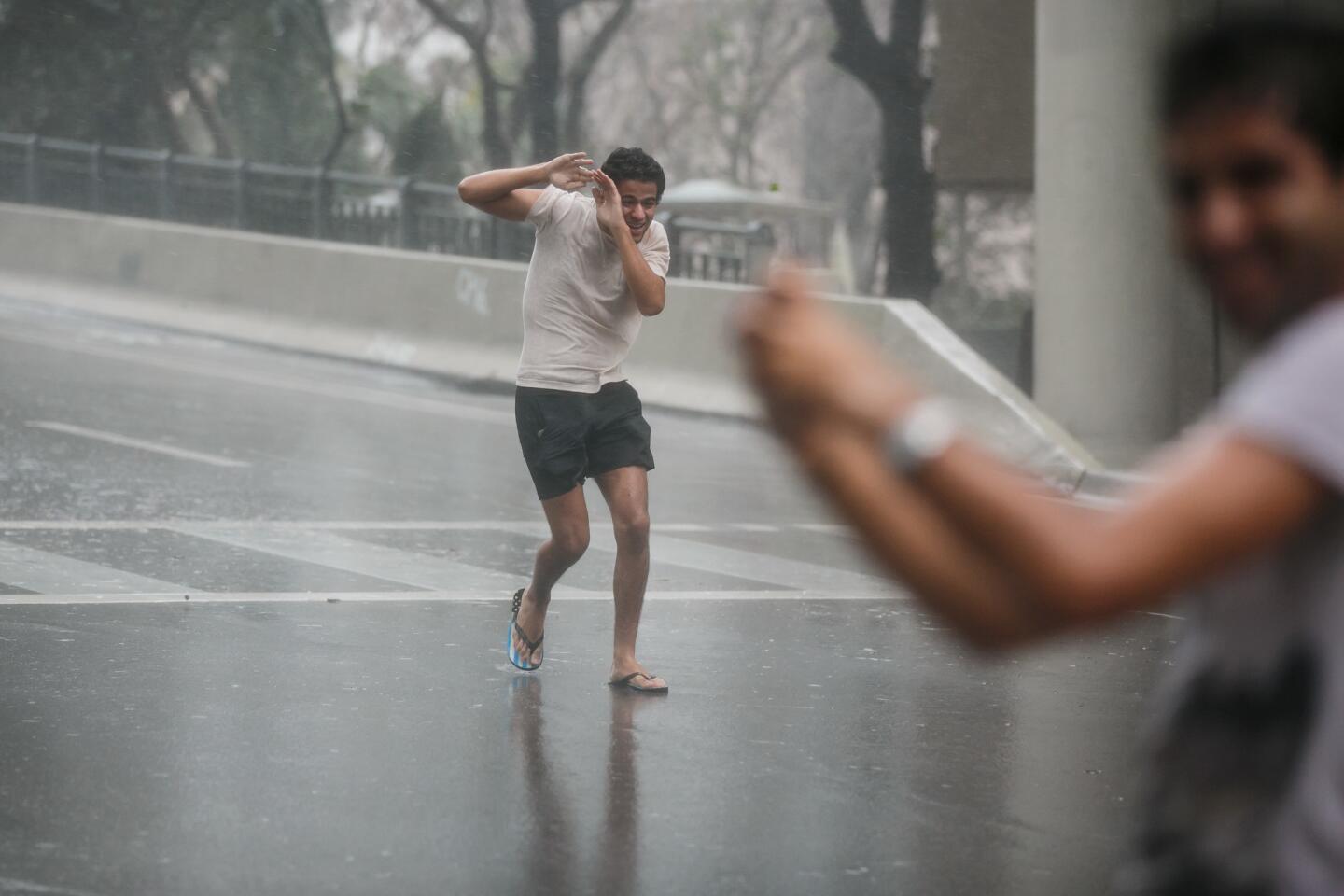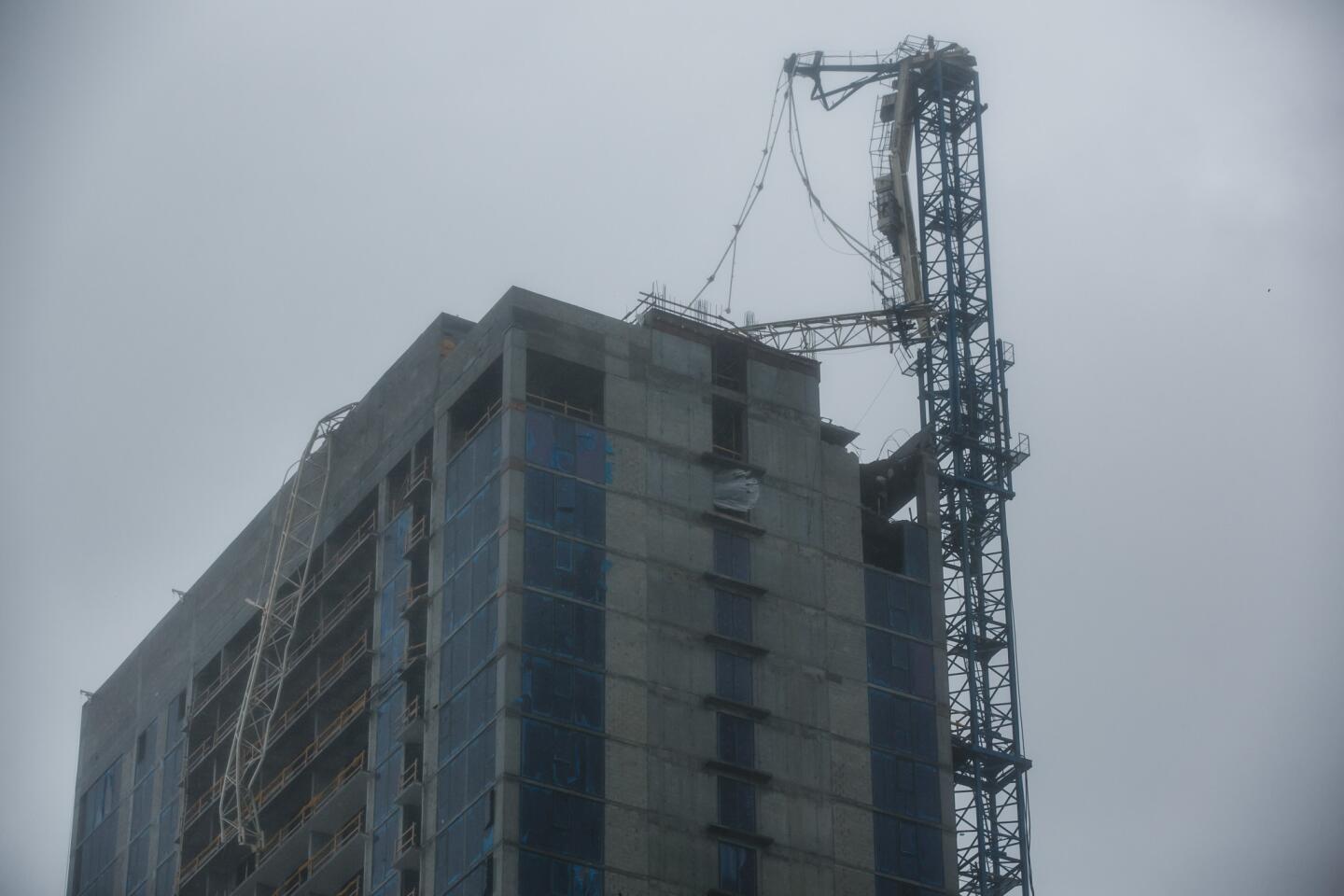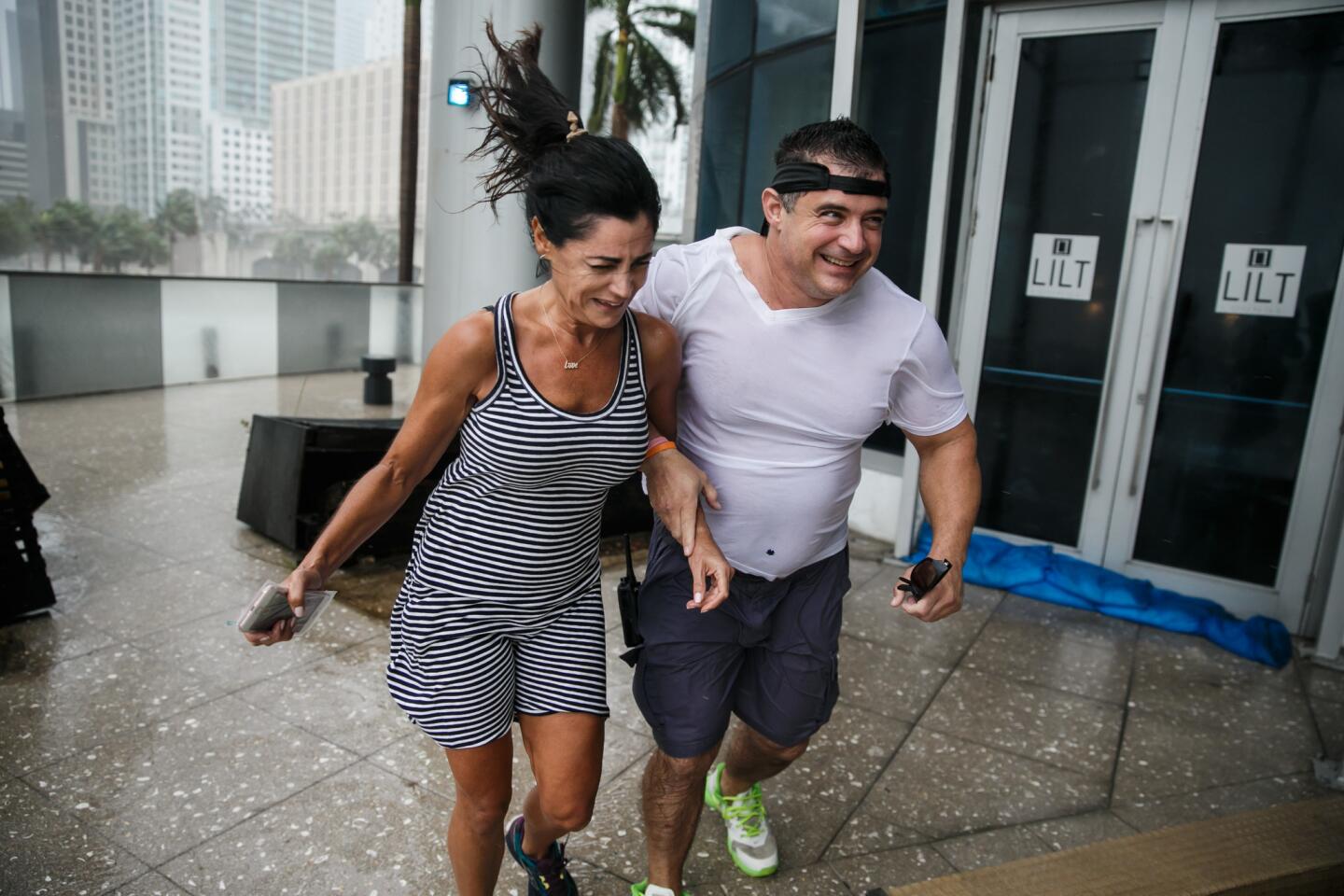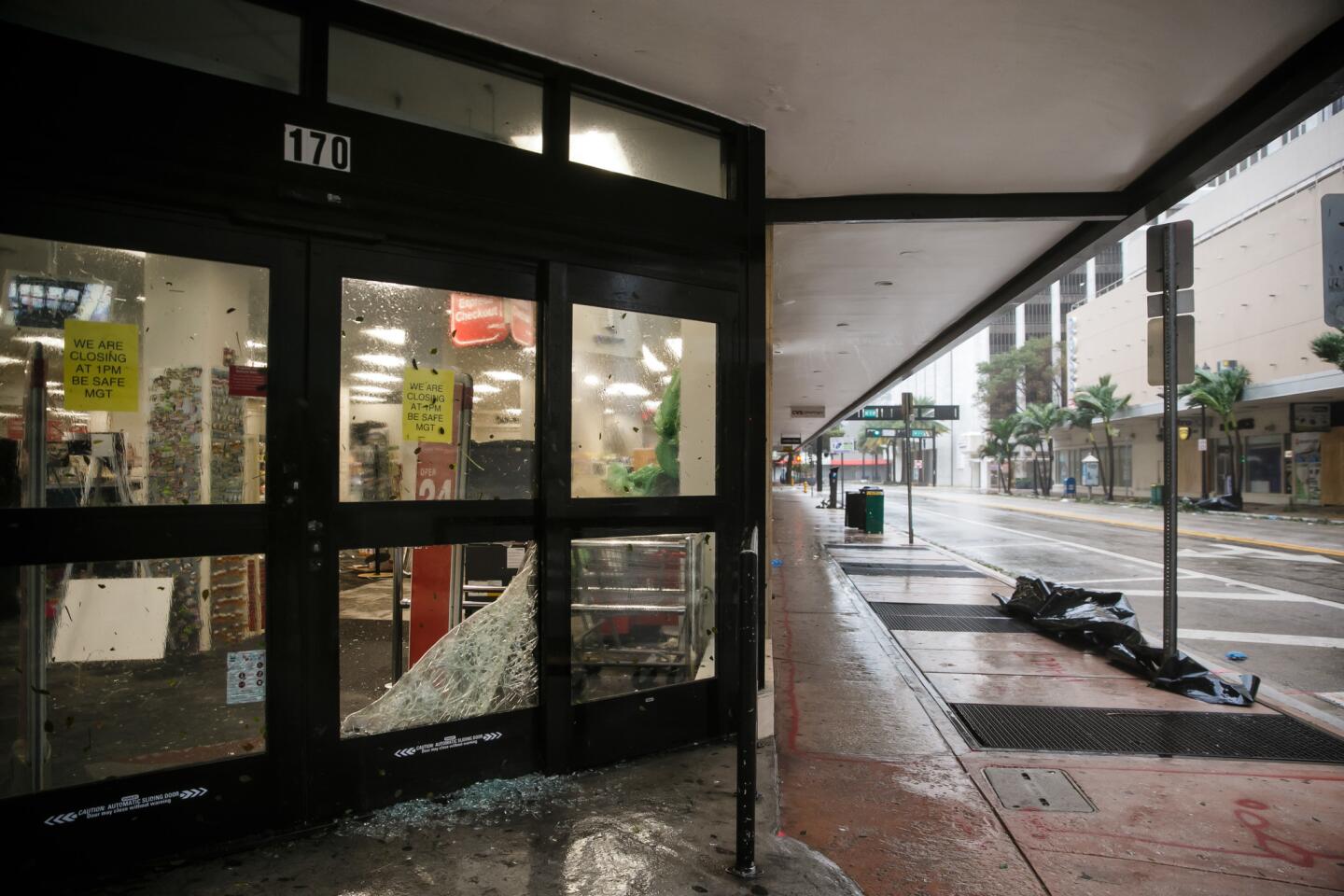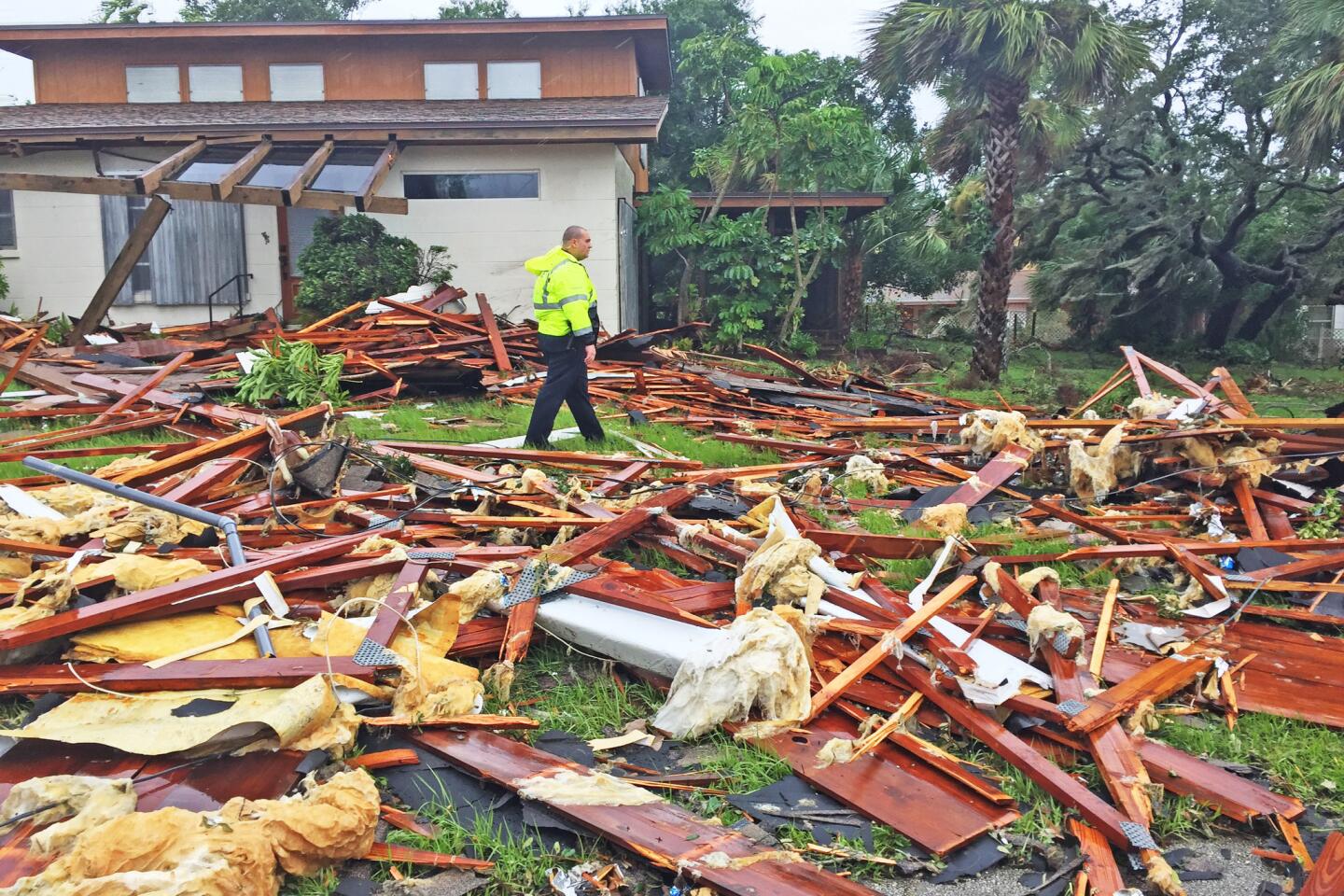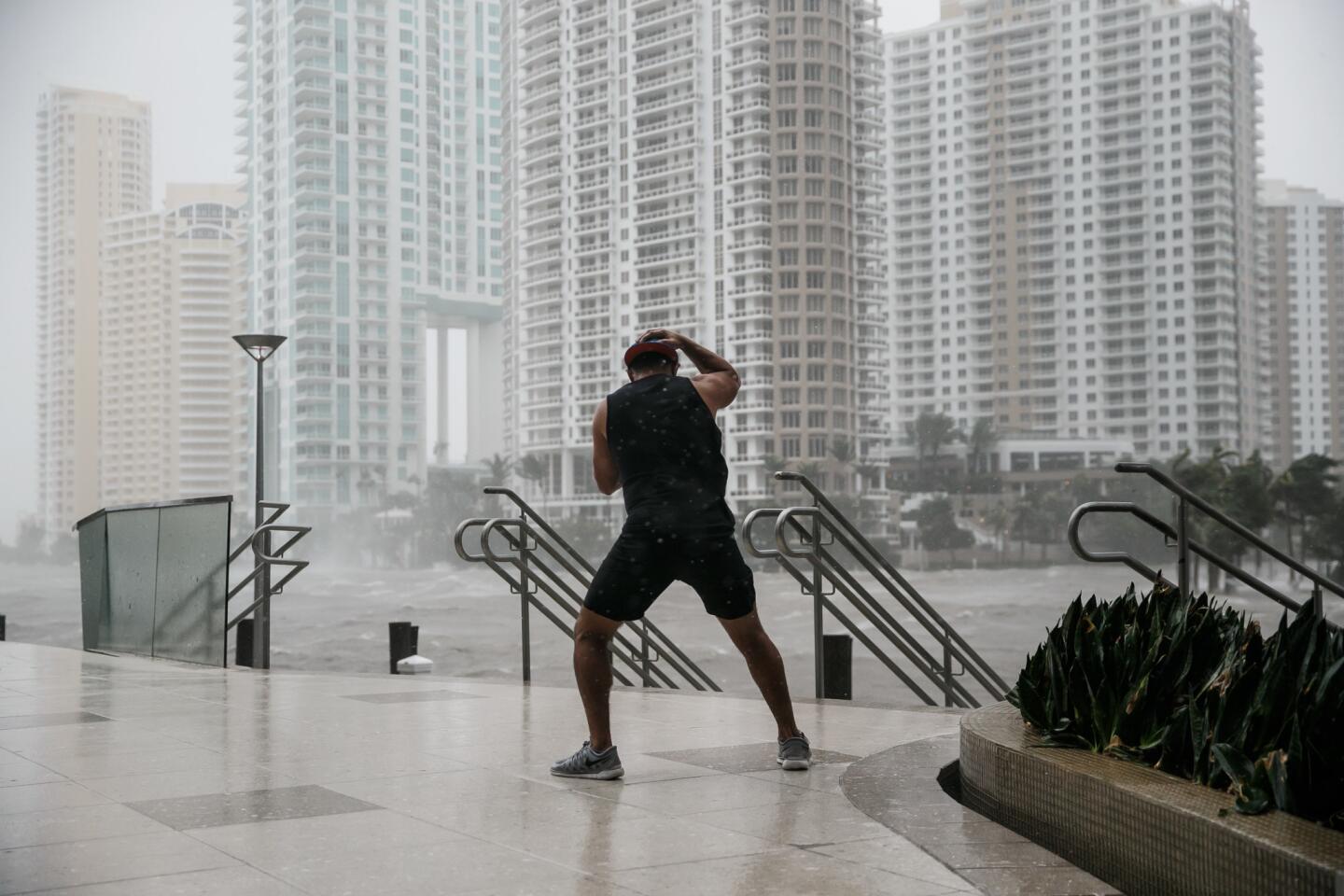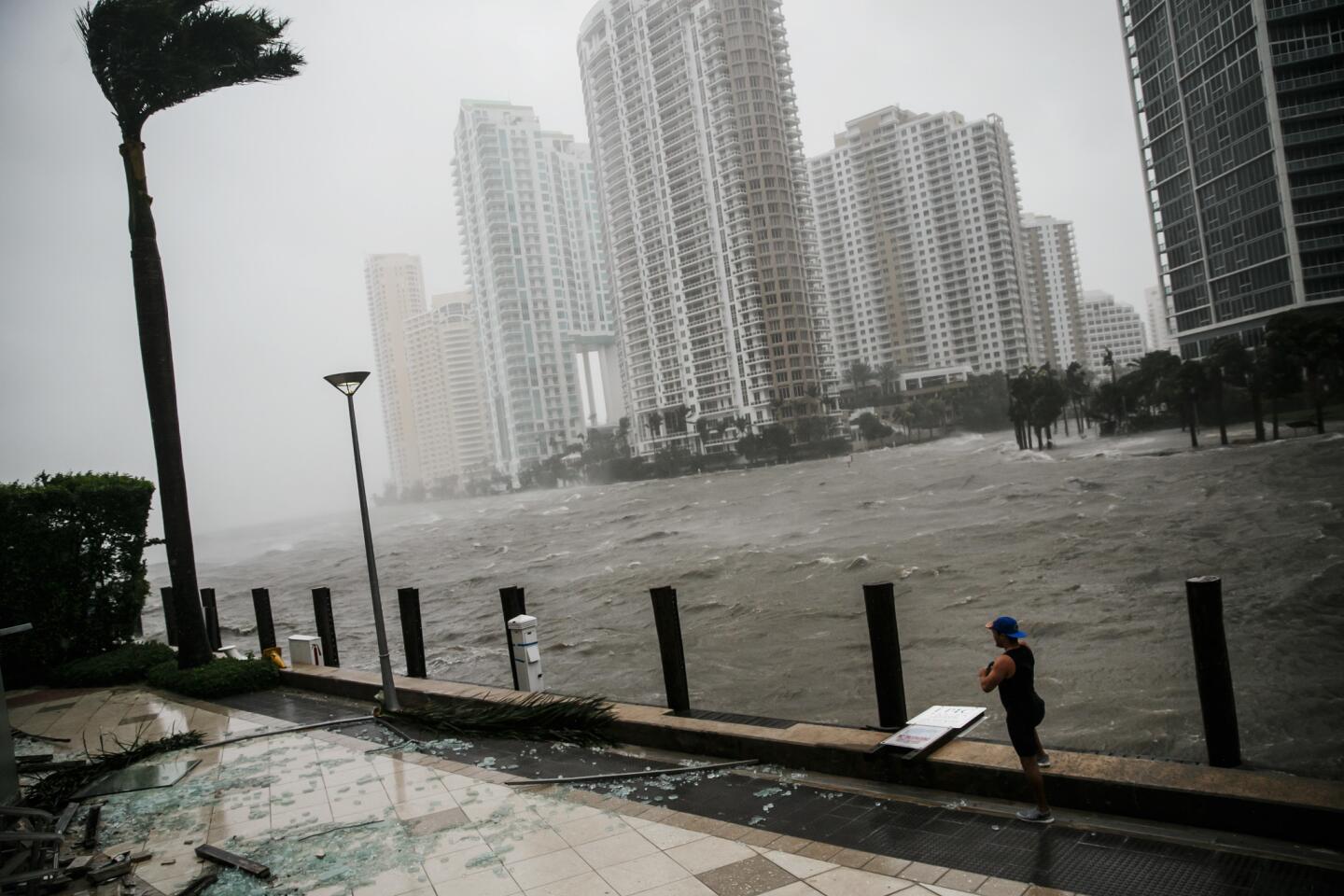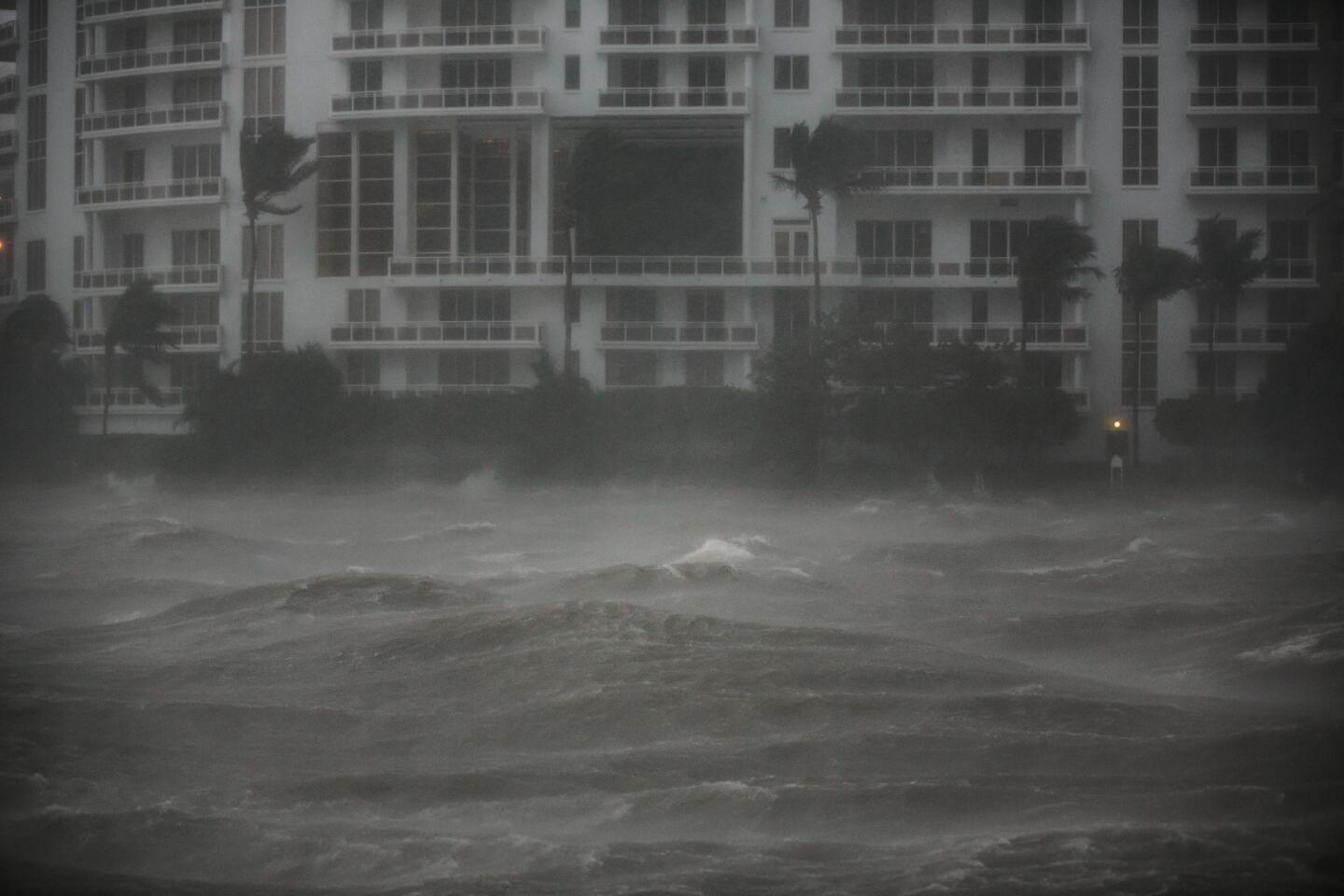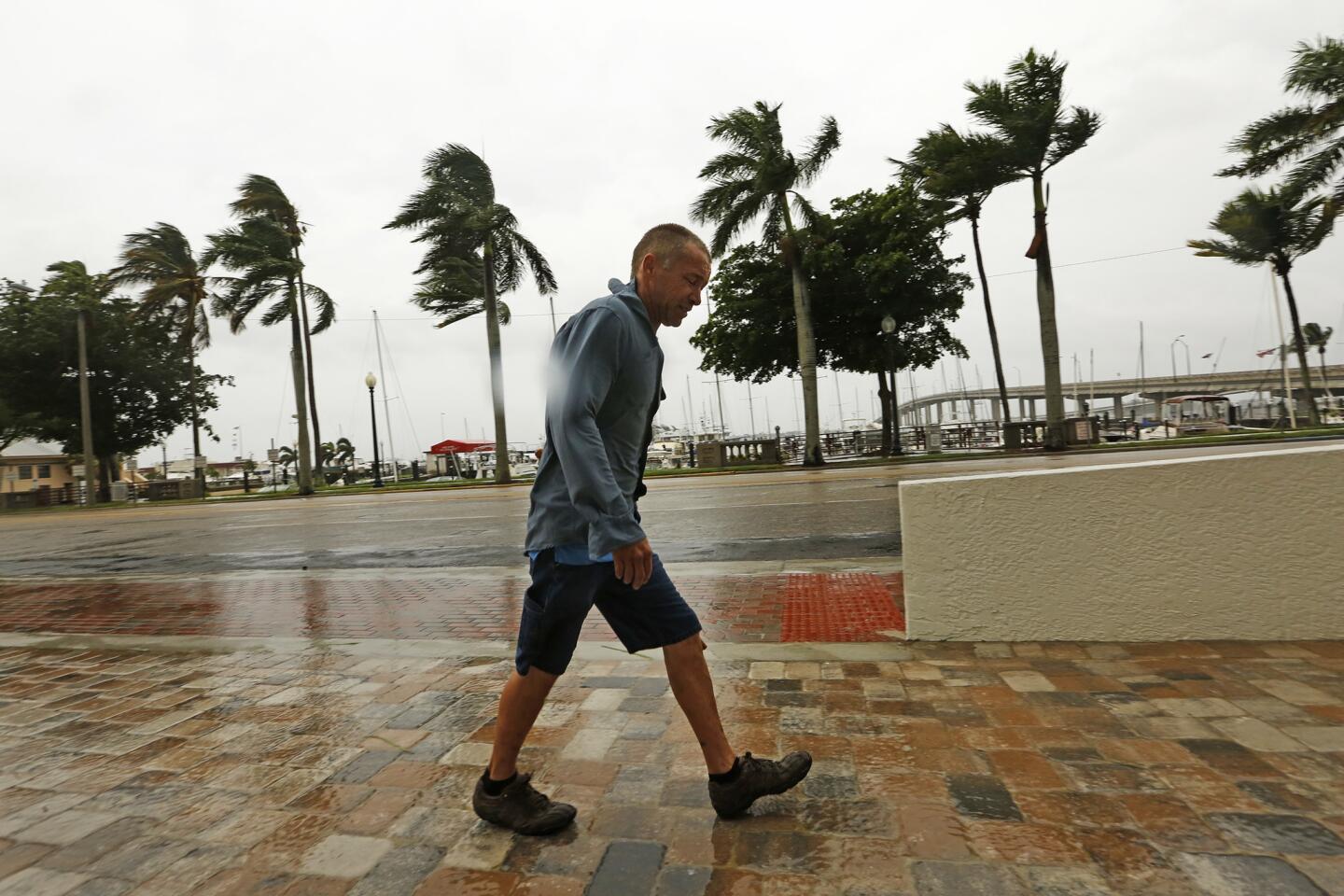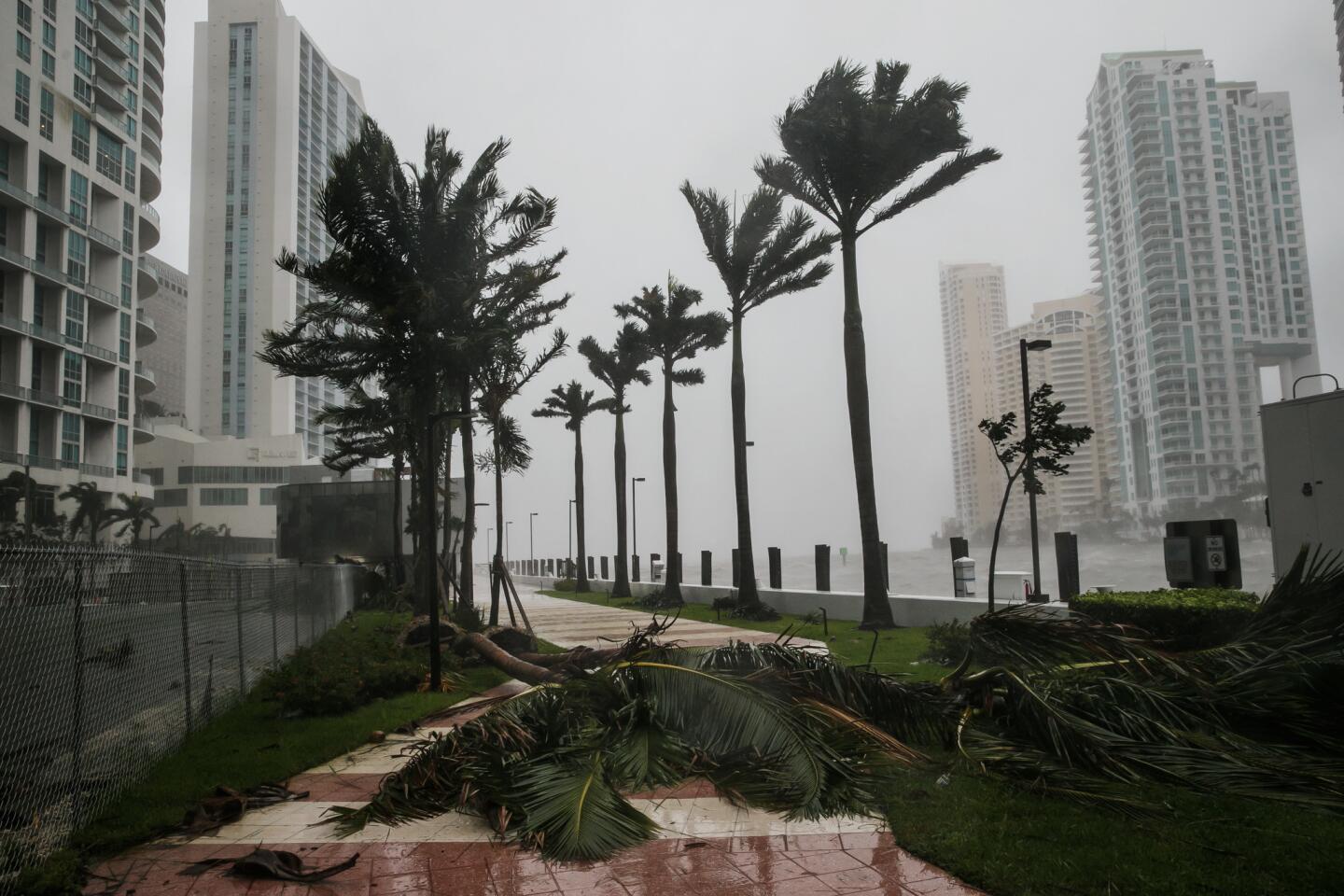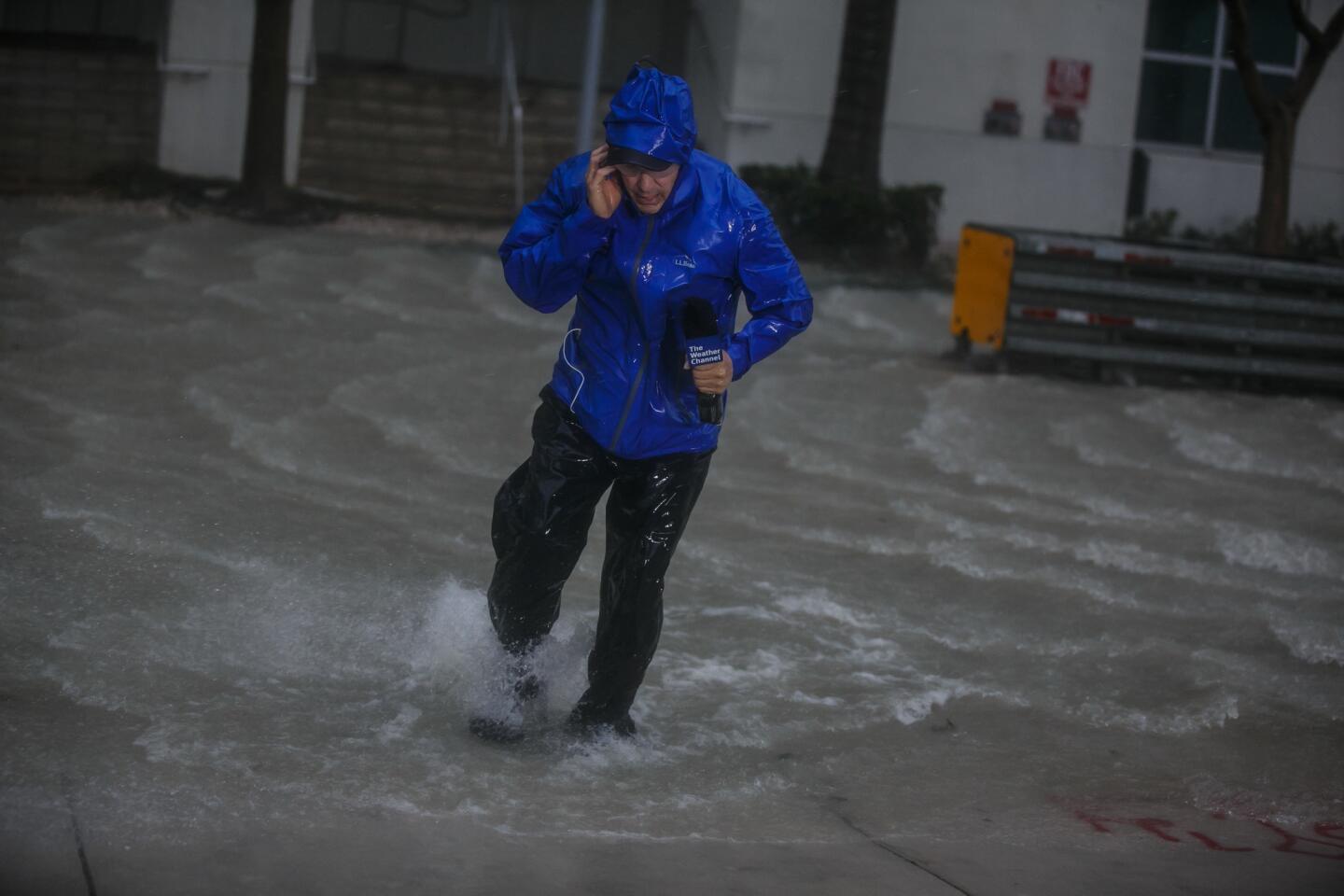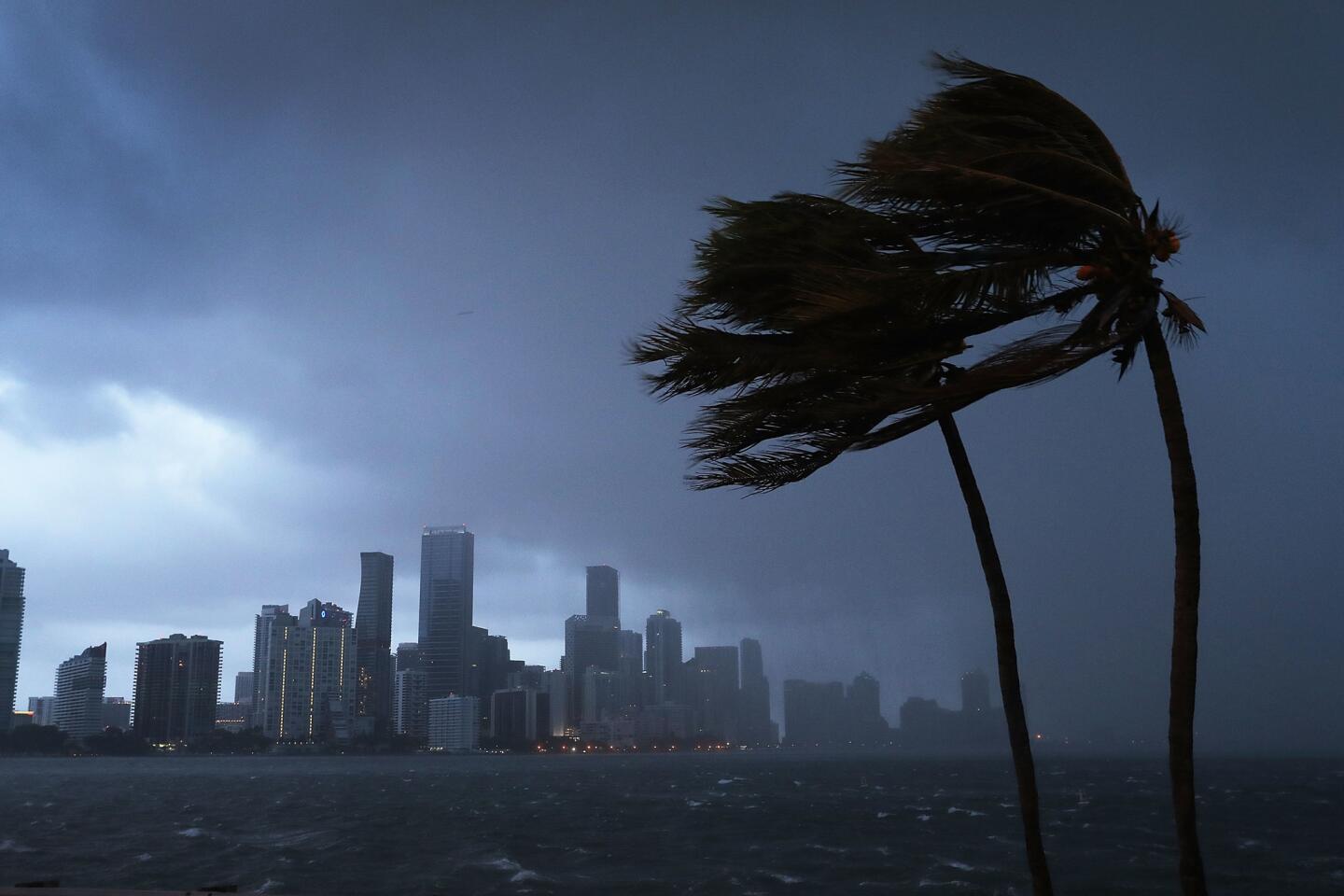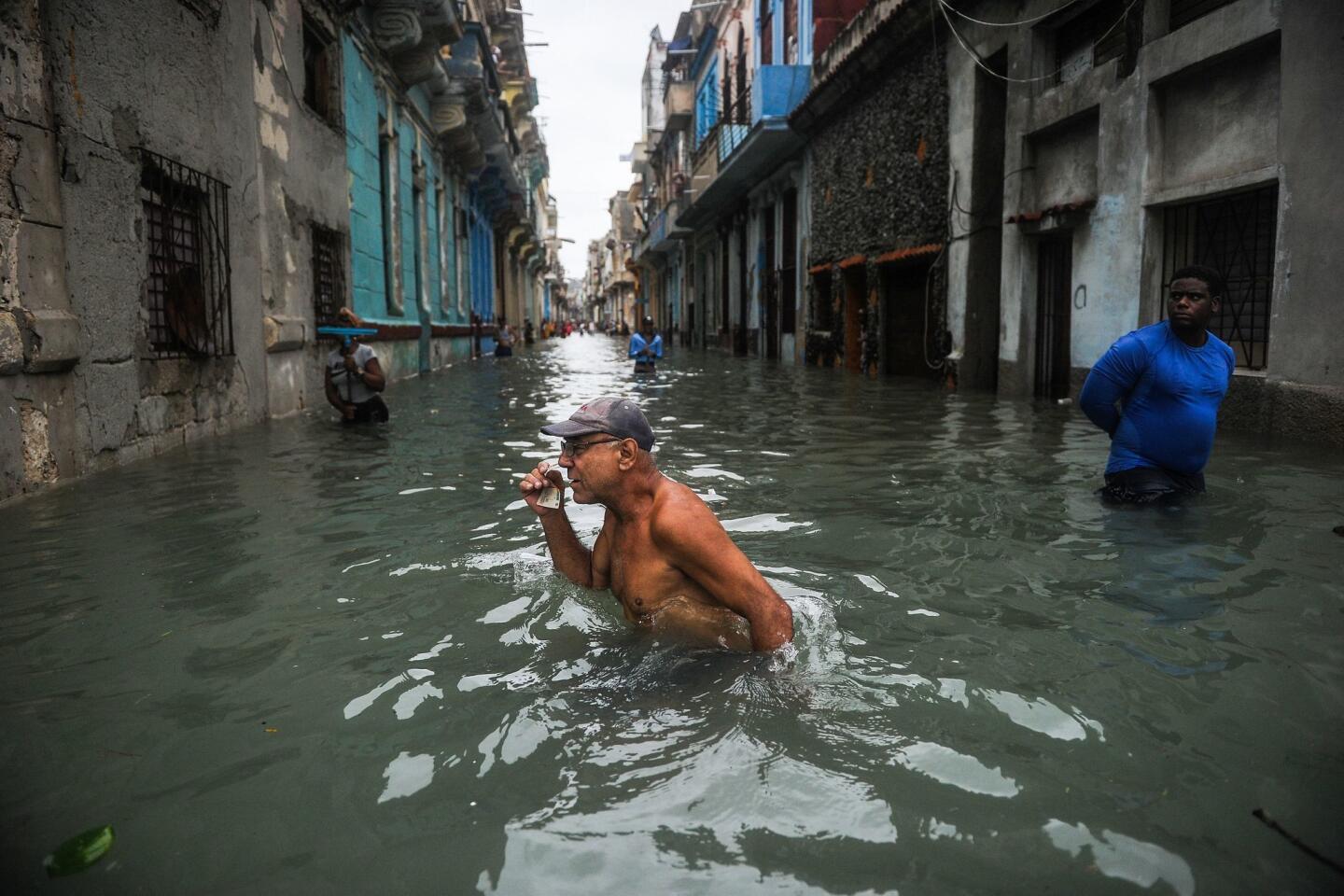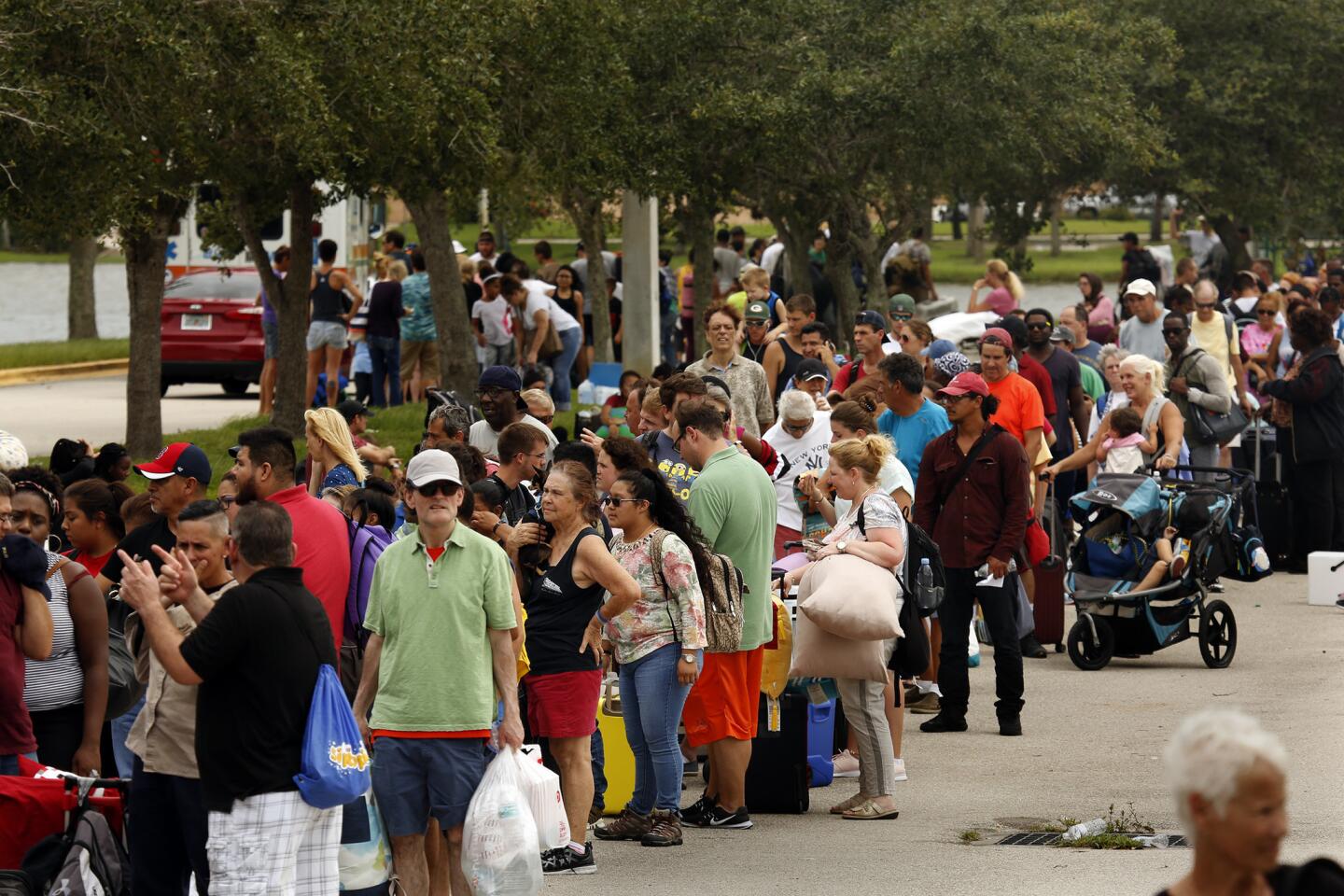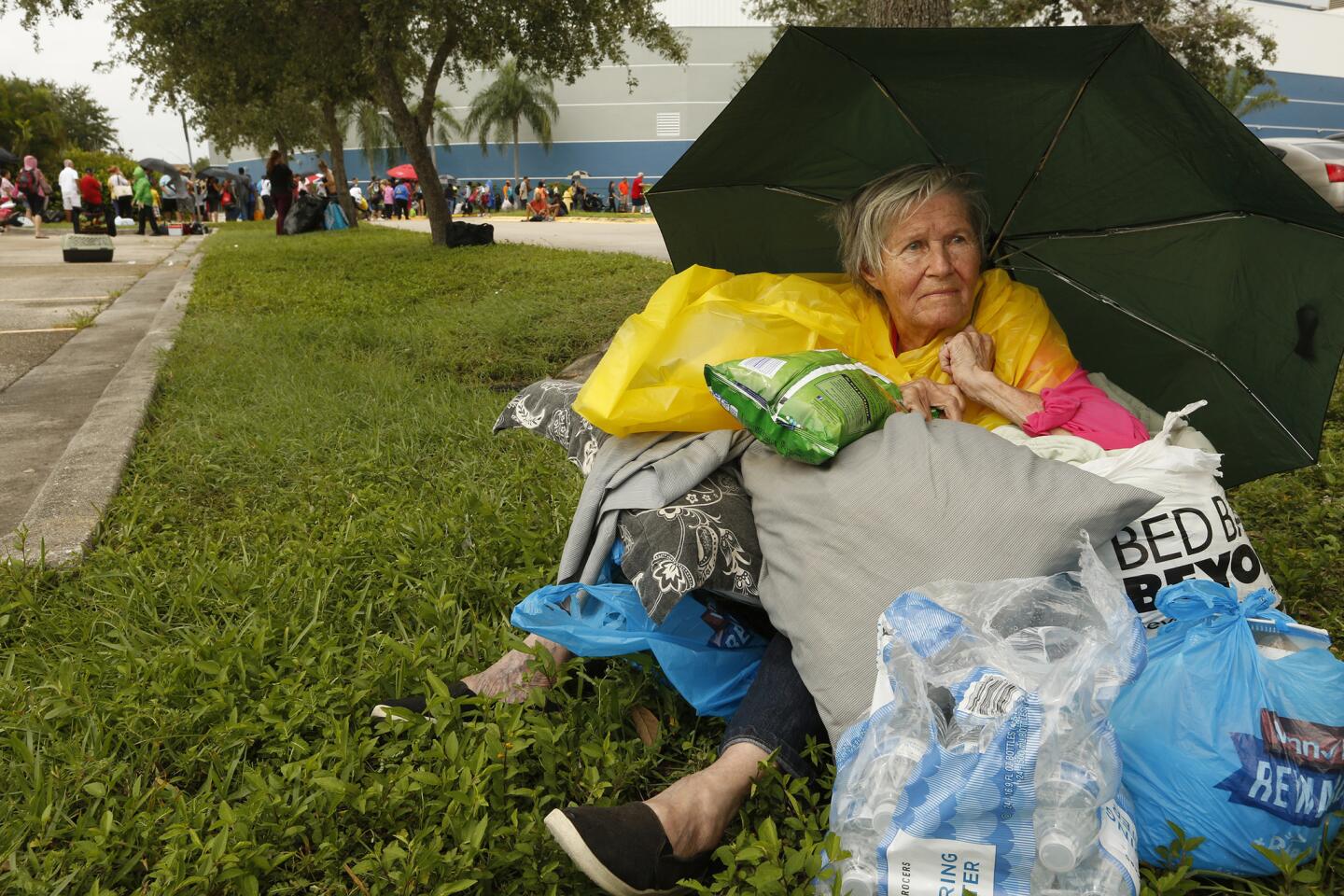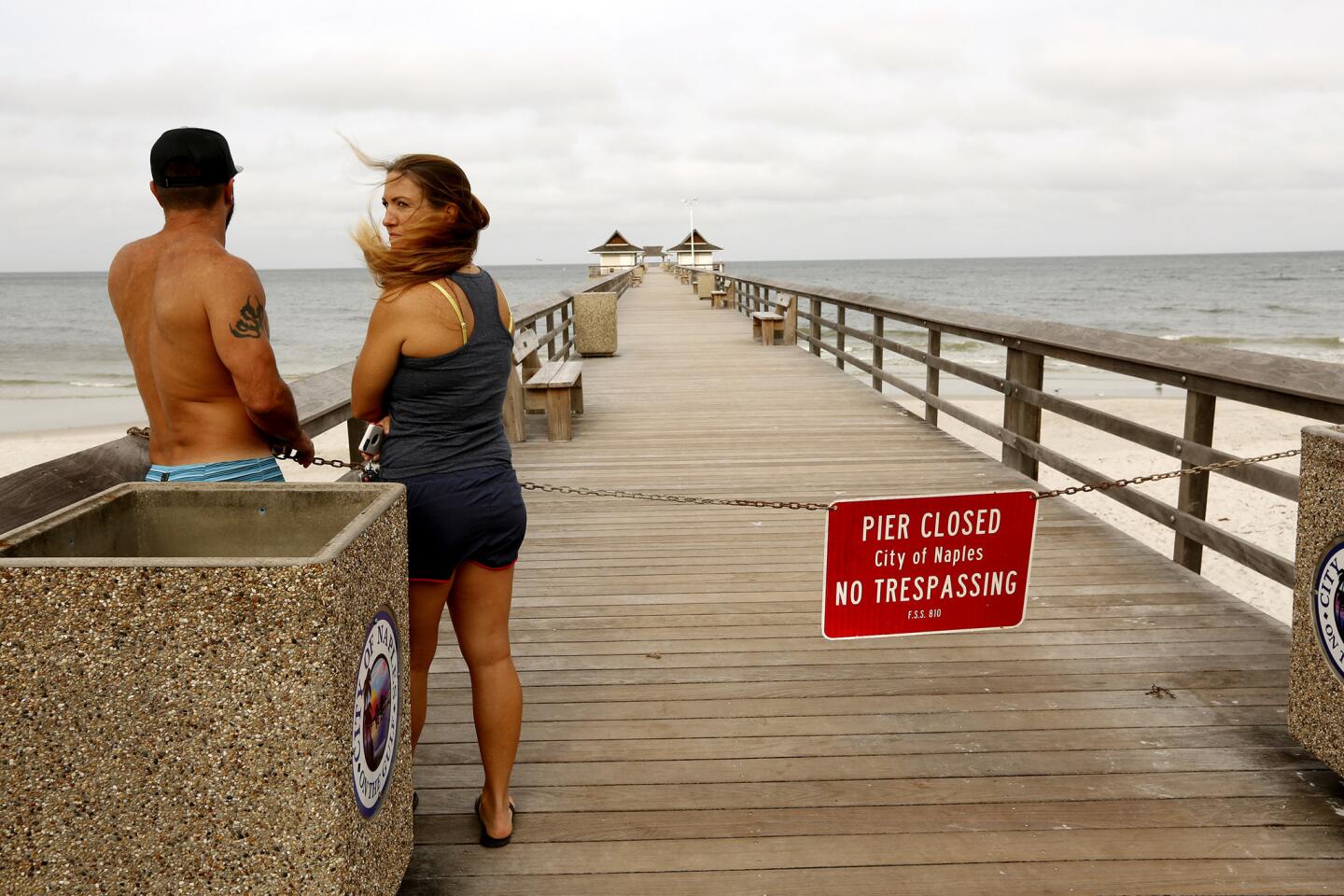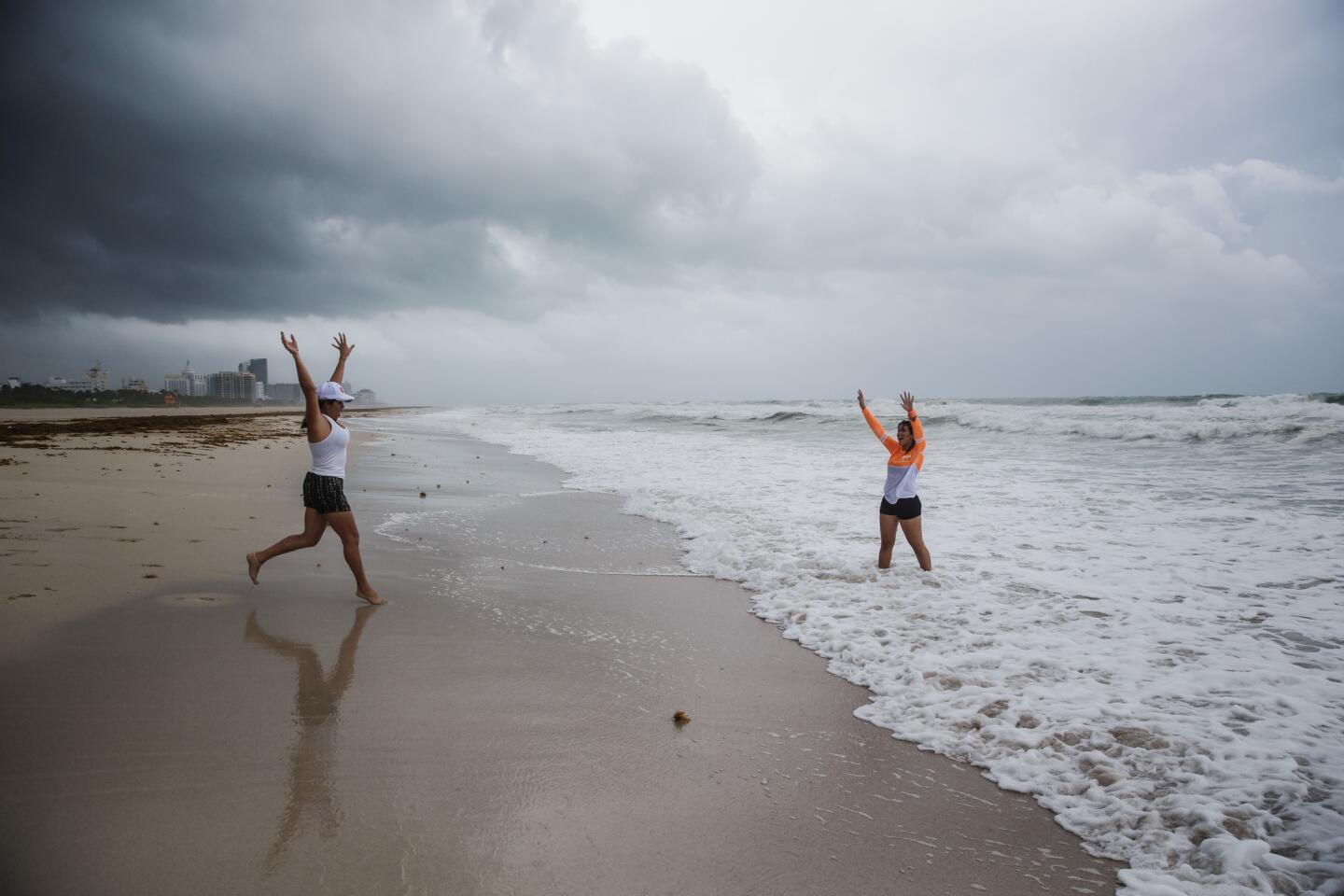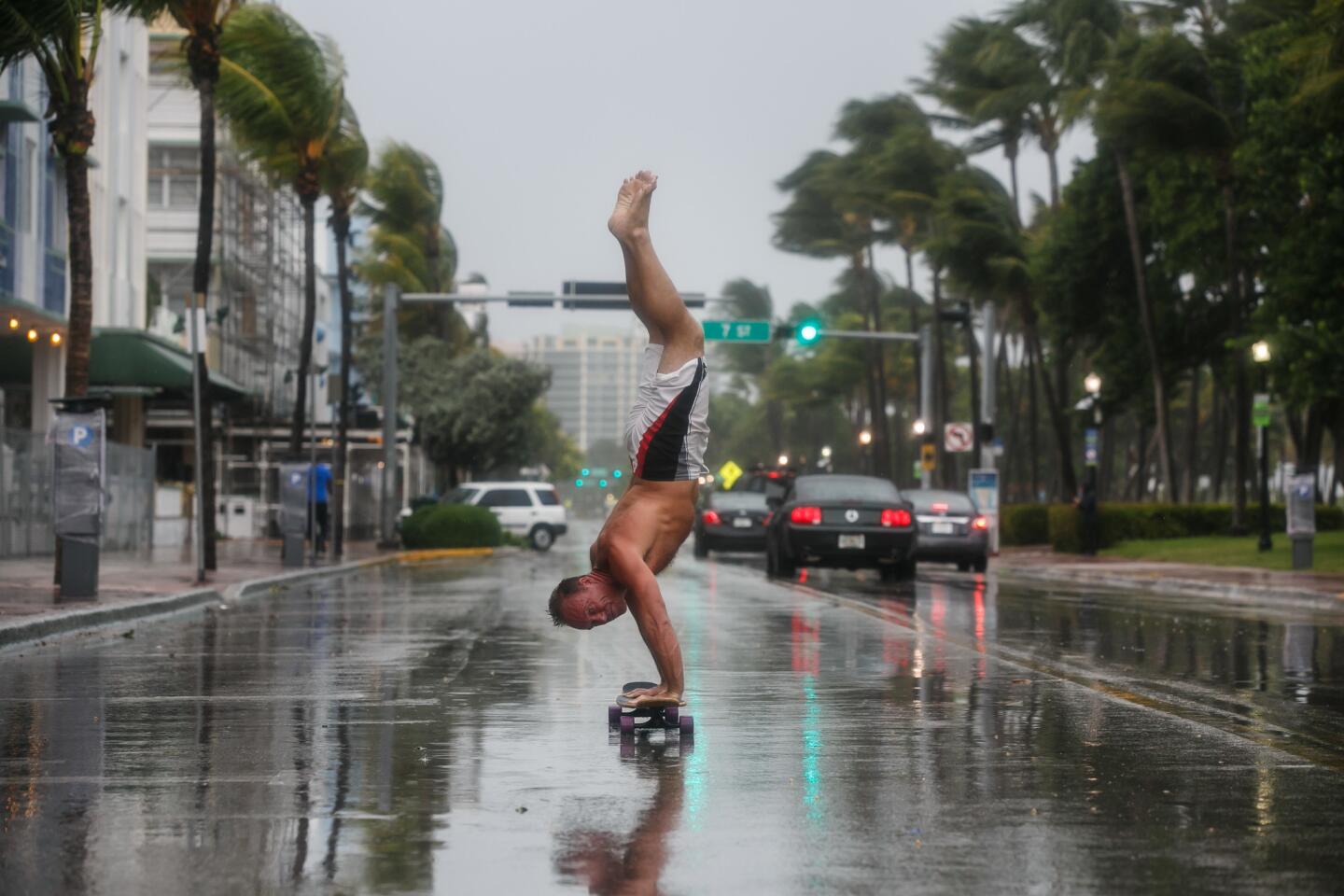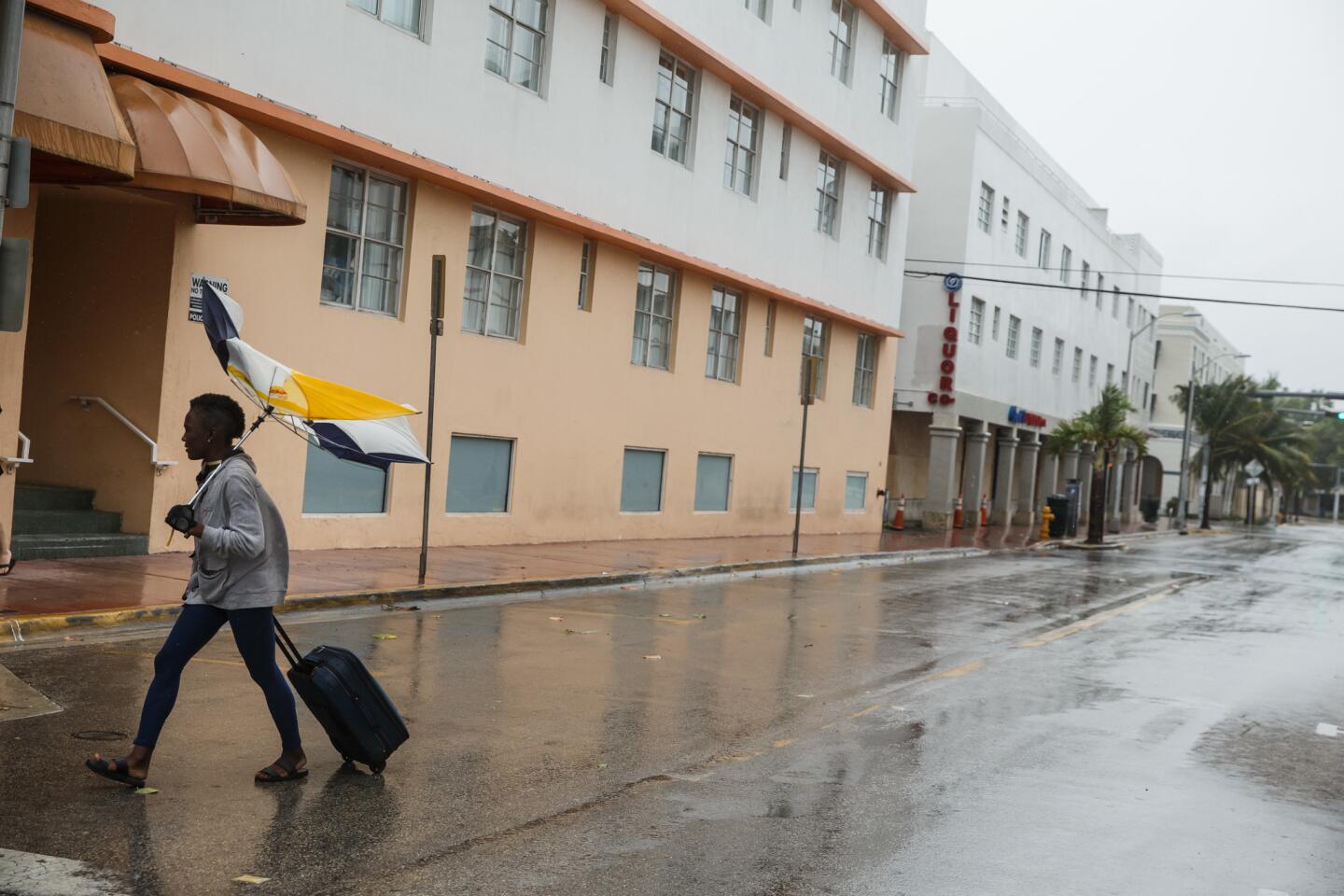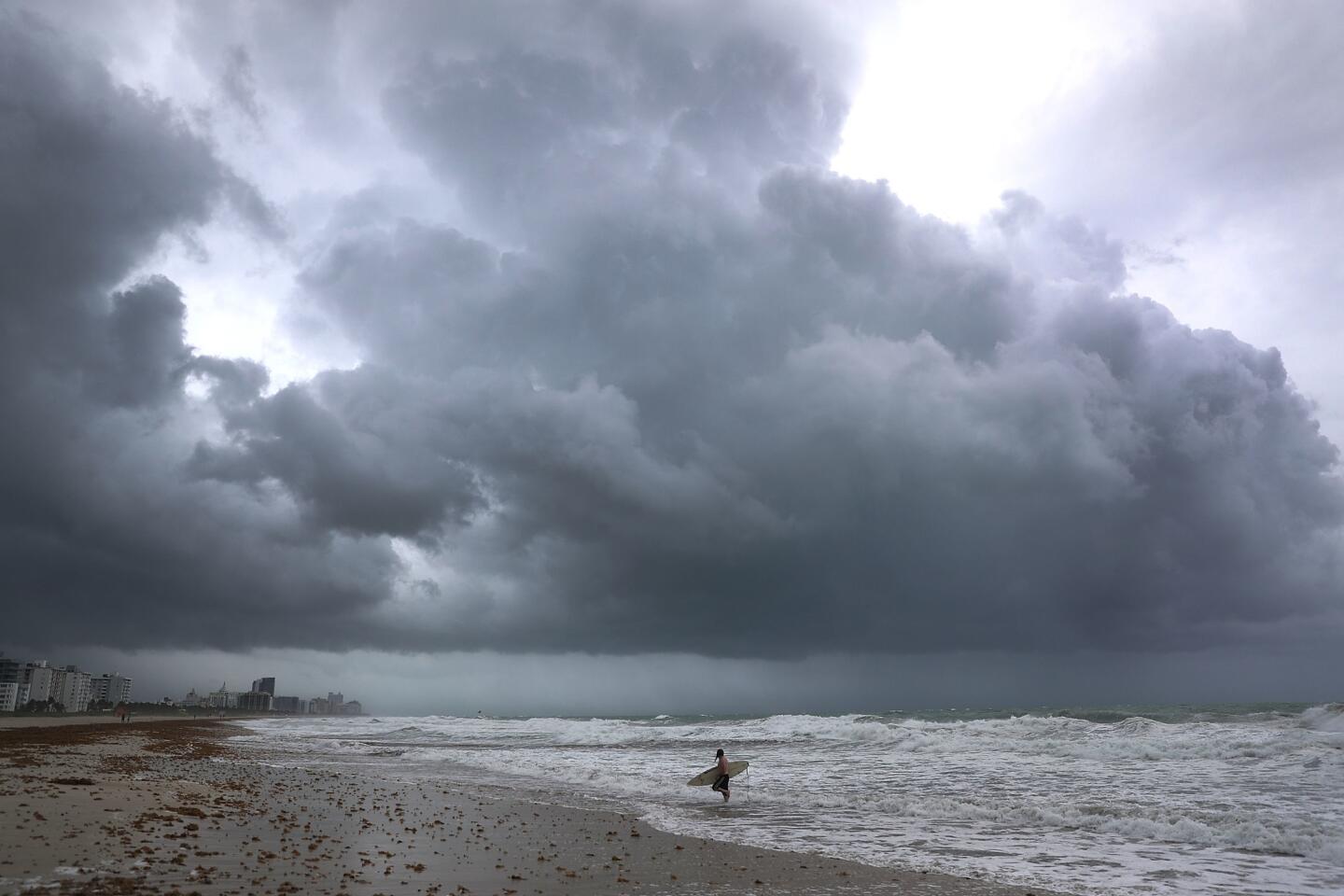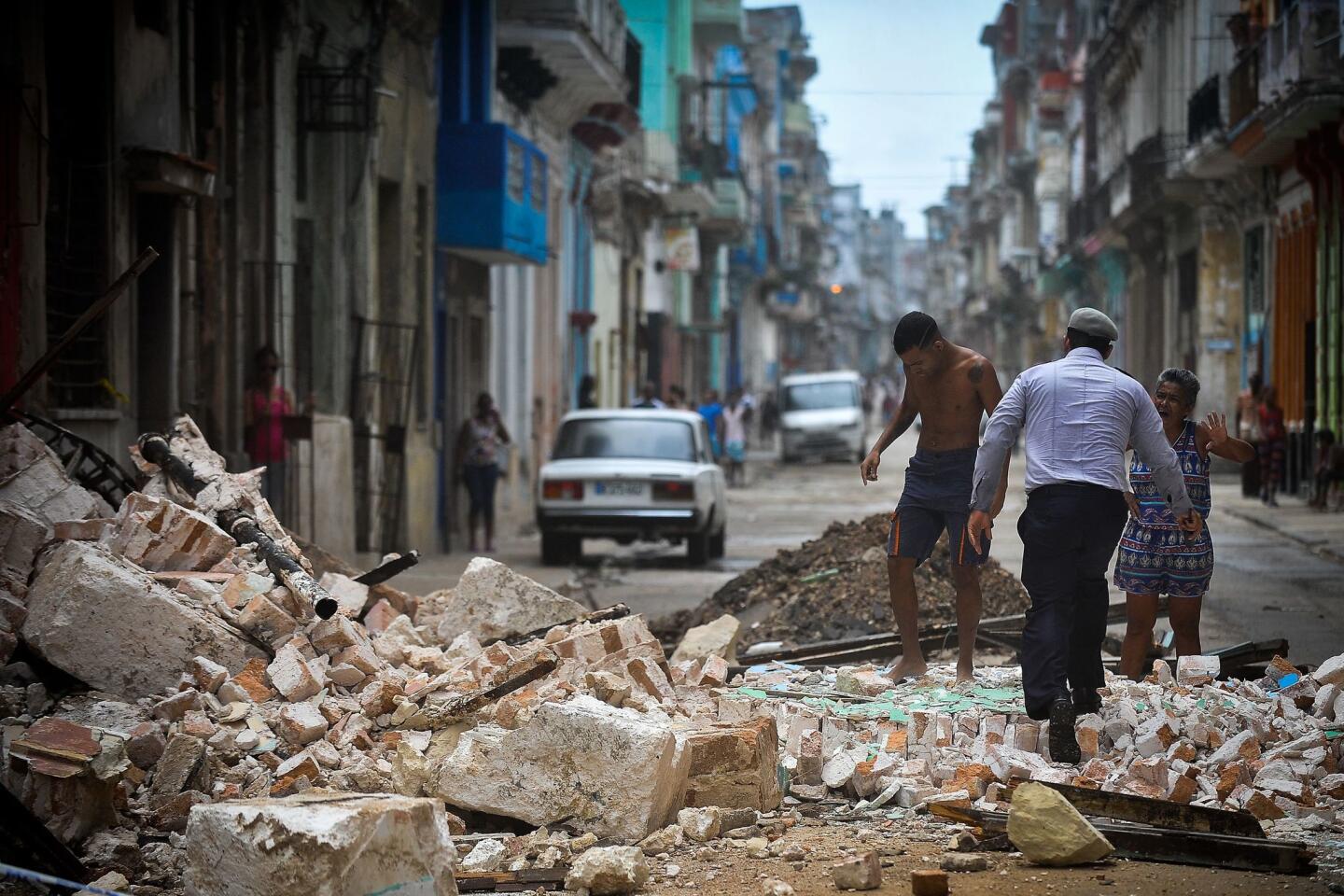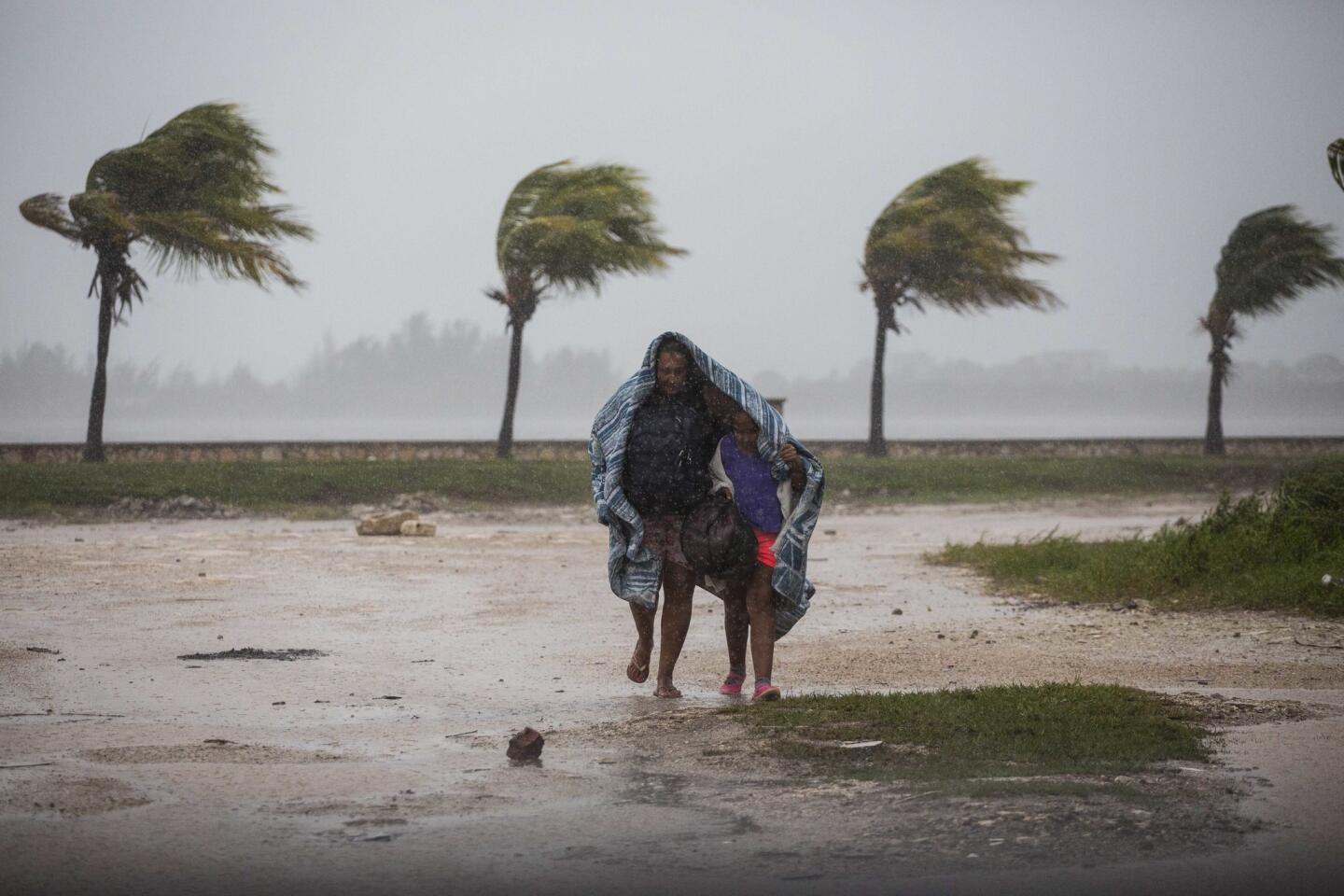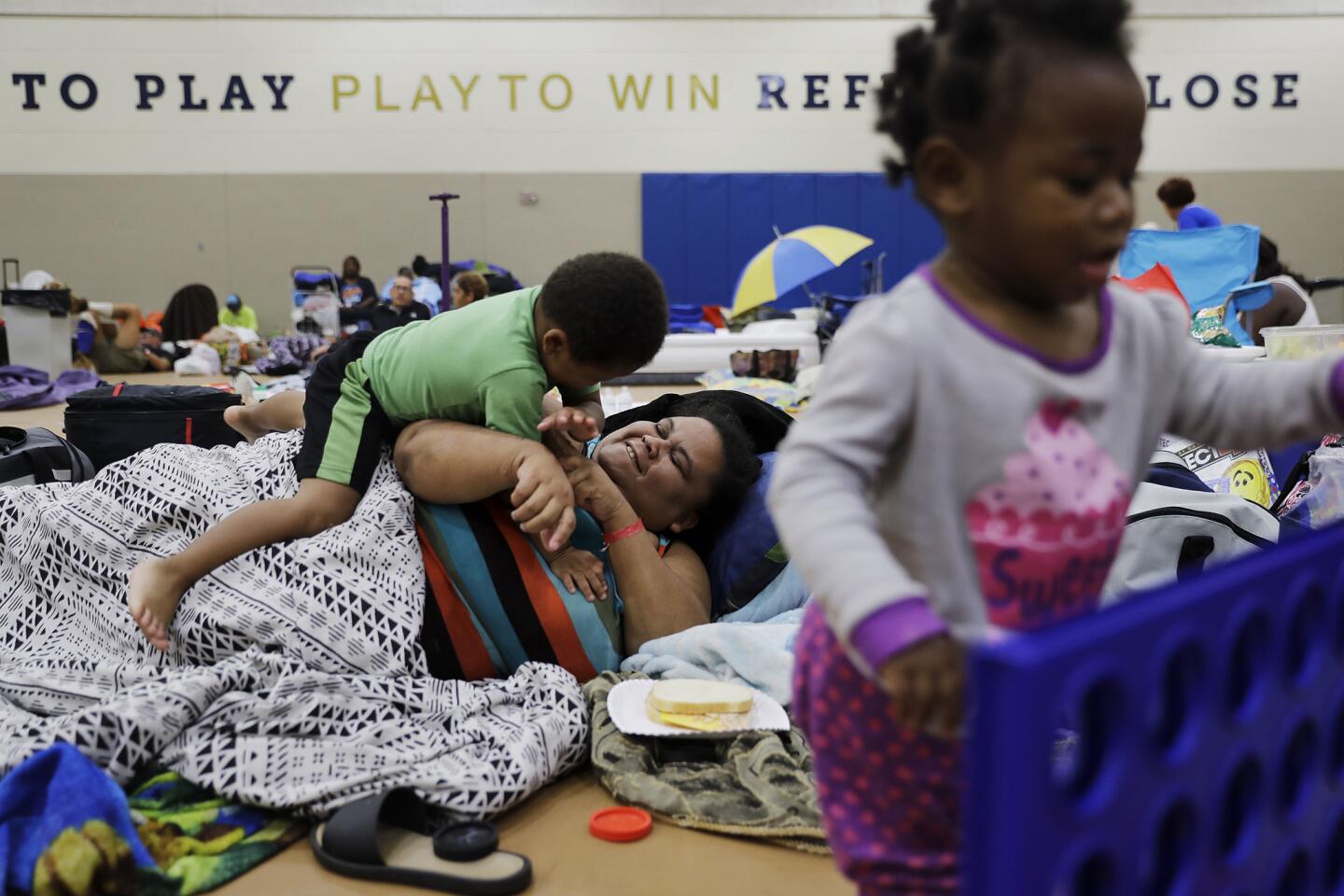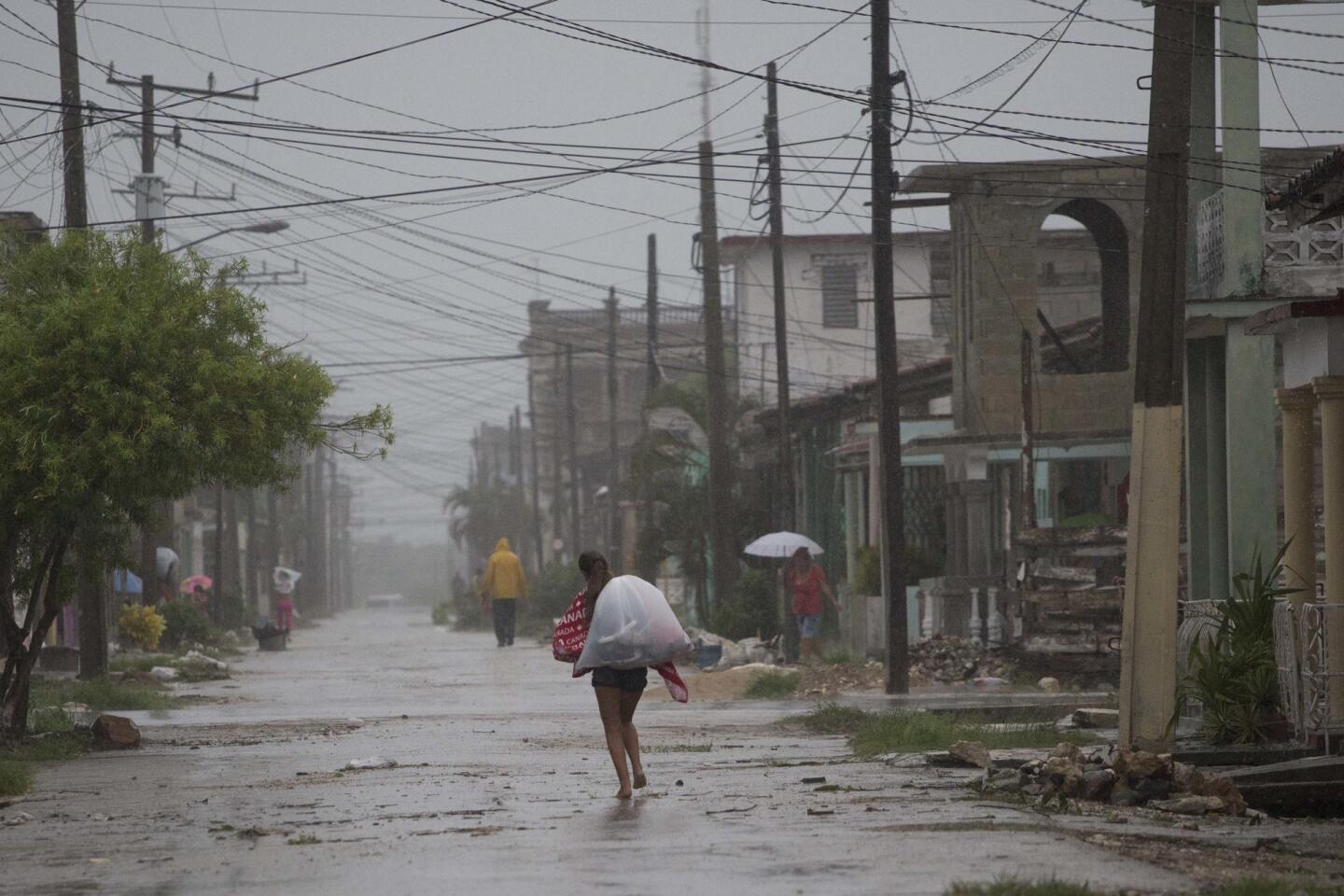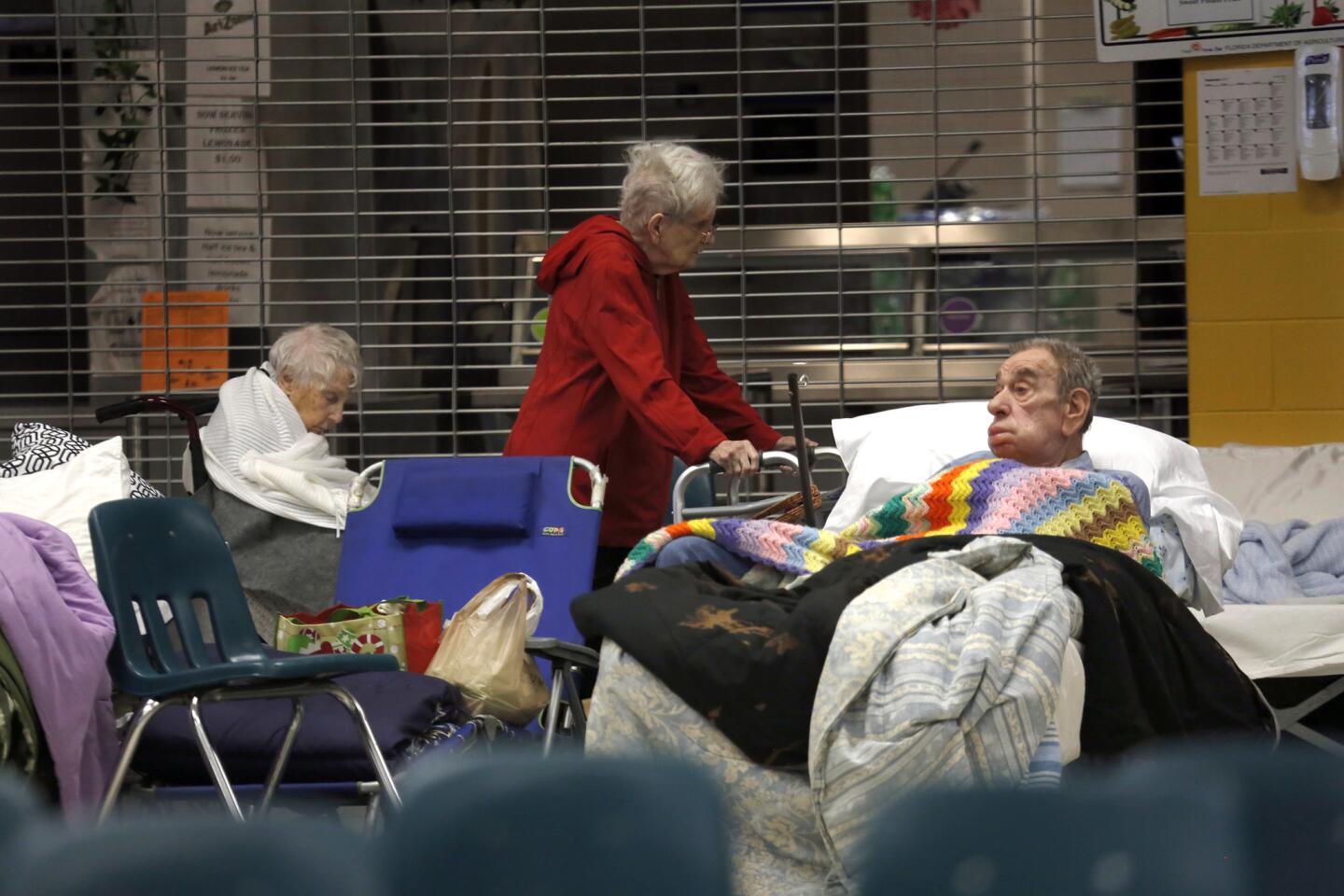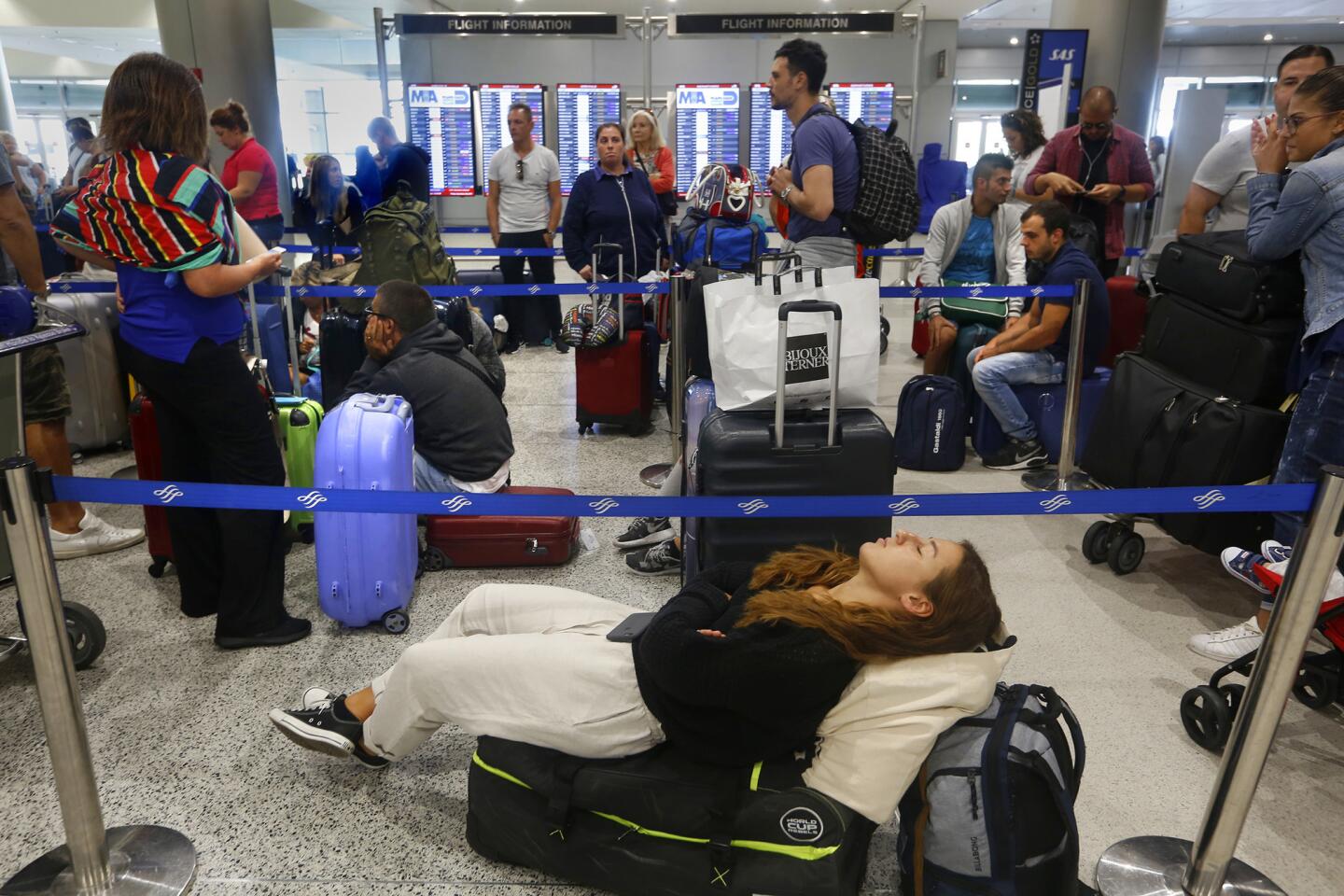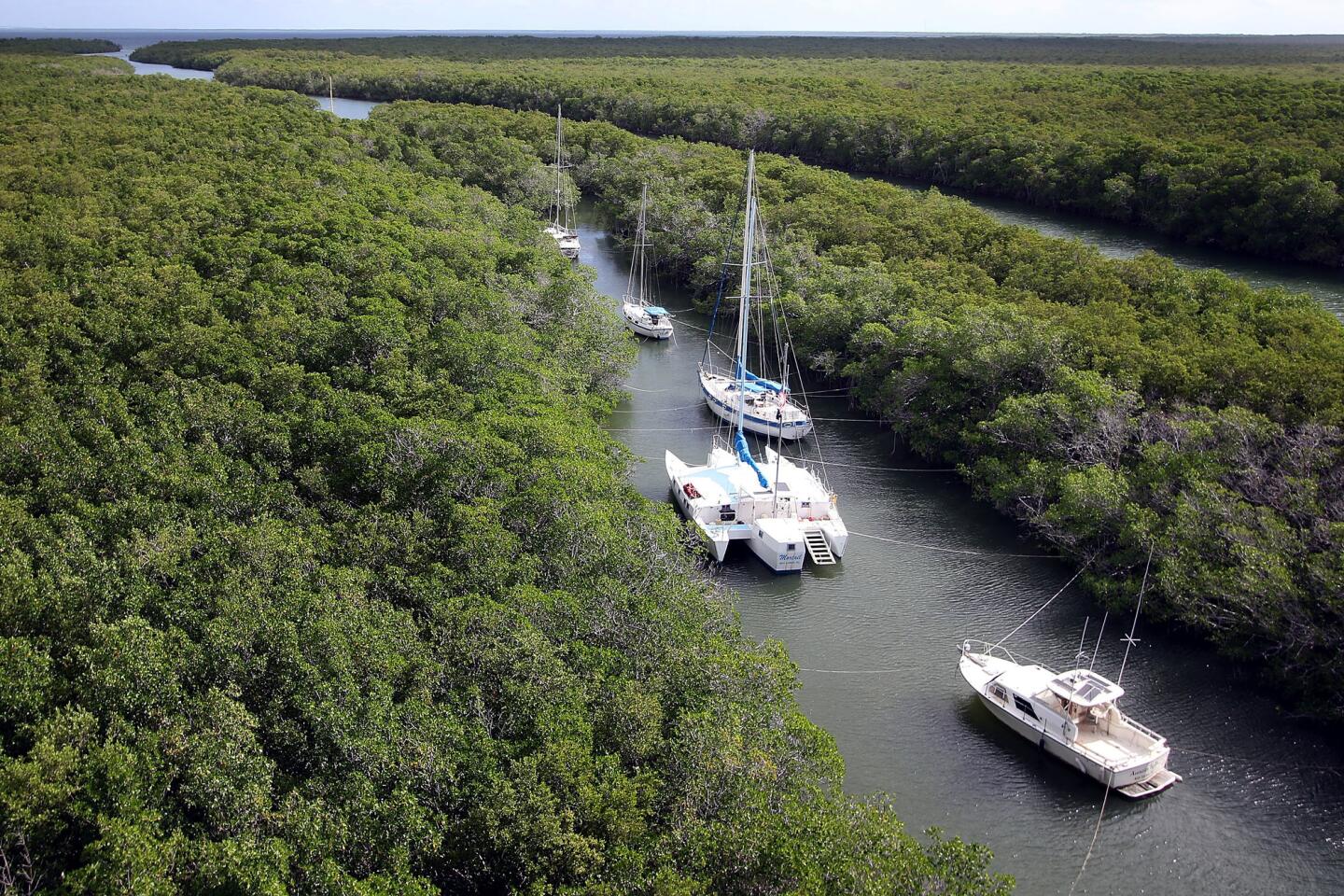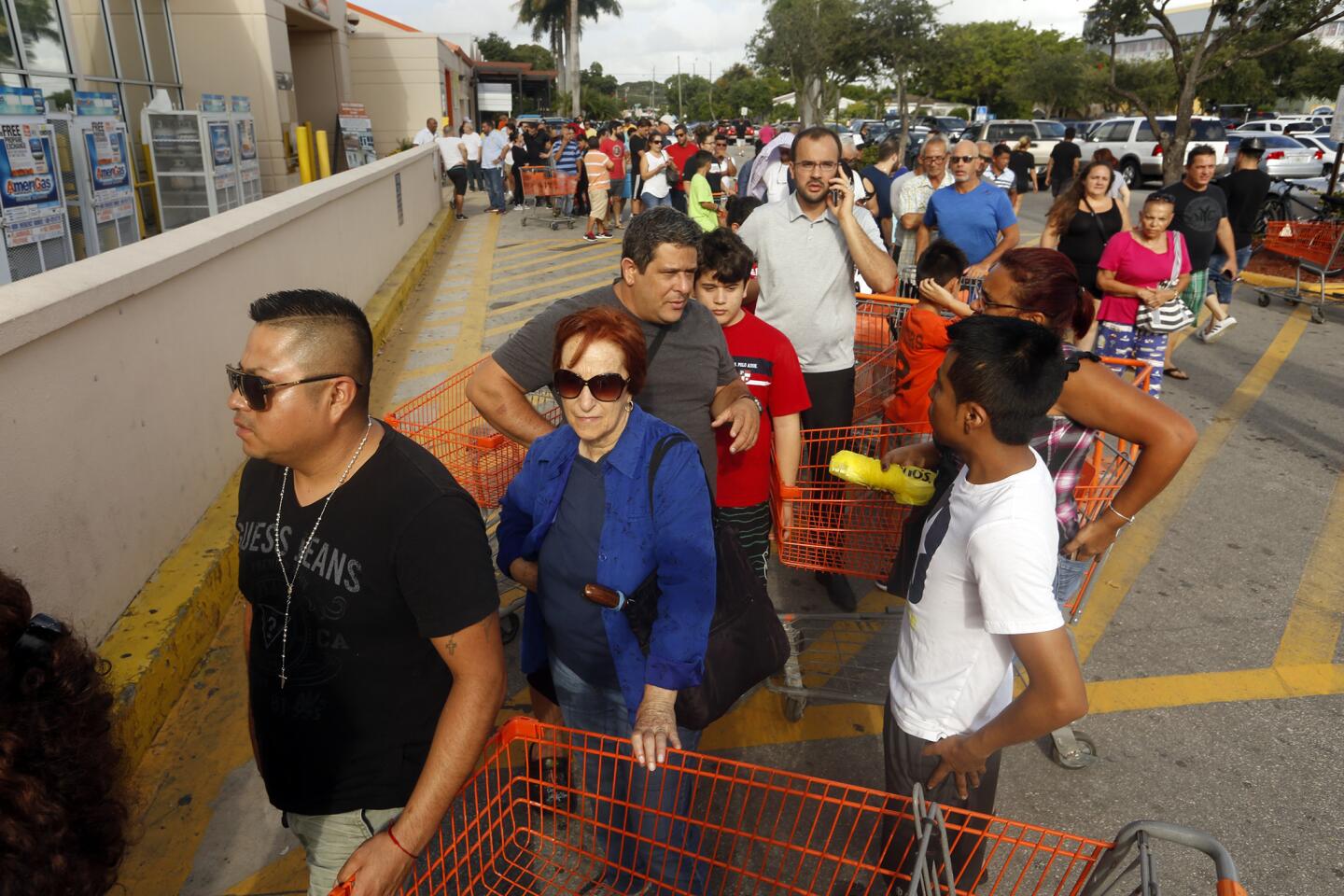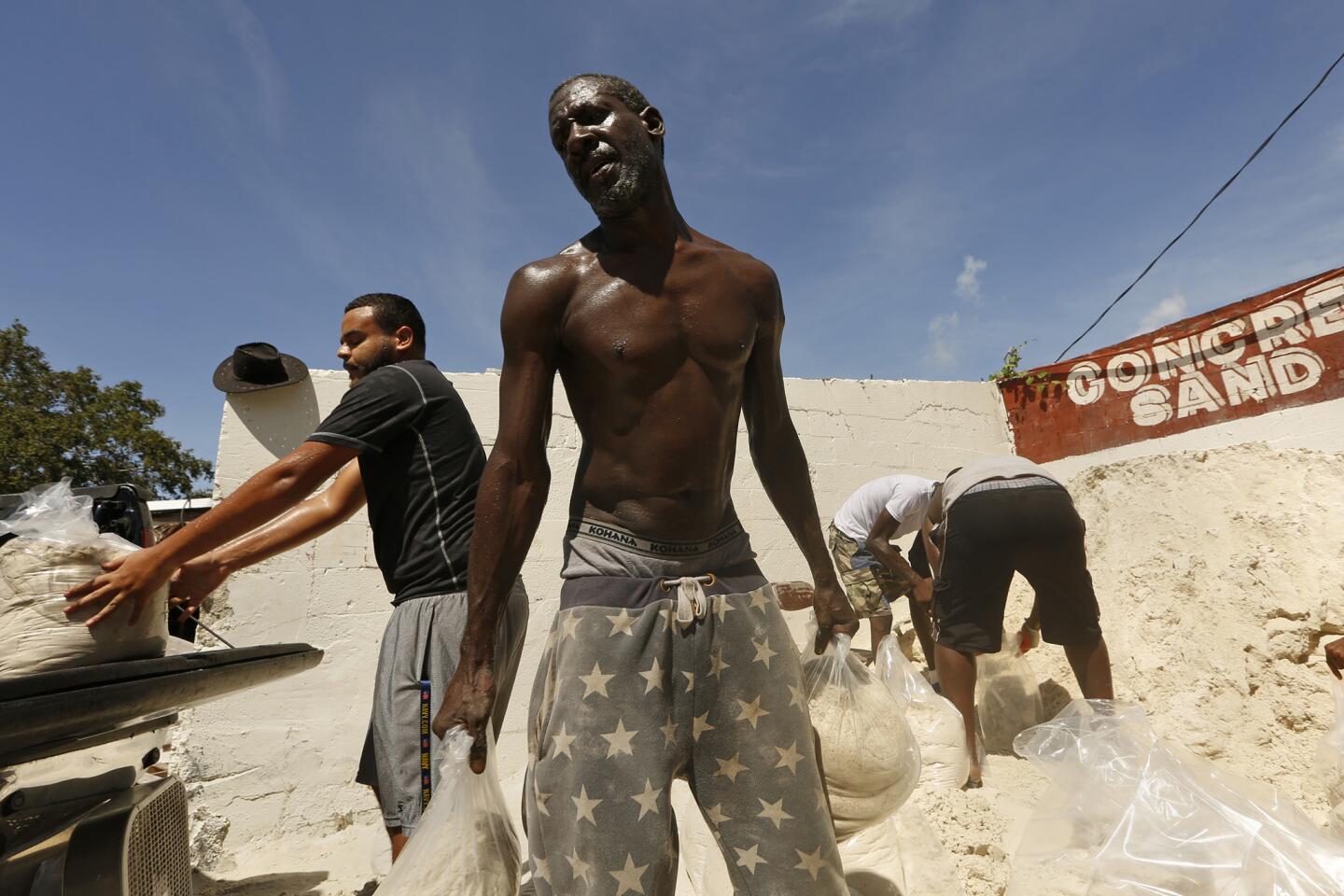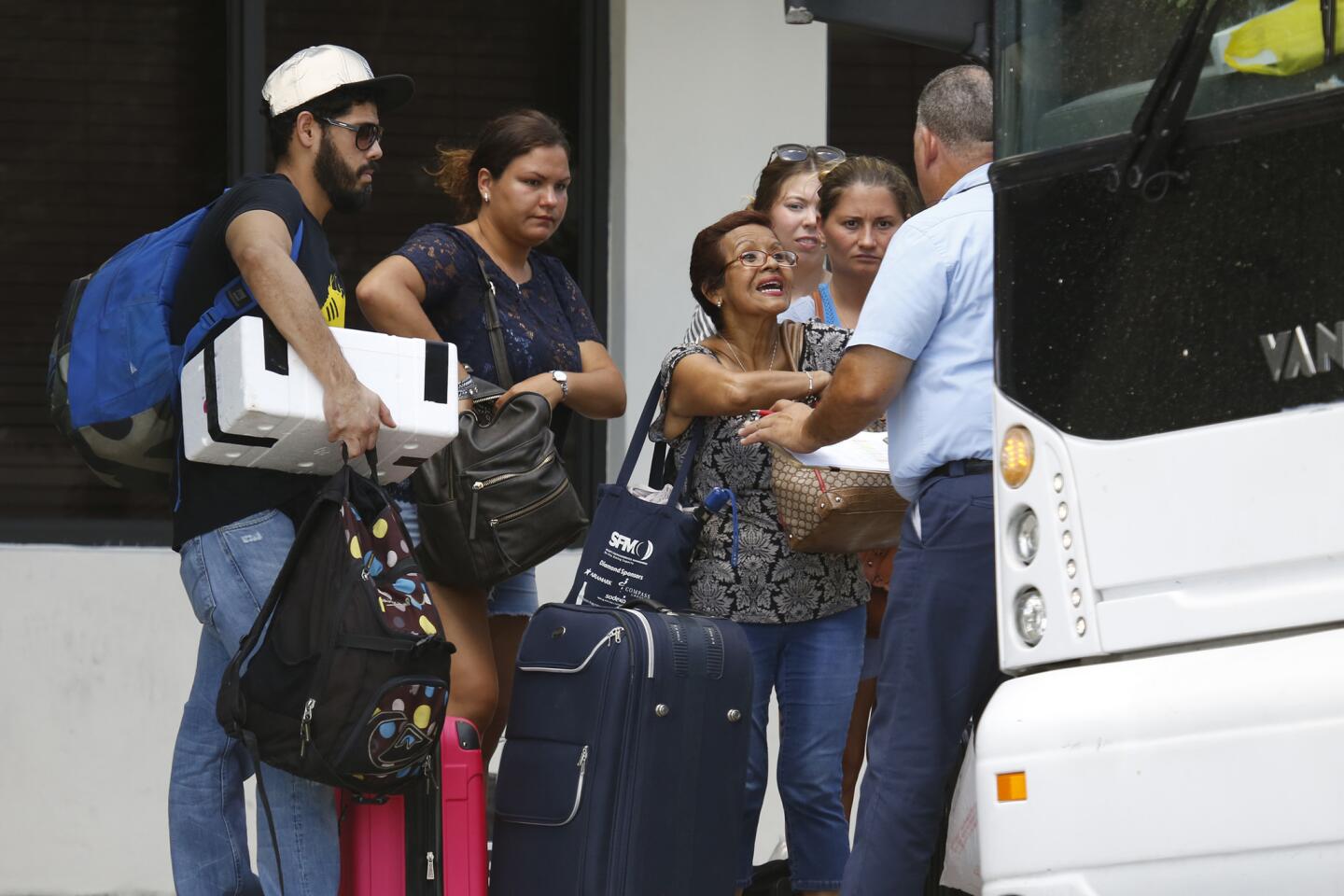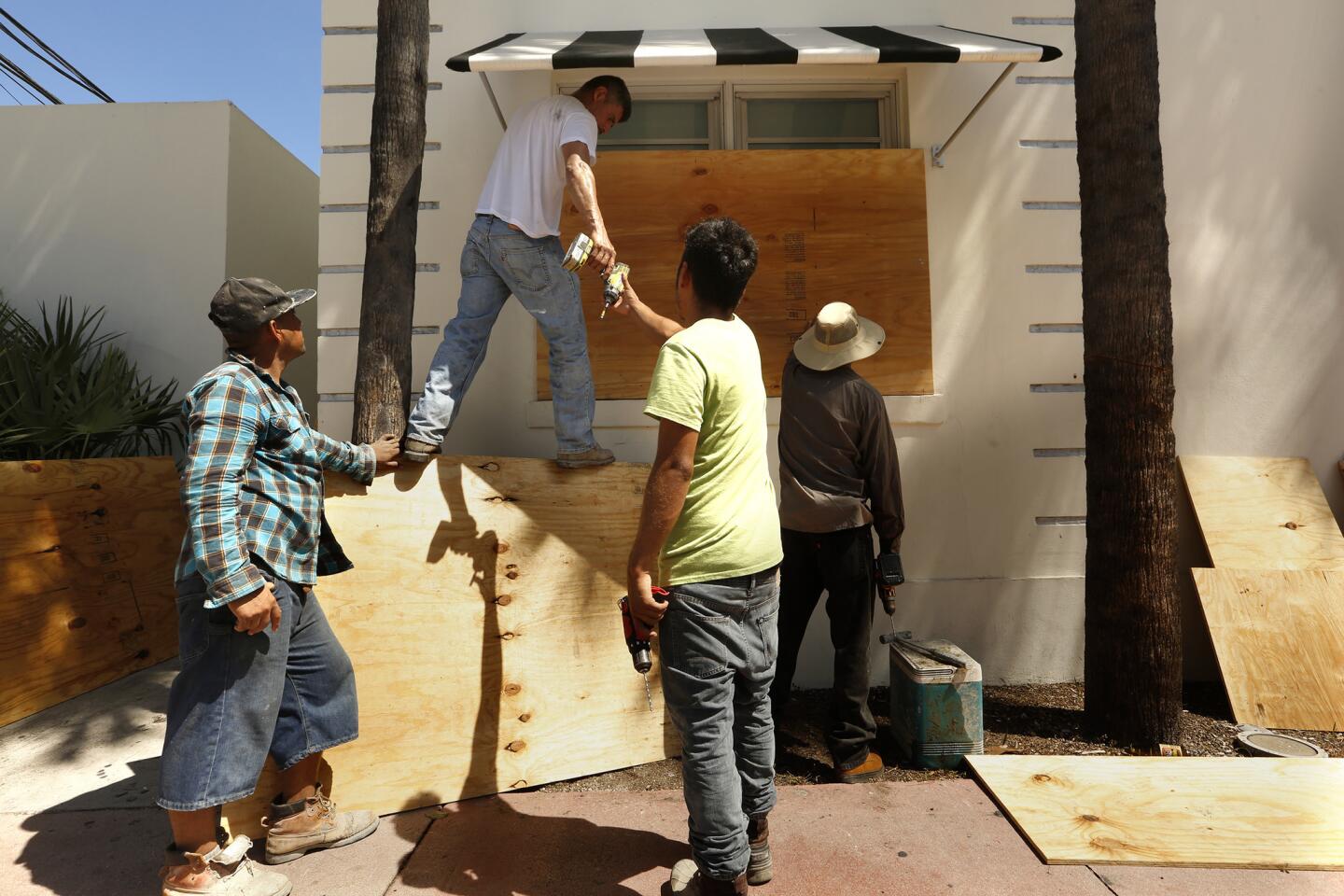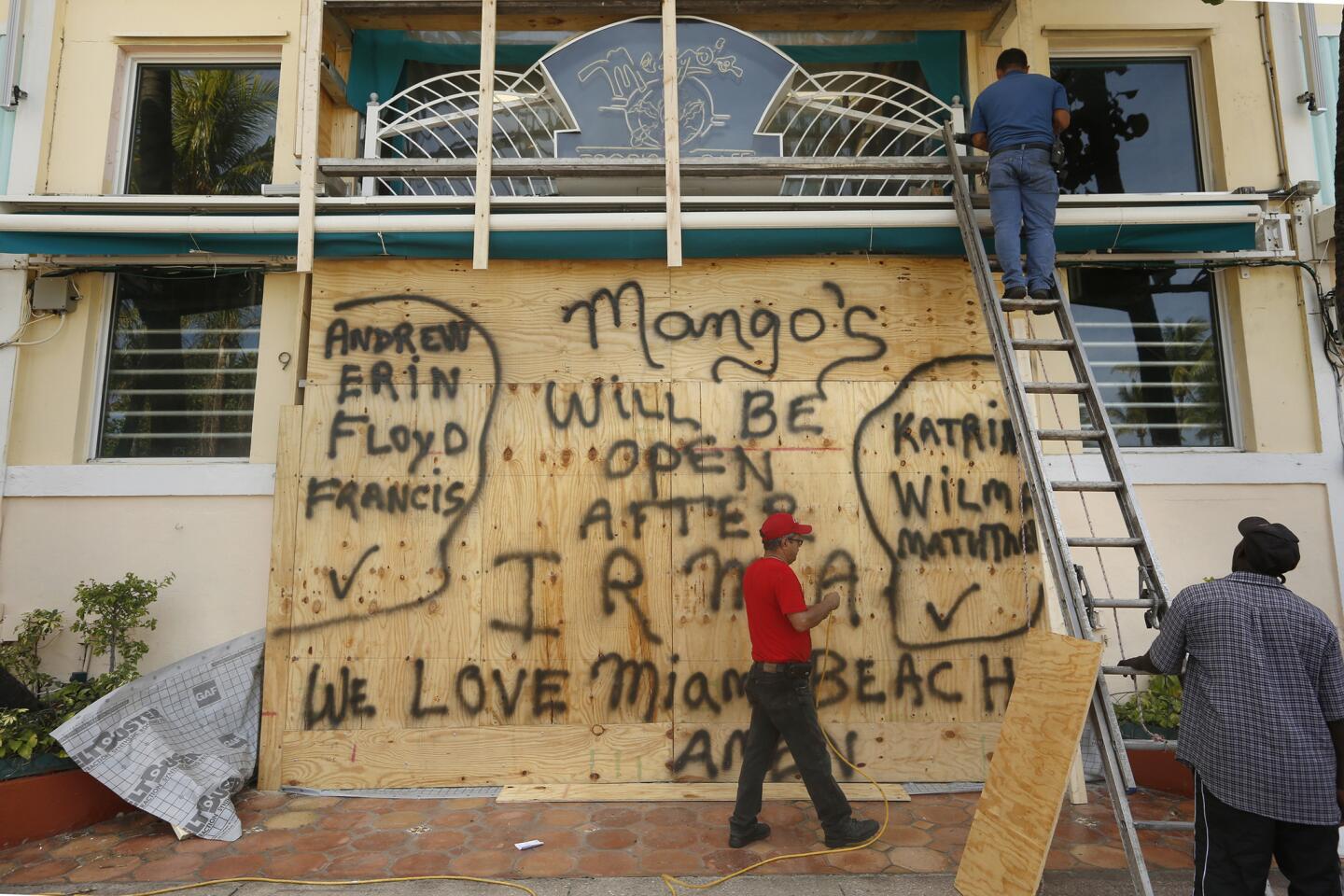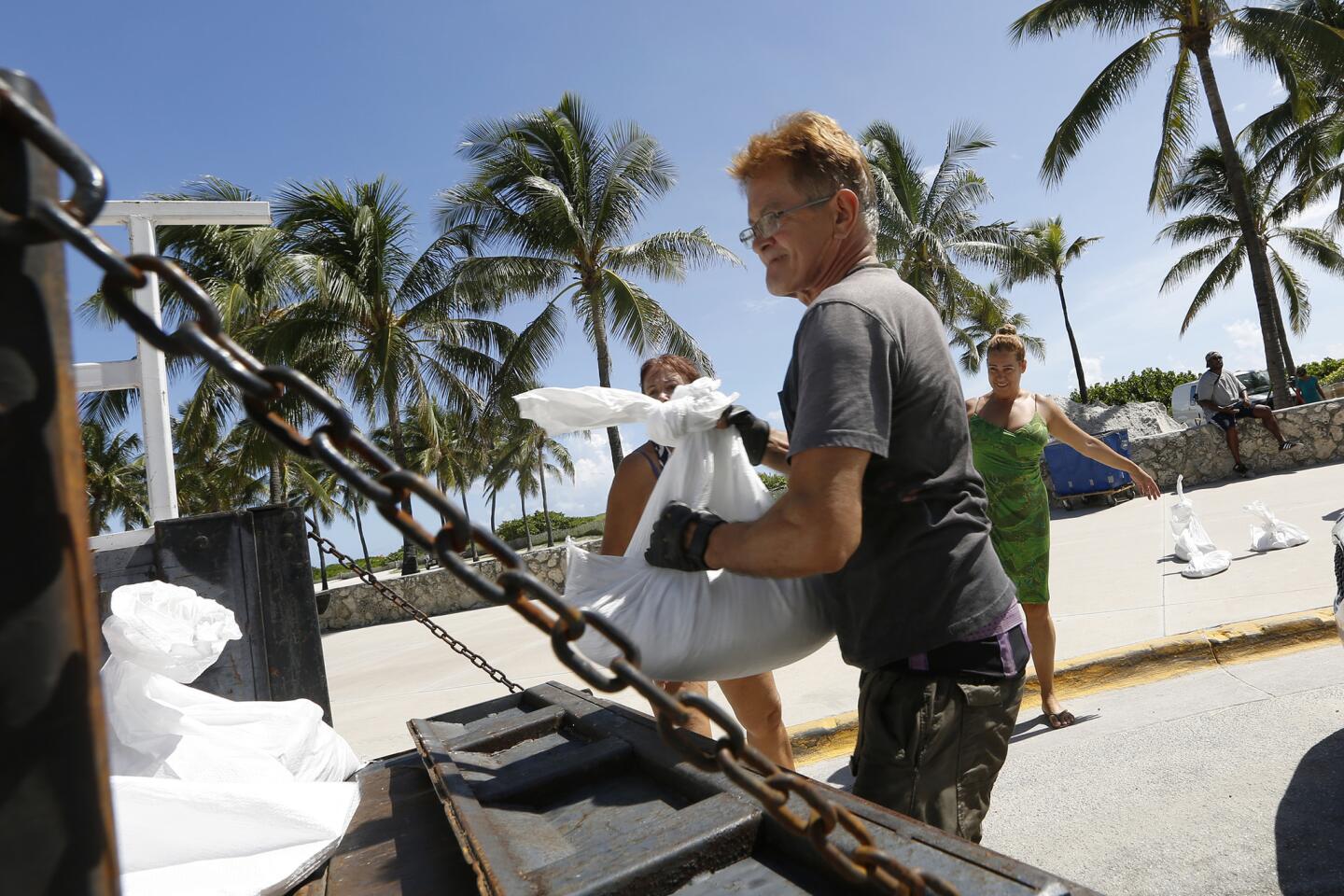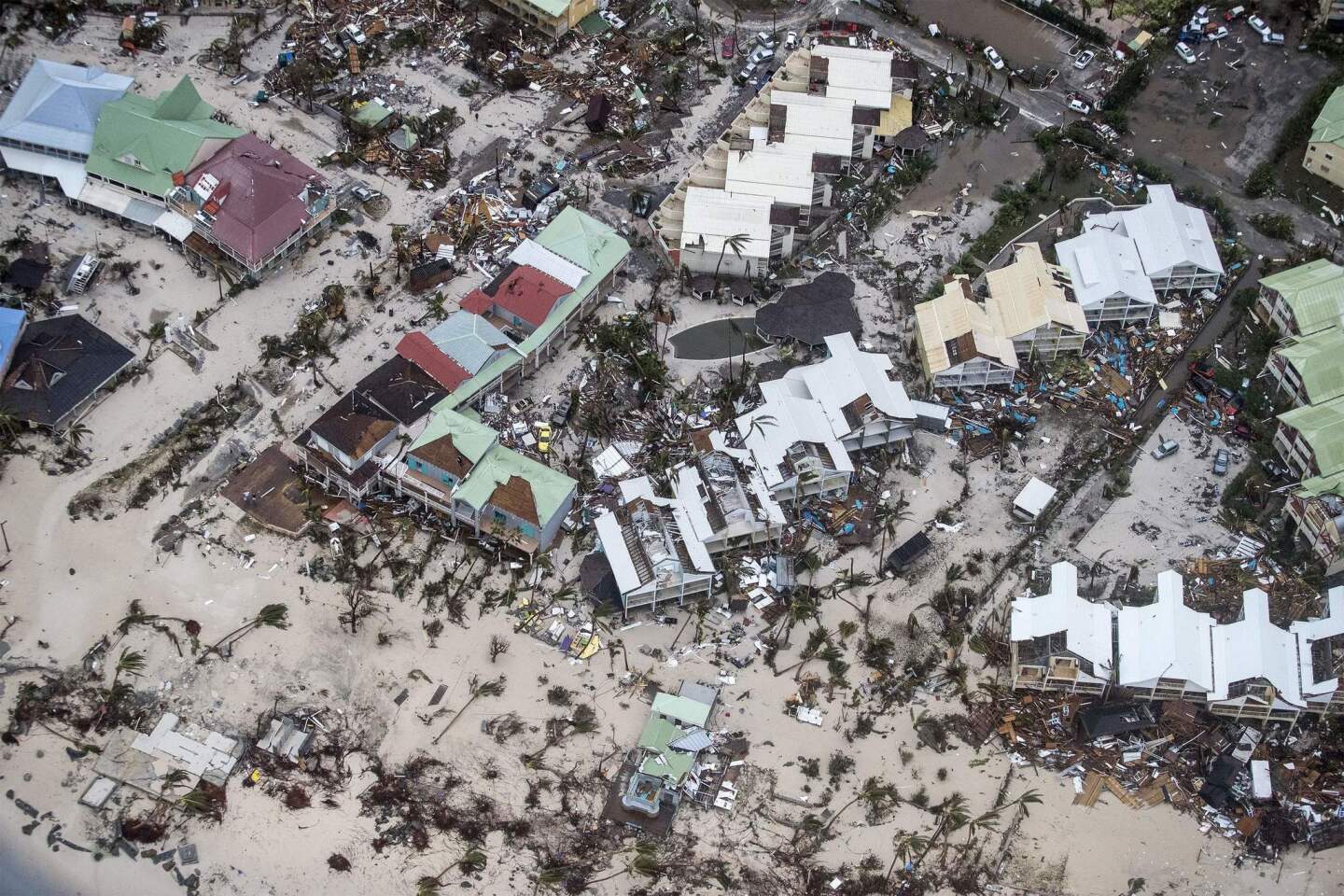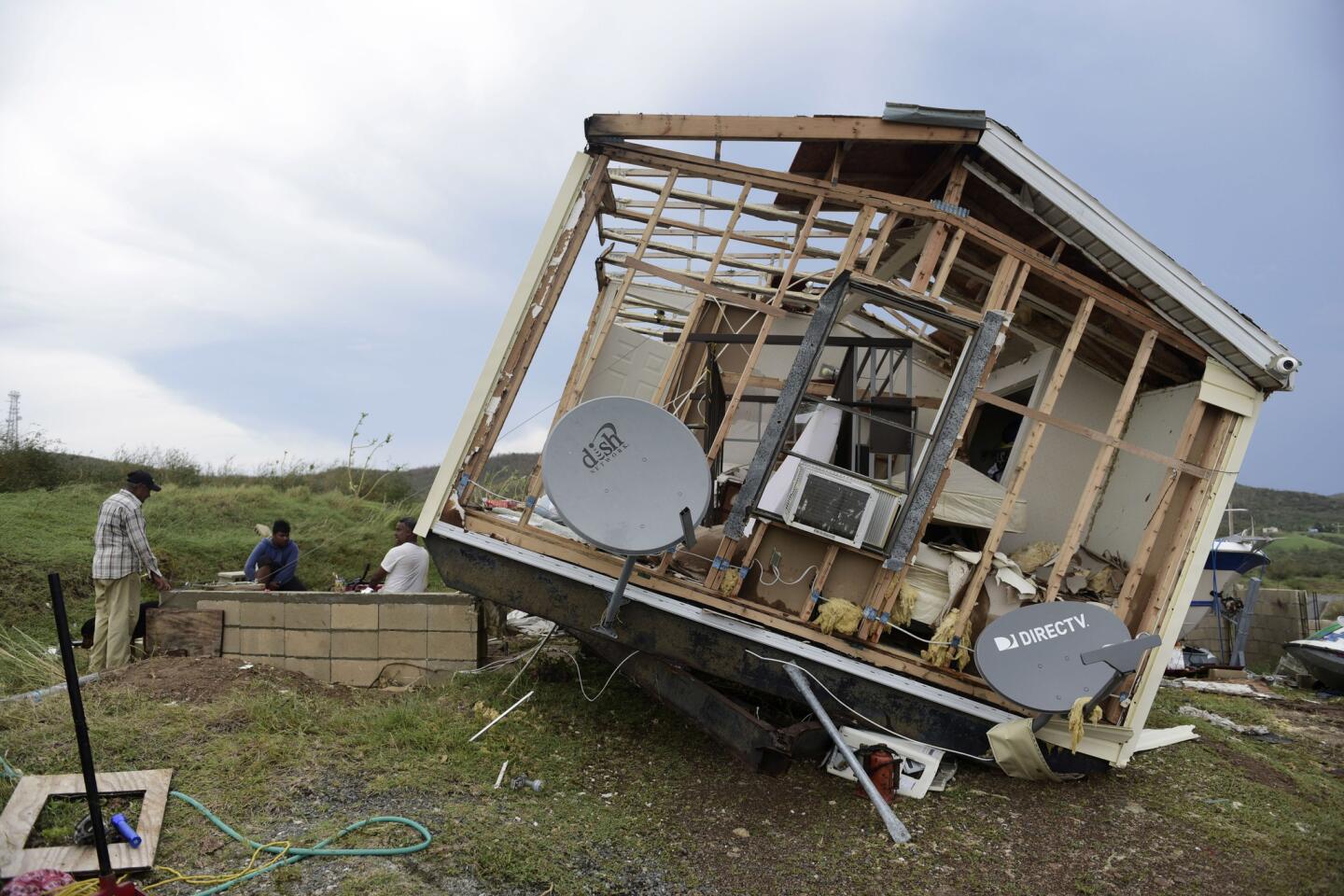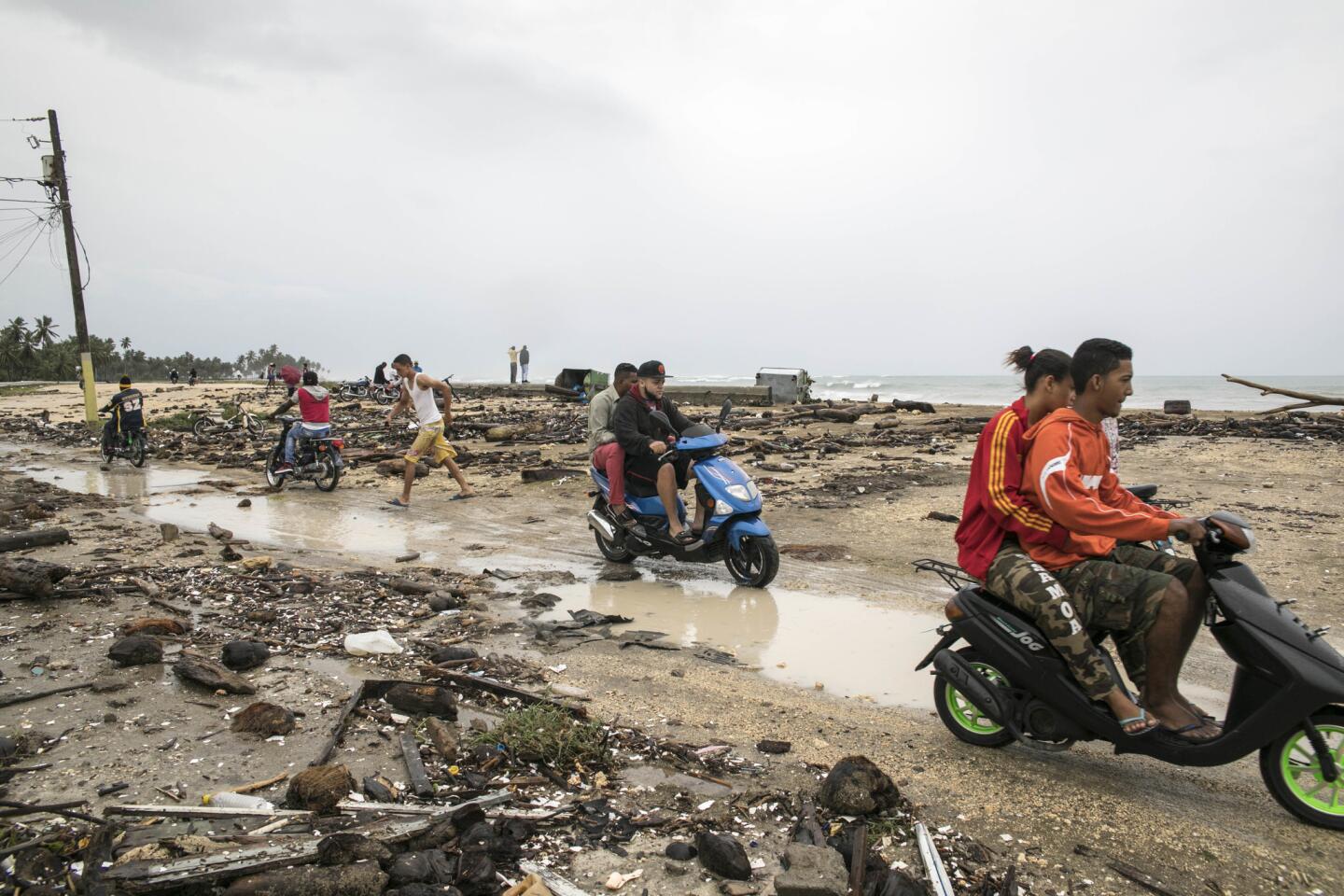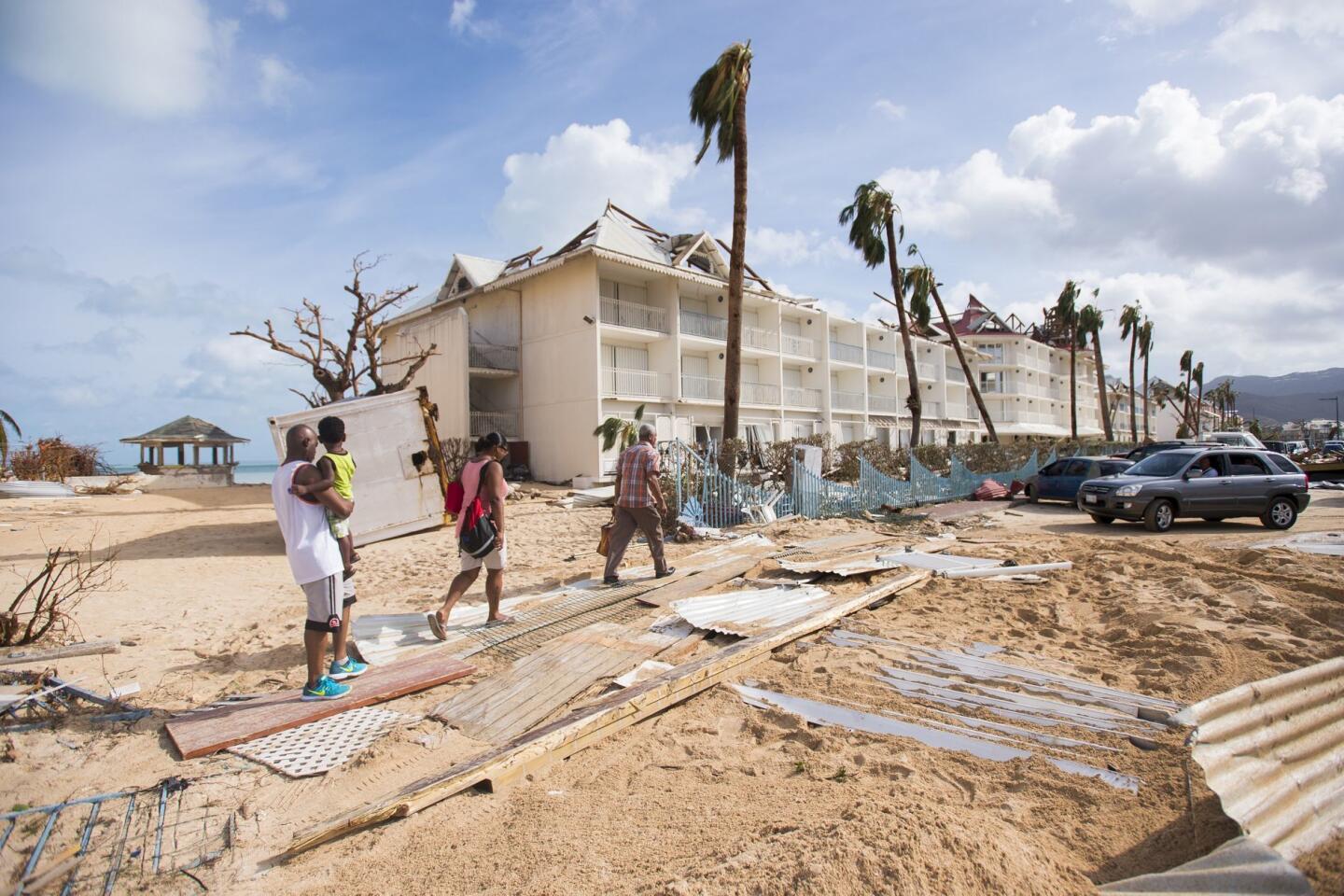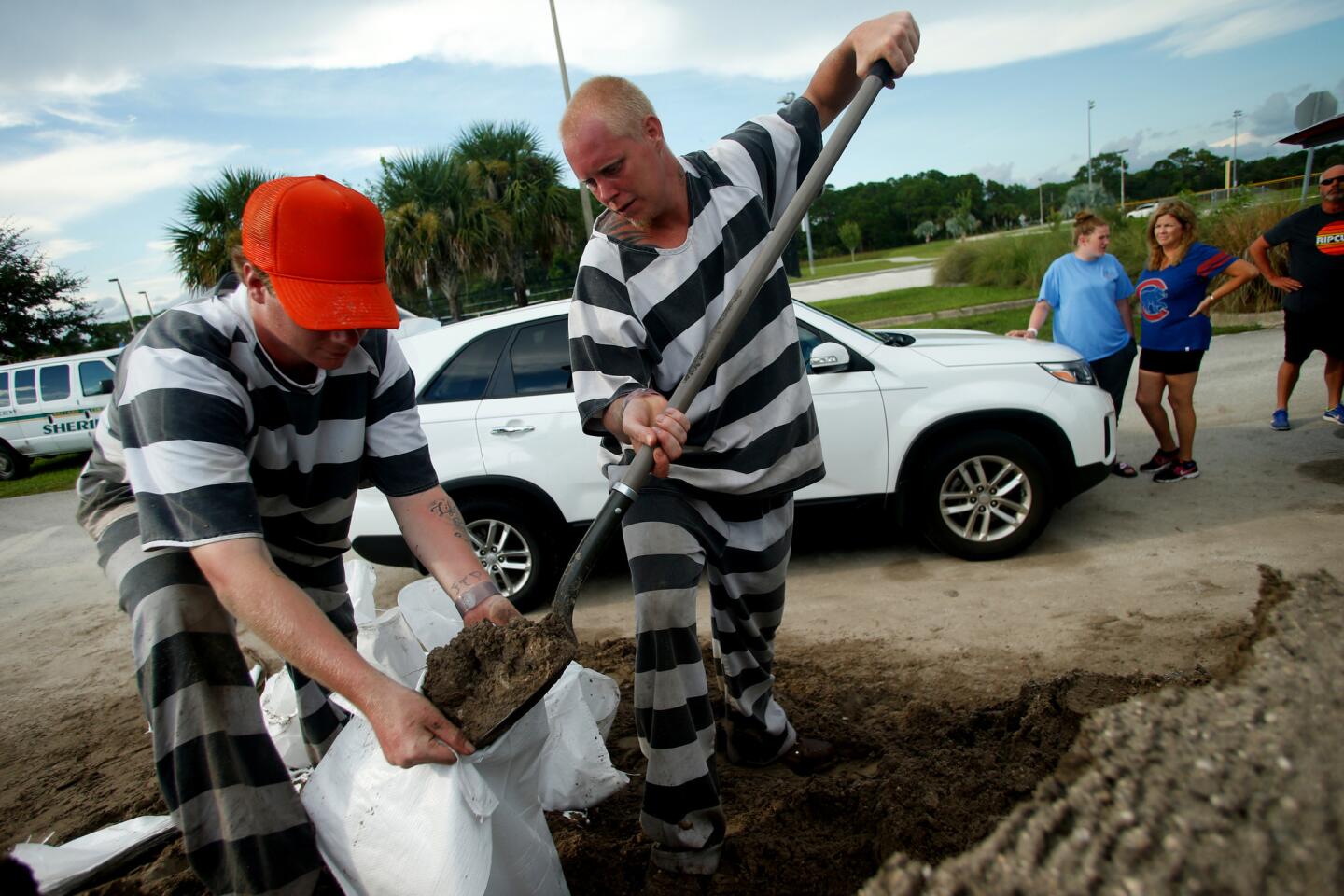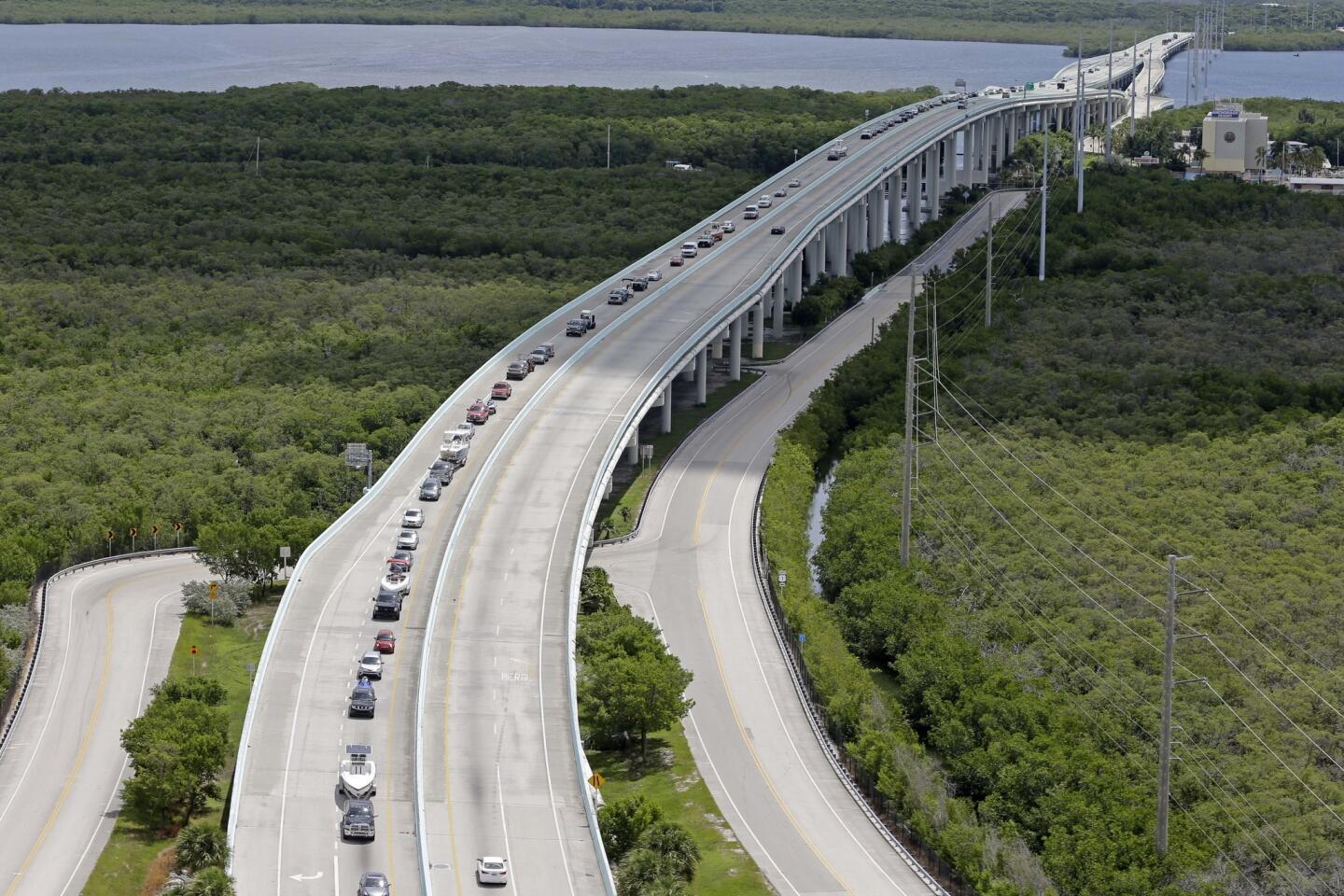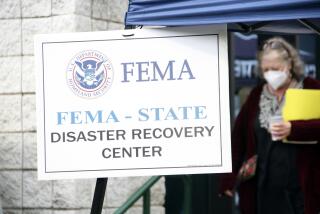Reporting from Naples, Fla. — During a hurricane in 1900, a storm surge rose out of the Gulf of Mexico and annihilated Galveston, Texas, killing about 8,000 men, women and children.
In 1935, at least 408 people died when another cyclone slammed into the Florida Keys, many of them World War I veterans working on construction projects.
And in 1957, Hurricane Audrey’s storm surges crashed into the coasts of Texas and Louisiana, killing 390 people.
Hurricane Irma, which slammed into Florida over the weekend, was in a similar league as those storms in its sheer power, and the number of people living in vulnerable areas has only grown.
So how has the number of deaths — in Florida, Georgia and South Carolina as of Monday night — remained in single digits?
The answer is the modern science of hurricane monitoring and preparation, which has saved countless lives as forecasting, satellite monitoring and government planning have dramatically improved in recent decades.
One study in the journal Epidemiologic Reviews calculated that America suffered an average of 1,400 hurricane deaths per decade from 1910 to 1939, 700 deaths per decade from 1940 to 1969, and about 250 deaths per decade from 1970 to 1999.
“The number of people killed in hurricanes halves about every 25 years, in spite of the fact that coastal populations have been increasing, because of what we’re doing with forecasting,” said Hugh Willoughby, a professor of meteorology at Florida International University in Miami.
The National Oceanic and Atmospheric Administration’s errors in storm tracking have been cut in half in the last dozen years, giving residents 36 total hours of advance notice that a hurricane is expected, up from 24 hours five years ago, he said.
With Irma, he said, “The emergency response at all levels of state government was really, really good. They did the right things, they said the right things. They gave people good advice and they didn’t minimize the threat.”
Irma was one of the most powerful storms to ever crawl out of the Atlantic.
After ripping through Caribbean islands with Category 5 winds, killing at least 37 people, it weakened slightly as it took direct aim at Florida, whose explosive real estate development in recent decades has made it the nation’s third-most-populous state.
Florida was slammed with huge storm surges, violent winds and heavy rains that socked the peninsula from south to north, flooding towns and knocking out power to millions of people.
But the most shocking thing about Irma may be what it didn’t do: kill in large numbers.
The greatest threat from a hurricane comes not from its winds, but from its surges of ocean waters that flood shorelines, leaving survivors in buildings little way to escape. A 2014 National Hurricane Center study estimated that 90% of American hurricane deaths were somehow water-related, mostly drownings. Between 5% and 10% of deaths were due to winds, not counting tornadoes.
The survival lesson is clear: Get people away from flood-prone areas.
All along the state’s Gulf and Atlantic coasts, people heeded forecasters’ predictions and government orders and evacuated before the danger hit.
“This was an extraordinary event, and in some places we got surges far more than predicted,” said Heather Carruthers, who left her home in the Florida Keys and took her family to the relative safety of Orlando. Parts of the island chain were hammered by several feet of dangerous storm surge.
“When they were looking at a storm of this size, as well as its intensity, we knew it was not something that you gamble with,” said Carruthers, a Monroe County commissioner. “This is one you get out of the way for. We think we made the right call.”
Richard Olson, director of the International Hurricane Research Center at Florida International University, said authorities had gotten much better at making the danger clear to the public. “There’s been real clarity on ‘get the hell out of Dodge,’ ” he said.
In modern times, when hurricane deaths come, it’s often “in areas with flooding that nobody was expecting,” Olson said.
The most recent example is last month’s Hurricane Harvey, which dumped several feet of rain over parts of Texas and killed at least 70 people, mostly in flooding.
In Hurricane Katrina, which ravaged New Orleans in 2005 and remains America’s deadliest storm in decades, one mortality study found that many of the 1,170 or more victims died in flooding near where the storm breached man-made levees.
The previous most ruinous storm to hit Florida was Hurricane Andrew in 1992, which destroyed tens of thousands of homes. Many of the 30 or so people who died around Miami — the area hardest hit — were crushed in collapsed buildings or mobile homes, while most of the rest suffered heart attacks and other medical incidents in the two weeks after the storm.
The death toll made little sense to some residents, who imagined “anywhere from tens to hundreds or thousands of victims buried in and under debris,” or spun conspiracy theories about “the existence of mass graves, secret morgues, and the clandestine removal of dead bodies by refrigerated trucks or military trains by night,” one post-storm report noted in the Journal of Forensic Sciences.
And when the rumors couldn’t be confirmed, “some alleged that the government, Medical Examiner Department and news media were participating in a massive coverup to allay the fears of the public in an effort to protect the tourist industry,” the report said.
1/79
Trailer homes at the Sea Breeze trailer park in the Florida Keys town of Islamorada were destroyed by Irma.
(Marcus Yam / Los Angeles Times) 2/79
Tom Ross inspects the damage to his three-story condominium building in Islamorada.
(Marcus Yam / Los Angeles Times) 3/79
The remains of a boat in Islamorada.
(Marcus Yam / Los Angeles Times) 4/79
Brooke Gilbert, 15, and her father, Mike Gilbert, look at the ruins of her grandparents’ condominium building in Islamorada.
(Marcus Yam / Los Angeles Times) 5/79
Laura Gilbert retrieves the mailbox from her father’s condominium in Islamorada after it was swept away during the storm.
(Marcus Yam / Los Angeles Times) 6/79
Sand and debris block access to trailer homes in Islamorada.
(Marcus Yam / Los Angeles Times) 7/79
Greg Garner embraces neighbor Linda Nettles in front of his longtime family home that lost part of its roof after Tropical Storm Irma hit Sullivan’s Island, S.C.
(Mic Smith / Associated Press) 8/79
Israel Alvarado, 25, tries to open a gate blocked by fallen tree branches to retrieve a generator in Bonita Springs.
(Carolyn Cole / Los Angeles Times) 9/79
Rescue workers help a couple evacuate their flooded home in Jacksonville.
(John Raoux / Associated Press) 10/79
Charlotte Glaze, left gives Donna Lamb a hug as she floats out some of her belongings in floodwaters in Jacksonville,.
(Dede Smith / Associated Press) 11/79
Ron Colby, 70, leaves his flooded Bonita Springs home after staying during Hurricane Irma. He said he was OK with the wind but that at 3:30 in the morning the water started to rise.
(Carolyn Cole / Los Angeles Times) 12/79
A dresser floats by Gilberto Diaz in his Bonita Springs neighborhood. Originally from Guatemala, Diaz has lived in Florida since 1994.
(Carolyn Cole / Los Angeles Times) 13/79
In Bonita Springs, floodwaters reached waist deep in some areas on Monday, flooding homes and cars.
(Carolyn Cole / Los Angeles Times) 14/79
A block from the ocean in Naples, the water was still a foot deep from storm surge. Homeowner Terry Clontz put up a “no wake” sign because people were driving by too fast, pushing water farther onto his property.
(Carolyn Cole / Los Angeles Times) 15/79
Floodwaters surround a marina in Key Largo on Monday following Hurricane Irma.
(Wilfredo Lee / Associated Press) 16/79
Mobile homes in Key Largo, Fla., lie in ruins on Monday after Hurricane Irma.
(Wilfredo Lee / Associated Press) 17/79
Floodwaters surround Gilbert’s Resort in Key Largo on Monday.
(Wilfredo Lee / Associated Press) 18/79
Kelly McClenthen returns to see the flood damage to her home with her boyfriend, Daniel Harrison, in the aftermath of Hurricane Irma in Bonita Springs, Fla.
(Gerald Herbert / Associated Press) 19/79
Terry Thompson is relieved. He rode out the storm in his home in Riverwood Estates in Naples. Although the Naples area of Florida was hit hard by Hurricane Irma, damage wasn’t nearly as bad as anticipated.
(Carolyn Cole / Los Angeles Times) 20/79
A woman leaves her flooded home the morning after Hurricane Irma swept through the area in Fort Myers, Florida.
(Spencer Platt / Getty Images) 21/79
People tend to a car that flipped over on Cape Coral Parkway during Hurricane Irma, in Cape Coral.
(Gerald Herbert / AP) 22/79
A man clears the drain next to his house in Estero, Fla., during the lull in winds as the eye of the hurricane passes over.
(Carolyn Cole / Los Angeles Times) 23/79
Evacuees use flashlights so others can maneuver around the stairway at Hampton Inn and Suites in Estero, Fla.
(Carolyn Cole / Los Angeles Times) 24/79
Guests gather in the lobby of Hampton Inn and Suites in Estero, Fla., to watch the hurricane gusts.
(Carolyn Cole / Los Angeles Times) 25/79
Darla Talia Ferro, 40, and her two parakeets ride out Hurricane Irma in the lobby of Hampton Inn and Suites in Estero, Fla.
(Carolyn Cole / Los Angeles Times) 26/79
John Krowzow, 74, wades in floodwater to check out his homes in Corkscrew Woodlands, a park with 640 senior mobile home units in Estero, Fla.
(Carolyn Cole / Los Angeles Times) 27/79
Peter Moodley wades through floodwater in downtown Miami.
(Marcus Yam / Los Angeles Times) 28/79
Two men walk through a downed tree as Hurricane Irma’s full force strikes Miami.
(Marcus Yam / Los Angeles Times) 29/79
A woman films the damage from a house whose roof was blown off near downtown Miami.
(Marcus Yam / Los Angeles Times) 30/79
A vehicle drives through debris caused by Hurricane Irma, in Miami.
(Marcus Yam / Los Angeles Times) 31/79
Weather reporters in downtown Miami jump and cling on to illustrate the force of the winds caused by Hurricane Irma.
(Marcus Yam / Los Angeles Times) 32/79
Weather reporters do a stand-up as the force of the winds caused by Hurricane Irma hit Miami.
(Marcus Yam / Los Angeles Times) 33/79
A cargo truck is tipped over by the wind caused by Hurricane Irma in Miami.
(Marcus Yam / Los Angeles Times) 34/79
Storm surge floods the Brickell neighborhood of Miami.
(Marcus Yam / Los Angeles Times) 35/79
Streets are empty in downtown Miami as the wind picks up speed during Hurricane Irma’s approach.
(Marcus Yam / Los Angeles Times) 36/79
Maria Koenig, 63, of Estero, Fla., and her dog, Baeley, sit by the window at their Estero hotel so Maria can keep an eye on the storm on Sunday.
(Carolyn Cole / Los Angeles Times) 37/79
Glen Sinatra, 69, from Naples, says he feels lucky to be at a hotel in Estero instead of a shelter. He’s nervous about the storm and says he’s trying not to worry his children about the conditions.
(Carolyn Cole / Los Angeles Times) 38/79
Jimmy Alfano, of Ft. Myers, holds onto Alec Hoskins who is autistic, while watching the storm gusts through the window of their Estero hotel with Frank Pairs.
(Carolyn Cole / Los Angeles Times) 39/79
A car sits abandoned in storm surge along North Fort Lauderdale Beach Boulevard as Hurricane Irma hits the southern part of the state.
(Chip Somodevilla / Getty Images) 40/79
The metal canopy at a gasoline station is overturned by high winds brought on by Hurricane Irma.
(Wilfredo Lee / Associated Press) 41/79
Youssef Ezzou, left, and Fadel Beznbachir roam outside to check out the conditions in Miami as Hurricane Irma nears the mainland.
(Marcus Yam / Los Angeles Times) 42/79
A construction crane whose arm broke off towers over a building as high wind blows through downtown Miami on Sunday.
(Marcus Yam / Los Angeles Times) 43/79
A man and woman run to safety in Miami as winds from Hurricane Irma bear down on Sunday.
(Marcus Yam / Los Angeles Times) 44/79
Storefronts in Miami are damaged as Hurricane Irma’s winds hit Miami.
(Marcus Yam / Los Angeles Times) 45/79
Dustin Terkoski, Palm Bay Police officer surveys the scene after a possible tornado touched down at Palm Pam Bay Estates.
(Red Huber / Orlando Sentinel) 46/79
A man braces against the wind by the Miami River on Sunday as water levels surge.
(Marcus Yam / Los Angeles Times) 47/79
A man stands by the Miami River as the water level surges on Sunday.
(Marcus Yam / Los Angeles Times) 48/79
The waves on the Miami River begin to surge Sunday as winds pick up speed upon Hurricane Irma’s approach.
(Marcus Yam / Los Angeles Times) 49/79
Brian Williams, of Maryland, fights the winds in downtown Fort Myers.
(Carolyn Cole / Los Angeles Times) 50/79
Trees fall as winds pick up speed early Sunday as Hurricane Irma approaches Miami.
(Marcus Yam / Los Angeles Times) 51/79
A TV reporter braces against the wind as Hurricane Irma approaches Miami.
(Marcus Yam / Los Angeles Times) 52/79
The outer bands of Hurricane Irma start to reach Florida on Saturday, with clouds over the Miami skyline.
(Joe Raedle / Getty Images ) 53/79
People wade through a flooded street in Havana after Hurricane Irma battered central Cuba.
(YAMIL LAGE / AFP/Getty Images) 54/79
Thousands wait Saturday to enter a storm shelter set up at Germain Arena in Estero, Fla., south of Fort Myers.
(Carolyn Cole / Los Angeles Times) 55/79
Jean Turner, 79, waits to get into a shelter with a few of her belongings as rain begins to fall Saturday in Estero, Fla.
(Carolyn Cole / Los Angeles Times) 56/79
Sherri Bourdo, 32, and Anthony Guidry, 40, look out over the water in Naples, Fla, in advance of the arrival of Hurricane Irma.
(Carolyn Cole / Los Angeles Times) 57/79
Lisette Toroella and Tatiana Morera play on the beach as storm clouds approach in Miami Beach.
(Marcus Yam / Los Angeles Times) 58/79
Adam Todd, does a handstand while skateboarding down a virtually empty Ocean Drive in Miami Beach.
(Marcus Yam / Los Angeles Times) 59/79
Abby Jenkins walks against the wind with her luggage and umbrella to get to safety, in Miami Beach.
(Marcus Yam / Los Angeles Times) 60/79
James Sampero surfs in the churning ocean as Hurricane Irma approaches.
(Joe Raedle / Getty Images) 61/79
Cubans wade through the rubble from a collapsed building in Havana on Saturday.
(Yamil Lage / AFP/Getty Images) 62/79
A woman and child use a blanket as protection from wind and rain as they walk in Caibarien, Cuba. Hurricane Irma battered Cuba on Saturday with deafening winds and unremitting rain, pushing seawater inland and flooding homes before turning toward Florida.
(Desmond Boylan / Associated Press) 63/79
Annette Davis plays with her son Darius, 3, while staying at a shelter in Miami on Saturday after evacuating from their home in Florida City ahead of Hurricane Irma.
(David Goldman / Associated Press) 64/79
Residents walk through rain brought on by Hurricane Irma in Caibarien, Cuba. The powerful storm battered Cuba on Saturday and continued its march toward Florida.
(Desmond Boylan / Associated Press) 65/79
Palmetto Ridge High School is a shelter for people with special needs near Naples, Fla. Many seniors plan to ride out the storm there.
(Carolyn Cole / Los Angeles Times) 66/79
Francesca DeLuca, age 20, will be waiting for 10 hours for her flight back to Milan, Italy. She had been visiting a friend in Miami by herself, but the area where she was staying is under mandatory evacuation. At Miami International Airport, the last flights will be this afternoon with the airport closing tonight at 6pm. Most travelers are taking flights to anywhere they can find.
(Carolyn Cole / Los Angeles Times) 67/79
Boats that can’t be evacuated are tied off in canals to protect them from Hurricane Irma on in Key Largo, Florida. The entire Florida Keys are under a mandatory evacuation notice as Hurricane Irma approaches the low-lying chain of islands south of Miami.
(Marc Serota / Getty Images) 68/79
Hundreds wait in line on Friday at Home Depot in Miami to get supplies line sheets of plywood, and anything else they can find, to board up their homes. Police were on the scene to keep things orderly.
(Carolyn Cole / Los Angeles Times) 69/79
In the Little Haiti neighborhood of Miami, Fritz Drinks, whose family is from Haiti, helps load sandbags at Little Haiti Hardware and Lumber. Many people in the area are refusing to evacuate in advance of Hurricane Irma.
(Carolyn Cole / Los Angeles Times) 70/79
In downtowm Miaimi, people wait to get on a bus headed to Orlando under a mandatory evacution plan. Preparations are underway for Hurricane Irma as the storm makes its way toward Florida.
(Carolyn Cole / Los Angeles Times) 71/79
Stores are boarded up in Miami Beach in advance of Hurricane Irma.
(Carolyn Cole / Los Angeles Times) 72/79
Preparations for Hurricane Irma are underway in Miami Beach as the storm makes its way toward Florida.
(Carolyn Cole / Los Angeles Times) 73/79
Genaro Dacosta, 65, of Miami Beach loads sandbags in advance of Hurricane Irma. He says he can’t evacuate the area because he has a monkey.
(Carolyn Cole / Los Angeles Times) 74/79
An aerial photograph taken and released by the Dutch Department of Defense on Wednesday shows damage from Hurricane Irma in Philipsburg, St. Maarten.
(Gerben van Es / AFP/Getty Images) 75/79
Juan Negron, third from left, prepares to start up a power generator in front of what’s left of his damaged property in Culebra, Puerto Rico, after the passage of Hurricane Irma.
(Carlos Giusti / Associated Press) 76/79
Residents come out to survey the damage caused by Hurricane Irma in Nagua, Dominican Republic.
(Tatiana Fernandez / Associated Press) 77/79
People on Thursday look over damage from Hurricane Irma on a sand-covered street of Marigot, near the Bay of Nettle, on the island of St. Maarten.
(Lionel Chamoiseau / AFP/Getty Images) 78/79
Inmate trustees from the Brevard County Jail fill sandbags for Meritt Island, Fla., residents in advance of Hurricane Irma.
(Brian Blanco / Getty Images) 79/79
Motorists leave Key Largo, Fla., ahead of Hurricane Irma.
(Alan Diaz / Associated Press) Hurricane Andrew nonetheless prompted the state to overhaul its building codes to prepare for the next storm.
Leslie Chapman-Henderson, head of Federal Alliance for Safe Homes, a nonprofit formed in 1998, said all of the group’s original recommendations had “long since been adopted in the minimum standards” for construction in Florida.
In the weeks and months ahead, experts will examine how buildings built with those standards held up. Some residents felt confident.
James Burke, 61, had no idea what would happen to his home in Naples in southwest Florida during the hurricane. The forecasts and dire warnings had him in a panic. Could it stand up to 100-mph winds?
After briefly checking out a shelter, Burke and his family returned to their home and nervously hunkered down. As the storm picked up, it became clear the house was holding its own. He even went out on his lanai to watch trees fall. “It was pretty intense, but we never felt endangered,” Burke said.
For now, Chapman-Henderson sounded more worried about the behavior of homeowners than the safety of the homes they were living in.
It’s now common for much of a hurricane’s death toll in America to come after the storm, sometimes in auto accidents in unsafe driving conditions, carbon monoxide poisonings involving generators improperly used indoors, and electrocutions by exposed power lines.
“If you’ve never used a chainsaw before, right now is not the time to learn,” Chapman-Henderson said. Survivors might be “exhausted and stressed out, and not using a generator correctly. We lose people that way as well because carbon monoxide doesn’t have a scent to it.”
Jean-Pierre Bardet, dean of the University of Miami’s college of engineering, said he was impressed with the communication from government officials about evacuating danger zones.
But with all the forecasts, all the satellite imaging, all the analyses, Bardet still wasn’t satisfied. He noted that the storm was initially projected to hit southeast Florida, not southwest Florida.
“It would be great in the future,” Bardet said, “if we had some more certainty.”
A day after Hurricane Irma made landfall near here in what forecasters warned would be one of the most destructive storms ever to hit Florida, the pretty little seaside town of Naples, near ground zero of the Category 3 storm’s approach, found itsel
Pearce reported from Los Angeles, Hennessy-Fiske from Houston and Halper from Naples, Fla.
[email protected]
Matt Pearce is a national reporter for The Times. Follow him on Twitter at @mattdpearce.
More national headlines
ALSO
A windy night among strangers — human, canine and otherwise — as Hurricane Irma blows through
The incredible stories of the die-hards who looked Irma in the face — and stayed
Storm surge: What happens when the sea rises up during a hurricane?


